Sinar Photography S3045 Digital Camera Back User Manual Manual
Sinar Photography AG Digital Camera Back Manual
Manual
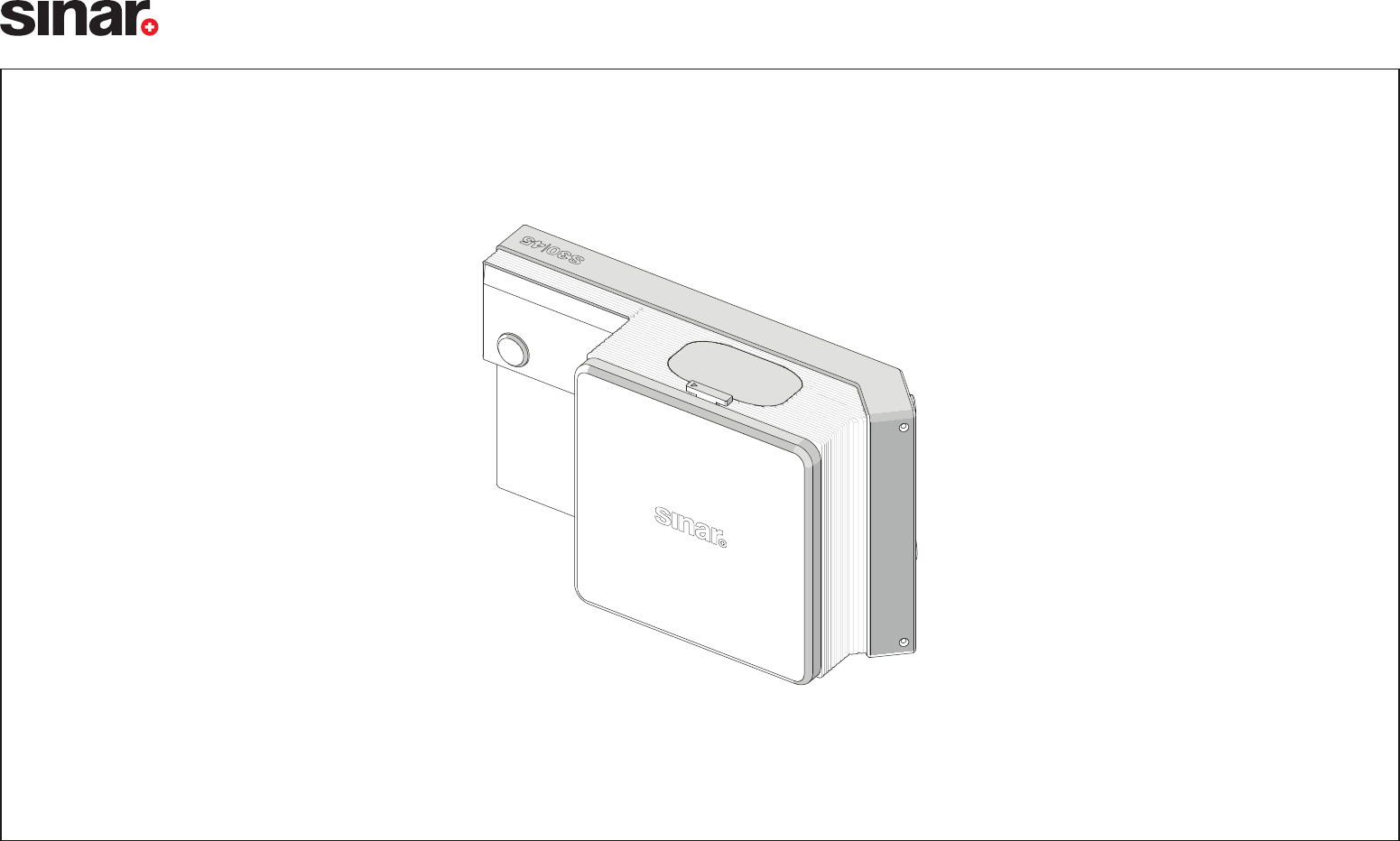
Sinarback S 30|45
Mobile and Versatile
Sinar Photography AG
We do everything for the perfect picture
Manual

FCC Note:
This equipment has been tested and found to comply with the limits
for a Class B digital device, pursuant to Part 15 of the FCC Rules.
These limits are designed to provide reasonable protection against
harmful interference in a residential installation. This equipment
generates, uses, and can radiate radio frequency energy and, if not
installed and used in accordance with the instructions, may cause
harmful interference to radio communications. However, there is no
guarantee that interference will not occur in a particular installation. If
this equipment does cause harmful interference to radio or television
reception, which can be determined by turning the equipment o and
on, the user is encouraged to try to correct the interference by one or
more of the following measures:
• Reorient or relocate the receiving antenna.
Increase the separation between the equipment and receiver.
• Connect the equipment into an outlet on a circuit different from
that to which the receiver is connected.
• Consult the dealer or an experienced radio/TV technician for help.
FCC Caution:
To assure continued compliance, follow the attached installation
instructions and use only shielded interface cables with ferrite core
when connecting to computer or peripheral devices. Any changes
or modifications not expressly approved by the party responsible
for compliance could void the user’s authority to operate this equip-
ment.
Trade Name: Sinar
Model No.: Sinarback S 30|45
Contains FCC ID: 2AJ8SS3045
This transmitter must not be co-located or operated in conjunction
with any other antenna or transmitter. This equipment complies with
FCC radiation exposure limits set forth for an uncontrolled environ-
ment and meets the FCC radio frequency (RF) Exposure Guidelines.
This equipment is tested for speci c absorption ratio (SAR) and com-
plies with FCC/IC radiation exposure limits set forth for an uncon-
trolled envi- ronment. This device complies with FCC/IC SAR limit of
1.6 W/kg. For body worn operation, this equipment has been tested
and meets the FCC/IC RF exposure guidelines when used with the
Sinar Photography AG accessories supplied or designated for this
product that have no metallic component in the assembly. Use of
other accessories may not ensure compliance with FCC/IC RF expo-
sure guidelines.
For Canada only:
CAN ICES-3 (B)/NMB-3(B)
This device complies with RSS-210 of the IC Rules. Operation is
subject to the following two conditions:
(1) This device may not cause harmful interference.
(2) This device must accept any interference received, including
interference that may cause undesired operation of the device. This
equipment complies with IC radiation exposure limits set forth for
an uncontrolled environment and meets RSS-102 of the IC radio
frequency (RF) Exposure rules. This equipment is tested for specific
absorption ratio (SAR) and complies with FCC/IC radiation exposure
limits set forth for an uncontrolled environment. This device com-
plies with FCC/IC SAR limit of 1.6 W/kg. For body worn operation,
this equipment has been tested and meets the FCC/IC RF exposure
guidelines when used with the Sinar Photography accessories sup-
plied or designated for this product that have no metallic component
in the assembly. Use of other accessories may not ensure compli-
ance with FCC/IC RF exposure guidelines.
3 — Legal Information
3 — Legal Information
3 — Table of Content
3 — Table of Content
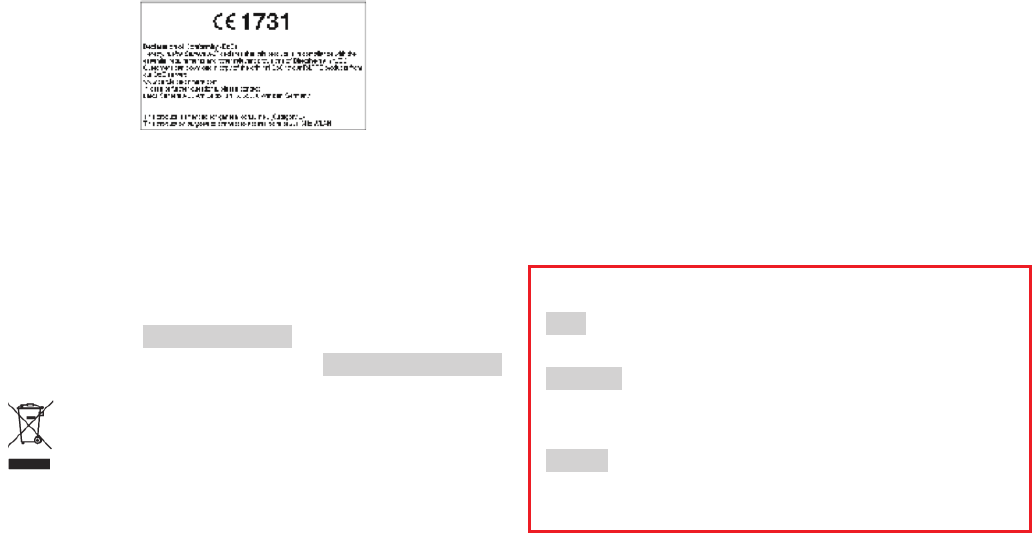
DISPOSAL OF ELECTRICAL AND ELECTRONIC EQUIP-
MENT
(Applies within the EU, and for other European countries
with segregated waste collection systems.)
This device contains electrical and/or electronic components and
should therefore not be disposed of in general household waste.
Instead it should be disposed of at a recycling collection point pro-
vided by the local authority. This costs you nothing. If the device itself
contains replaceable (recharge- able) batteries, these must be re-
moved rst and, if necessary, also be disposed of in line with the rel-
evant regulations. Further information on this issue is available from
your local administration, your local waste collection company, or in
the store where you purchased this device.
Warning Messages
• Modern electronic components react sensitively to electrostatic
discharge. As you can easily pick up charges of tens of thousands
of volts by walking on synthetic carpets, for example, a discharge
can occur when you touch your Sinarback S 30|45, particularly if it
is lying on a conductive surface. If only the housing is touched, this
discharge is harmless to the electronics. However, despite built-in
safety circuits, outer contacts such as those in the bottom of the
camera should not be touched if at all possible for safety reasons.
• For any cleaning of the contacts, please do not use an optical
microfiber cloth (synthetic); use a cotton or linen cloth instead!
Before touching the contacts, you can make sure you discharge
any electrostatic charge by deliberately touching a heating or water
pipe (conductive, earthed material). You can also avoid soiling and
oxidization of the contacts by storing your Sinarback S 30|45 in a
dry place with contacts covered.
• Use only the recommended accessories to prevent faults, short
circuits or electric shock.
• Do not attempt to remove parts of the body (covers); qualified re-
pairs can be carried out only at authorized service centers.
Legal information:
• Please ensure that you strictly observe copyright laws. The record-
ing and publication of prerecorded media such as tapes, CDs, or
other published or broadcast material may contravene copyright
laws.
• This also applies to all of the software supplied.
• The SD, HDMI, CF and USB logos are trademarks.
• Other names, company and product names referred to in these
instructions are trademarks or registered trademarks of the rele-
vant companies.
The CE identification of our products documents compliance
with the fundamental requirements of the respective valid EU
directives.
The production date of your camera can be found on the stickers in
the warranty card and/or on the packaging.
The date convention is: Year/Month/Day
In the menu, under Camera Information, you will find the specific
approvals for this Sinarback under the point Regulatory Information.
Package Contents:
Before using your Sinarback S 30|45 for the first time, please check
that the accessories supplied are complete.
• Digital Back Sinarback S 30|45
• Quick Charger S with interchangeable mains plugs (16009)
• Sinar Software (SIN-551.043-090)
• Lemo USB-3.0-cable for Sinarback S 30|45 (Typ 007) (16040)
• WhiteShadingDiffusor 100 (S07043)
3 — Legal Information
Note:
Additional information
Important:
Failure to observe the instructions may cause damage to the digital
back, camera, accessories or the photos.
Caution:
Failure to observe the instructions may cause personal injury.
Meaning of the different note categories in this manual:
3 — Legal Information
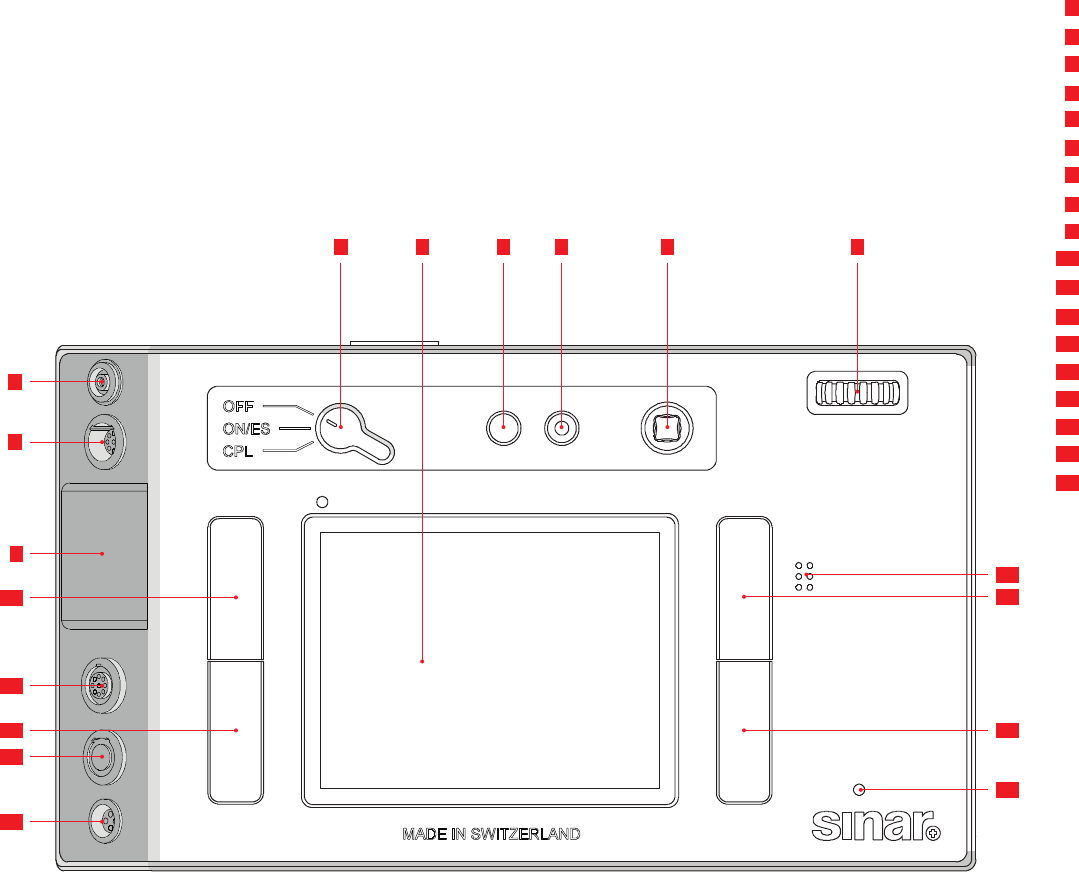
1 2 3 4 5 6
7
8
9
10
11
12
13
14
15
16
17
18
3 — Legal Information
Main switch with stop position
Monitor
Live view button
Video record button
Joystick
Rear setting dial
Flash synchronization socket
Lemo® audio socket
HDMI socket
Menu control / function button
Lemo® USB 3 socket
Menu control / function button
Lemo® remote control out socket
Lemo® CPL socket
Speaker
Review / menu control / function button
menu control / function button
LED for recording dada storage on card
1
5
3
7
9
2
6
4
8
10
12
14
16
18
11
13
15
17
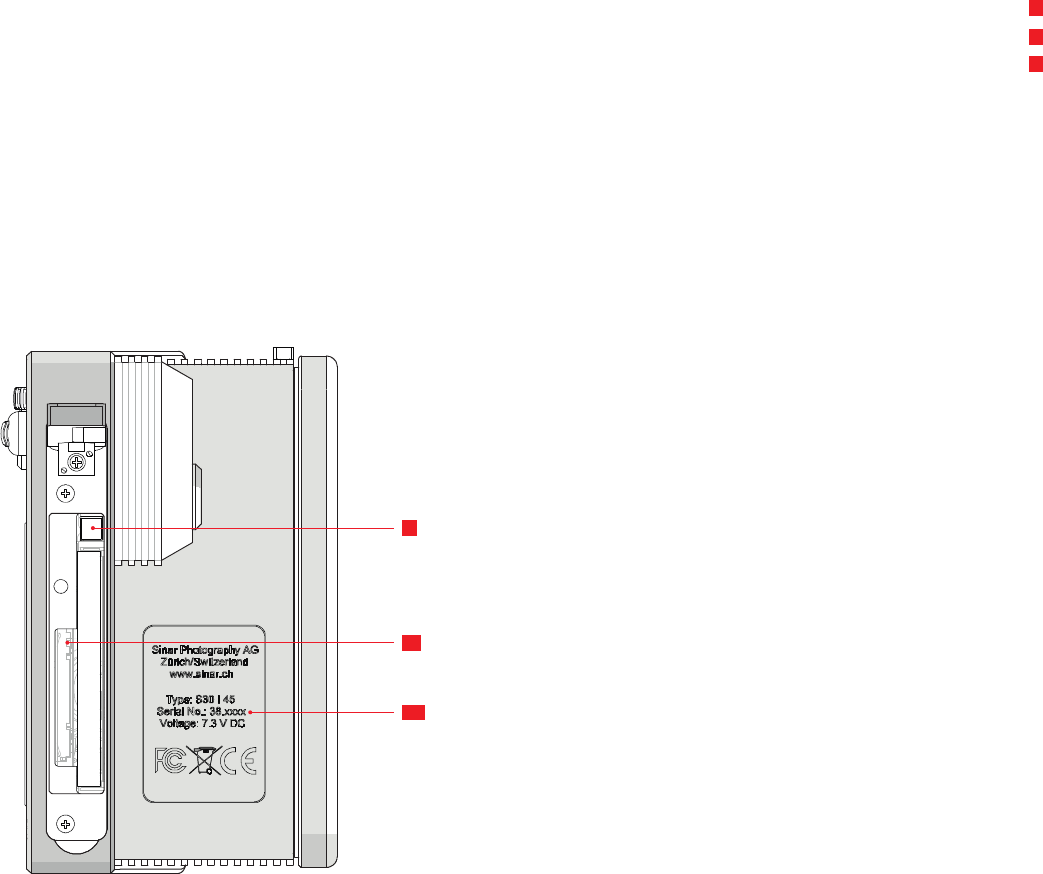
3 — Legal Information
Serial number / WiFi antenna
CF-card slot with ejection slide
SD card slot
1
3
2
1
2
3
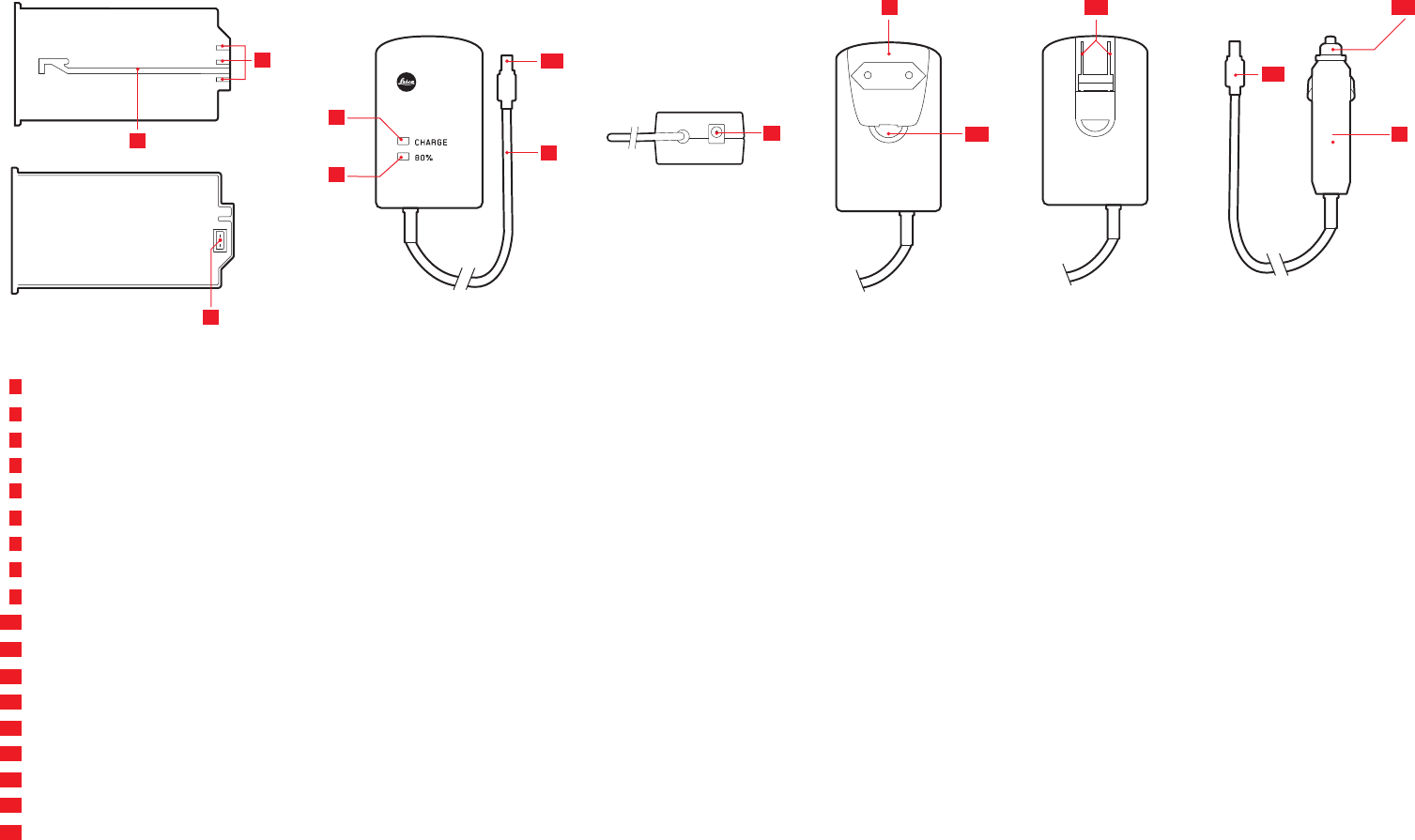
3 — Legal Information
Main switch with stop position
Monitor
Live view button
Video record button
Joystick
Rear setting dial
Flash synchronization socket
Lemo® audio socket
HDMI socket
Menu control / function button
Lemo® USB 3 socket
Menu control / function button
Lemo® remote control out socket
Lemo® CPL socket
Speaker
Review / menu control / function button
menu control / function button
LED for recording dada storage on card
1
5
3
7
9
2
6
4
8
10
12
14
16
18
11
13
15
17
54a
54b
54
53
53a
49a
49
51
50
52
48
46
47
53b
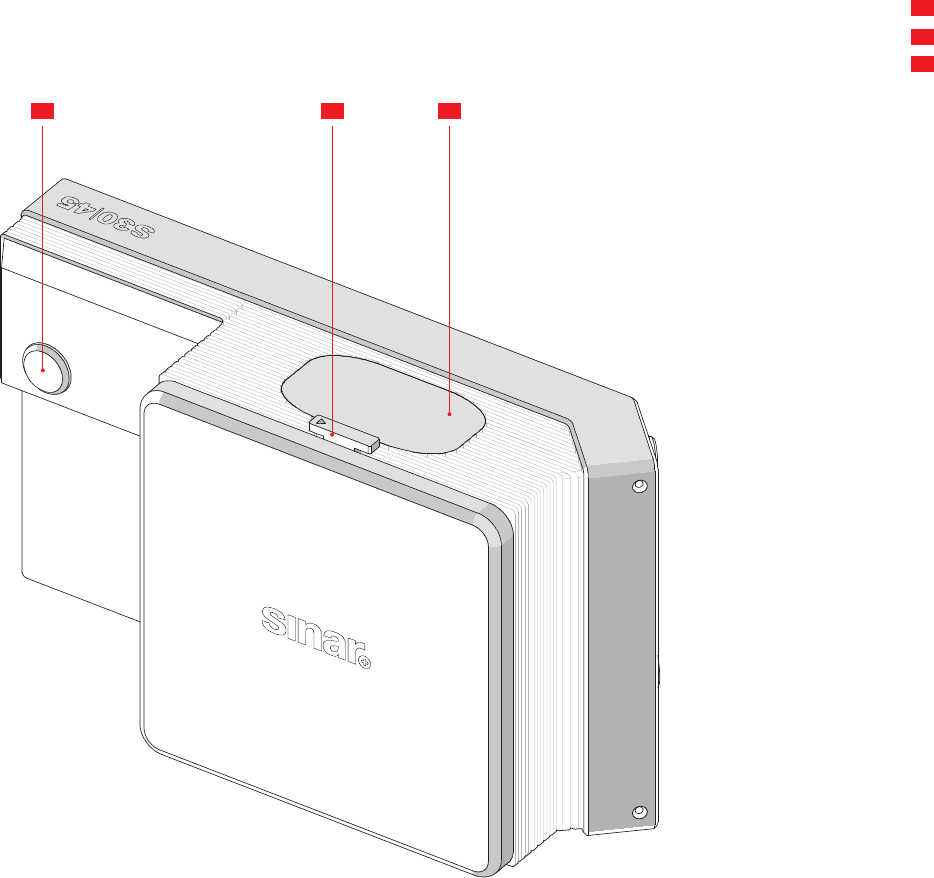
18
18
18
3 — Legal Information
Main switch with stop position
Monitor
Live view button
17 17 17

Operational Modes
Tethered Mode
In tethered mode the Sinarback S 30|45 is connected to the com-
puter via usb. The Sinarback is remote-controlled using the suitable
software Sinar Capture Flow.
Portable Mode
In portable mode, the Sinarback S 30|45 is controlled by using the
operational elements at the camera body and the Sinarback.
Note: You need the software Sinar CaptureFlow for the operation in
tethered mode. It is available for download on Sinars website www.
sinar.ch. Batteries will not be charged over usb.
Data saving
Computer
When the Sinarback S 30|45 is remote-controlled from a computer,
the images are saved in the selected directory on the computer. For
further information, refer to the information in the user manual of
Sinar CaptureFlow.
Memory card
When the Sinarback S 30|45 is operated in portable mode, the imag-
es taken are saved on the memory card card.
Interfaces/Sockets
LEMO® USB 3.0 socket
Via the usb 3.0 socket the Sinarback can be connected to a comput-
er and operated using Sinar CaptureFlow. The captured images are
saved directly to the hard drive of the computer.
LEMO® CPL
The Trigger In interface is necessary to synchronize the Sinarback
with the shutter-system. Connect the trigger cable to the Trigger
In-socket of your Sinarback S 30|45 and the shutter-system.
Flash synchronization socket
When the flash synchronization socket at your shutter-system is in
operation, for example when the trigger cable is used, connect the
flash device or studio flash unit to the flash synchronization socket of
the Sinarback S 30|45.
LEMO® Multisync
Use the audio adapter S (Order No. 16 042) in order to simultaneous-
ly connect headphones and a microphone (both with 3.5 mm jack).
The electric remote cord S (Order No. 16 029) is highly recommend-
ed where maximum jitter-free photography is demanded.
HDMI socket
Allows exceptionally fast transfer of picture data to display equip-
ment with corresponding HDMI sockets.
WLAN
You can control the camera remotely using a smartphone/tablet or
use the smartphone/tablet as an external storage medium. In order
to do this, the Sinar S app must first be installed on your smartphone.
This app is available in the Apple App Store™ for iOS™ devices.
Assembly and Commissioning
To attach Sinarback S 30|45 to your camera, an adapter is necessary.
The adapter depends on the camera type. In the following, the use of
a fixed adapter is described.
Note: The information about your camera type has been taken with
your order, and the necessary adapter kit is included in your delivery.
If you are using another adapter than the one described in the fol-
lowing, a separate documentation describing the assembling of the
adapter is included in your delivery.
The adapter plate is attached to the Sinarback by means of three
recessed screws.
1. Remove the protective cover from the Sinarback S 30|45
2. Attach the adapter plate to the Sinarback.
3. Insert the screws into the three holes. Tighten the screws alter-
nately a little, do not fix one screw completely at a time. In this way
you can avoid that the adapter plate would be fixed askew.
4. Attach the Sinarback to the camera. Make sure that it is mounted
safely.
3 — General Information
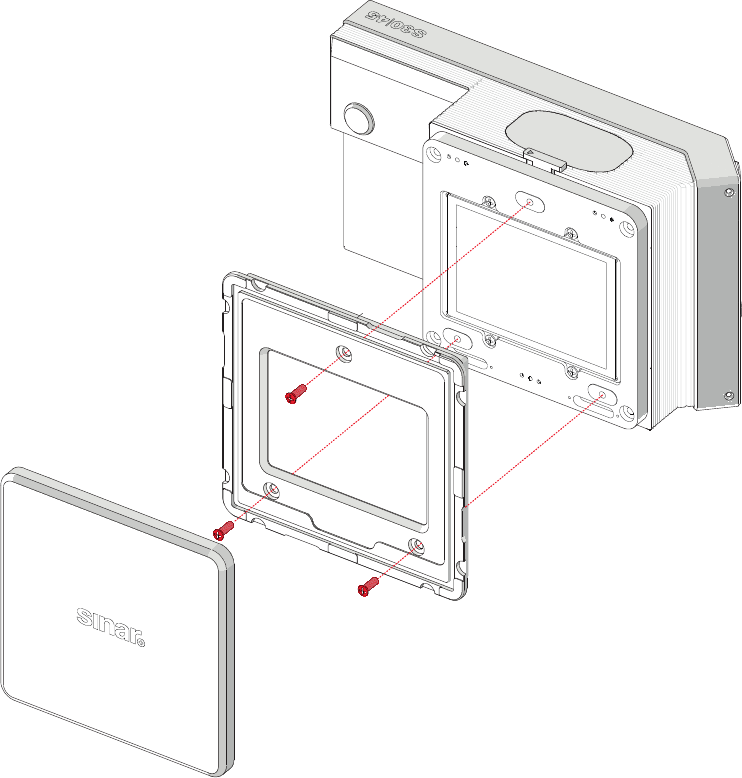
3 — Legal Information

Charging the battery
The Sinarback S 30|45 is powered by a lithium ion battery (A).
Important:
Batteries from the earlier Leica S (006) models (Order No.14 429)
cannot be used in the Sinarback S 30|45. Please use only the Leica
battery S BP-PRO1 (Order No. 16 039).
Caution:
• Only the battery type specified and described in this manual, or
battery types specified and described by Sinar Photography AG,
may be used in this digital back.
• These batteries may only be used in the units for which they are
designed and may only be charged exactly as described below.
Preparations
• Using this battery contrary to the instructions and using non-spec-
ified battery types can result in an explosion under certain circum-
stances!
• The batteries must not be exposed to sunlight or heat for pro-
longed periods, or to humidity or moisture. Likewise, the batteries
must not be placed in a microwave oven or a high pressure con-
tainer as this results in a risk of re or explosion!
• Damp or wet batteries must not be charged or used in the camera
under any circumstances!
• Always ensure that the battery contacts are clean and freely acces-
sible. Whilst lithium ion batteries are proofed against short-circuit,
they should still be protected against contact with metal objects
such as paper clips or jewelry. A short-circuited battery can get very
hot and cause severe burns.
• If a battery is dropped, check the casing and the contacts imme-
diately for any damage. Using a damaged battery can damage the
camera.
• In case of noise, discoloration, deformation, overheating or leaking
fluid, the battery must be removed from the camera or charger
immediately and replaced. Continued use of the battery results in a
risk of overheating, which can cause re and/or explosion!
• In case of leaking fluid or a smell of burning, keep the battery away
from sources of heat. Leaked fluid can catch fire!
• Only the charger specified and described in these instructions, or
other chargers specified and described by Sinar Photography AG,
may be used. The use of other chargers not approved by Sinar Pho-
tography AG can cause damage to the batteries and, in extreme
cases, can cause serious or life-threatening injuries.
• The charger supplied should be used exclusively for charging this
battery type. Do not attempt to use it for other purposes.
• Ensure that the power socket used is freely accessible.
• The car charging cable supplied must never be connected while
the charger is connected to the mains.
• Battery and charger must not be opened. Repairs may only be
carried out by authorized service centers.
• Keep batteries out of the reach of children. Batteries can cause
suffocation if swallowed.
First Aid:
• If battery fluid comes into contact with the eyes, there is a risk of
blinding! Rinse the eyes immediately with clear water. Do not rub
the eyes!
• Obtain medical assistance immediately.
• If leaked fluid gets onto the skin or clothing, there is a risk of in-
jury. Wash the areas concerned with clear water. Obtain medical
assistance.
3 — Preparations

Notes:
• The battery must have a temperature of +10°to +30°C to be
charged (otherwise the charger will not turn on, or will turn off
again).
• Lithium ion batteries can be charged at any time, regardless of
their current charge level. If a battery is only partly discharged when
charging starts, it is charged to full capacity faster.
• A new battery only reaches its full capacity after it has been fully
charged and – by use in the digital back - discharged again 2 or 3
times. This discharge procedure should be repeated roughly every
25 cycles.
• Both battery and charger become warm during charging. This is
normal and not a malfunction.
• If the two LEDs flash rapidly (> 2 Hz) after the start of charging,
this indicates a charging error (e.g. maximum charging time ex-
ceeded, voltages or temperatures outside the permitted ranges, or
short circuit). In this case, disconnect the charger from the mains
and remove the battery. Ensure that the above temperature condi-
tions are met and then restart the charging process.
• If the problem persists, please contact your dealer, the Leica once
in your country or Sinar Photography AG.
• Lithium ion batteries should only be stored partly charged, i.e.
not when fully discharged or fully charged. For very long storage
periods, you should charge the battery for approx. 15 minutes
roughly twice a year to avoid a deep discharge.
• Rechargeable lithium ion batteries generate power through inter-
nal chemical reactions. These reactions are also in uenced by the
ambient temperature and humidity. To ensure a maximum service
life of the battery, it should not be exposed to constant extremes of
temperature (e.g. in a parked car in the summer or winter).
• Even when used under optimum conditions, every battery has a
limited service life! After several hundred charging cycles, this
becomes noticeable as the operating times become significantly
shorter.
• Dispose of damaged batteries in accordance with the relevant
regulations (see p. 6, 54) at an approved collection point for proper
recycling.
• The replaceable battery provides power to a back-up battery which
is permanently tted in the camera. This back-up battery retains
the set time and date for up to 3 months. If this back-up battery
becomes discharged it must be recharged by inserting a charged
main battery. Once the replaceable battery has been inserted, the
full capacity of the back-up battery is recovered after about 60
hours. This process does not require the camera to be turned on. In
this case, however, the time and date have to be set again.
• Remove the battery if you will not be using the camera for a long
period of time. When doing so, turn the camera o using the main
switch rst. Otherwise after several weeks the battery could undergo
deep dis- charge, i.e. the voltage is sharply reduced, as the cam-
era still con- sumes a small amount of current (e.g. for saving your
settings) even when it is turned off.
3 — Preparations
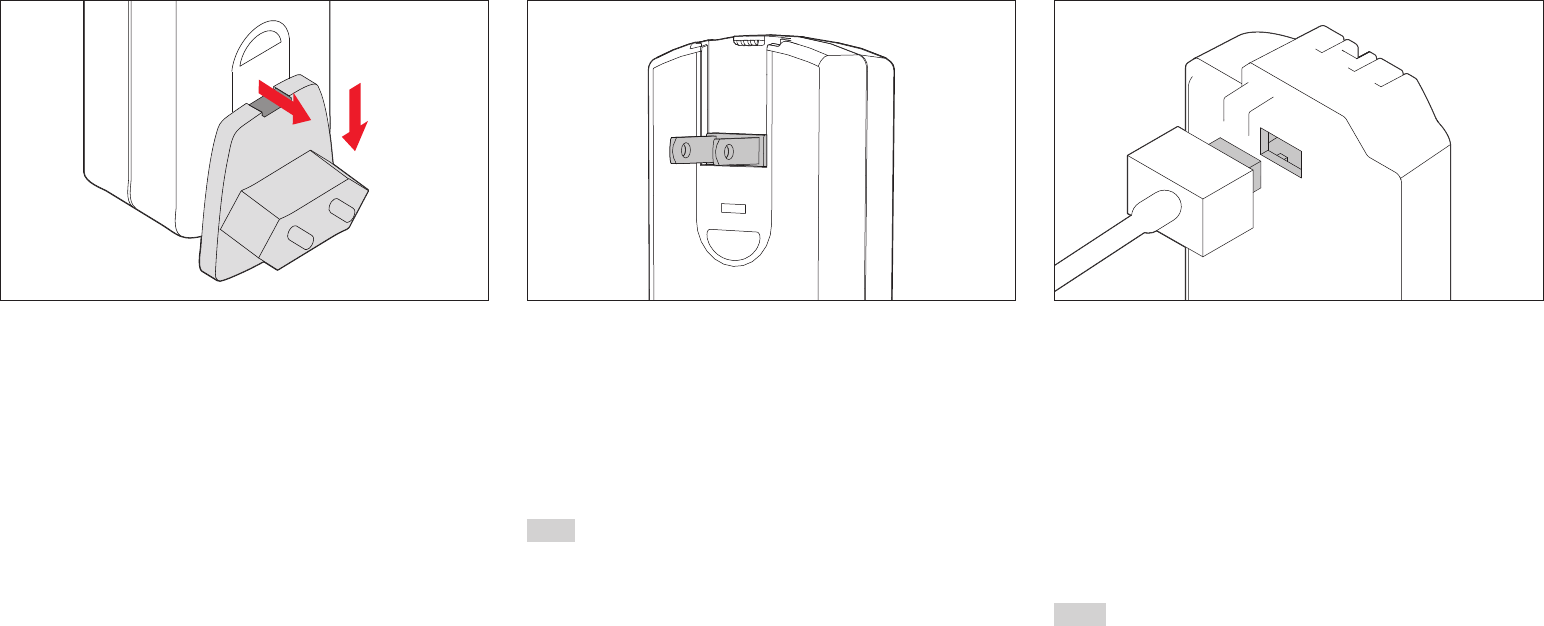
For the use outside the USA For use in the USA Connection of the charger
1. Insert the appropriate plug for the local mains power supply into
the charger. To do this, push up a. the release button and at the
same time push b. the plug down out of its engaged position.
2. It can then be removed completely downwards.
3. Push the appropriate plug variant into the charger from below until
it engages.
1. Remove the mains plug fitted at the factory from the charger. To do
this, push up
a. the release button and at the same time push
b. the plug up out of its engaged position.
2. The two pins of the USA plug that are normally horizontal when not
in.
Notes:
The charger switches automatically to the prevailing mains voltage.
In combination with the car charging cable supplied with the charger,
it can be used in all vehicles with 12 V and 24 V power systems. In
this case again, it switches over automatically.
1. Connect up the charger, i.e. insert its cable plug into the socket of
the battery and insert the mains plug into a plug socket.
• The green LED marked CHARGE then starts to flash as confirma-
tion that charging is in progress.
• As soon as the battery has charged to at least 4⁄5 of its capaci-
ty, the orange LED marked 80% also lights up.
• When the battery has been completely charged after approx.
31⁄2 hours, 100% capacity has been reached, the flashing green
CHARGE LED changes to a steady light.
Notes:
• The 80% LED lights up after around 2 hours due to the charging
characteristics. If the full capacity of the battery is not absolutely
necessary, the camera can be ready for use again in a relatively
short time.
• The steady light of the green CHARGE LED indicates that the char-
ger has automatically switched to trickle charging.
2. The charger should then be disconnected from the mains power
supply. There is, however, no risk of overcharging.
3 — Preperation of the charger
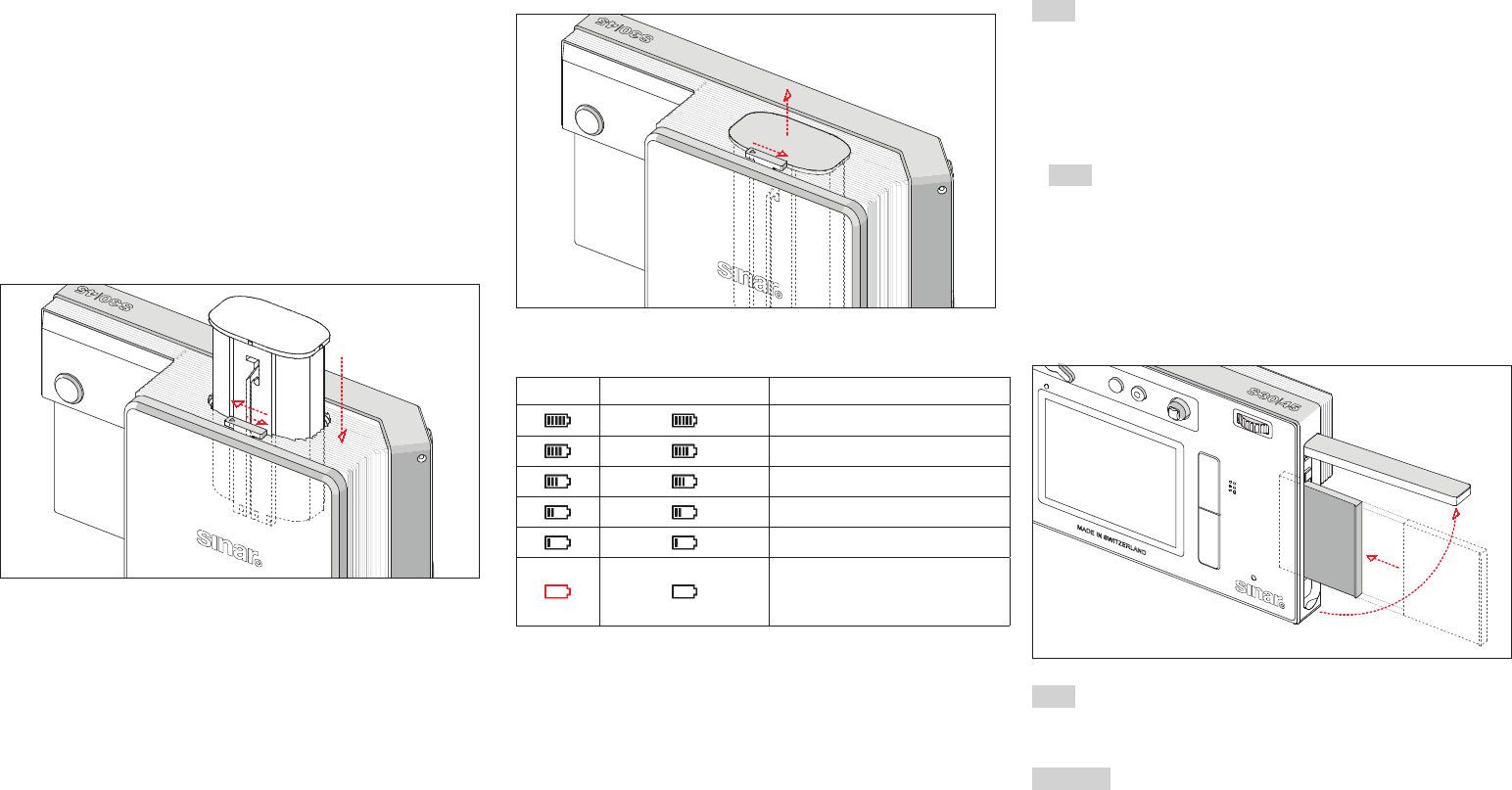
Charging the battery
Preparations
Turn off the digital back, i.e. set the main switch to OFF.
Inseration
Push the battery with the contacts facing downward and with its
guide groove facing the sensor of the digital back fully into the bat-
tery compartment. It engages automatically in this position.
Charge level displays
Removal
1. Turn the release lever to the right side until it stops
• A spring in the battery compartment than pushes the battery ap-
prox. 1 cm out.
• The locking mechanism has a detent so that the battery can-
not accidentally fall out even if the digital back is held upside-
down.
2. Push the battery approx. 1 mm back to disengage the detent, and
3. then pull it out of the compartment or, if the digital back is held
upsidedown, allow the battery to slide out into your hand.
Changing memory cards
The Sinarback S 30|45 offers you the possibility of using 2 card types
in parallel for storing of recorded data. It has two card slots, one for
SD/SDHC/SDXC (Secure Digital) cards and one for CF (Compact
Flash up to UDMA 7) cards.
Preparations
1. Turn off the digital back, i.e. set the main switch to OFF.
Note:
Do not turn off the camera as long as the LED for data storage is still
lit.
2. Lift the cover up on the right-hand side of the digital back, i.e. push
back EN slightly to unlock, then fold open to the right.
Note:
Do not touch the memory card contacts.
CF cards (CompactFlash)
Inseration
Push the card with the contacts facing towards the camera and with
the front facing towards the front of the digital back fully into the slot.
Note:
Ensure that the ejection slide is completely pushed in (see “Remov-
al” on the following page).
Important:
Do not use force! The contacts in the card slot could otherwise be
damaged!
3 — Changing the battery
Monitor Top panel display Charge status
approx. ≥ 85%
approx. ≥ 65%
approx. ≥ 40%
approx. ≥ 20%
approx. ≥ 5%
approx. ≤ 5%, replacement or
recharging of the battery
necessary
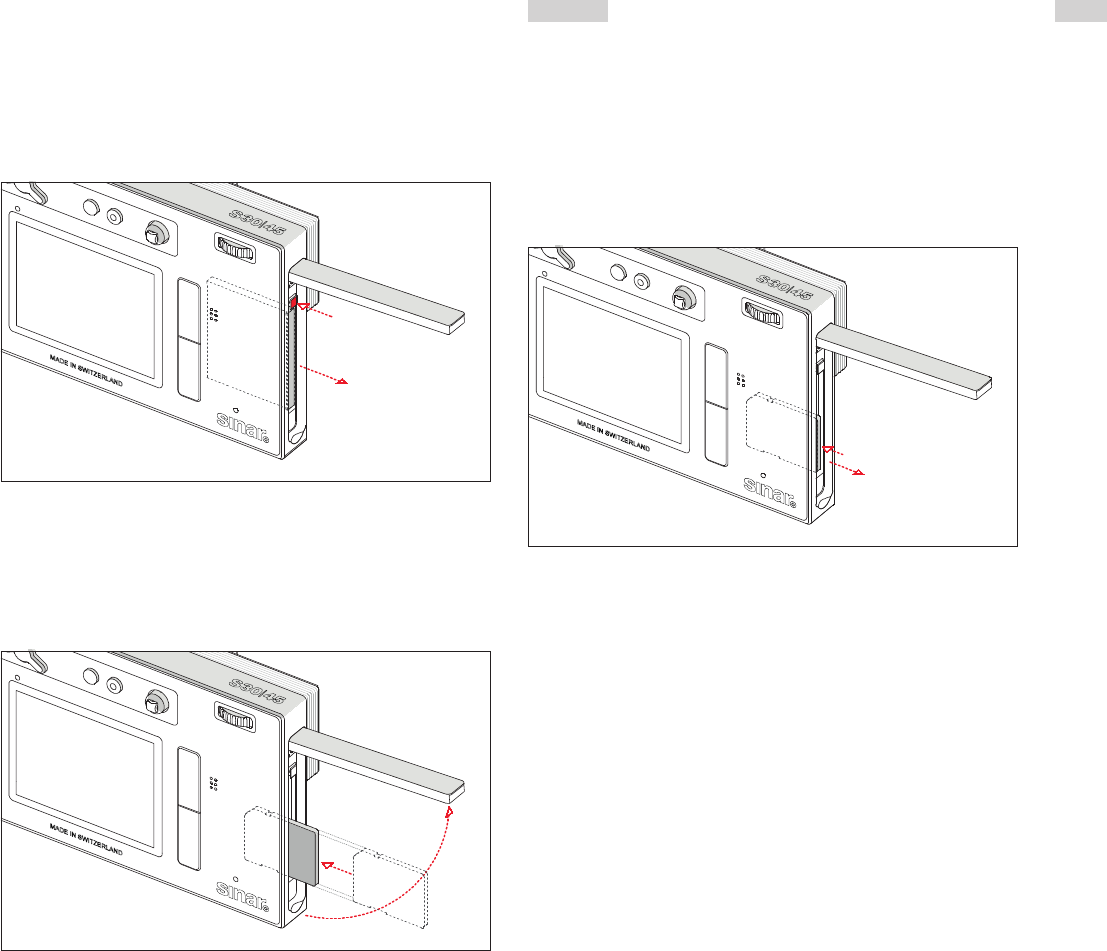
Removal
1. Push the ejection slide inwards.
• The slide is then pushed out slightly.
2. Press the slide inwards again.
• The card is then pushed slightly out of the slot.
3. Pull out the card.
SD / SDHC / SDXC cards
Inseration (Close Cover)
Push the card completely into the slot with the contacts facing to the
rear and with the beveled corner facing upwards against the spring
pressure until it engages audibly.
Important:
Ensure that no SD/SDHC/SDXC card is pushed into the CF card slot
as it might not be possible to remove it again!
Removal
1. Press the card further into the slot. • The card is released and
pushed slightly out of the slot.
2. Pull out the card.
Close cover
Close the cover and push forward until it engages.
Displays
Memory card faults are indicated by different messages in the
monitor.
Notes:
• If the memory cards cannot be inserted, check that they are
aligned correctly.
• The range of memory cards available is too large for Sinar Photog-
raphy AG to be able to completely test all available types for com-
patibility and quality. Although using other card types is not likely to
damage the digital back or the card, some “no name” cards do not
comply with the memory card standards, and Sinar Photography
AG is unable to provide any guarantee that they will function cor-
rectly.
• Do not remove either a memory card or the battery as long as the
red LED at the bottom right next to the monitor is ashing, indicating
picture recording and/or data saving to the card(s). Otherwise the
unsaved (or not completely saved) picture data may be lost.
• The Sinarback S 30|45 offers different variants for the storage of
picture data. Further information on this topic can be found under
“Storage of picture data / memory card management”.
• As electromagnetic fields, electrostatic charges, and defects in the
camera or the card(s) can lead to damage or loss of the data on the
memory card(s), we recommend that you also transfer the data to a
computer and save it there.
• For the same reason we also recommend that the cards are always
stored in an antistatic case.
• The proper function of the camera cannot be guaranteed if WiFi
cards are used.
• SD, SDHC, and SDXC memory cards have a write protection switch,
which can be used to prevent unintentional storage and deletion of
pictures. This switch takes the form of a slider on the non-beveled
side of the card; in the lower position, marked LOCK, the data is
protected.
• Memory cards with a capacity of less than 1 GB cannot be used.
3 — Preperation of the charger
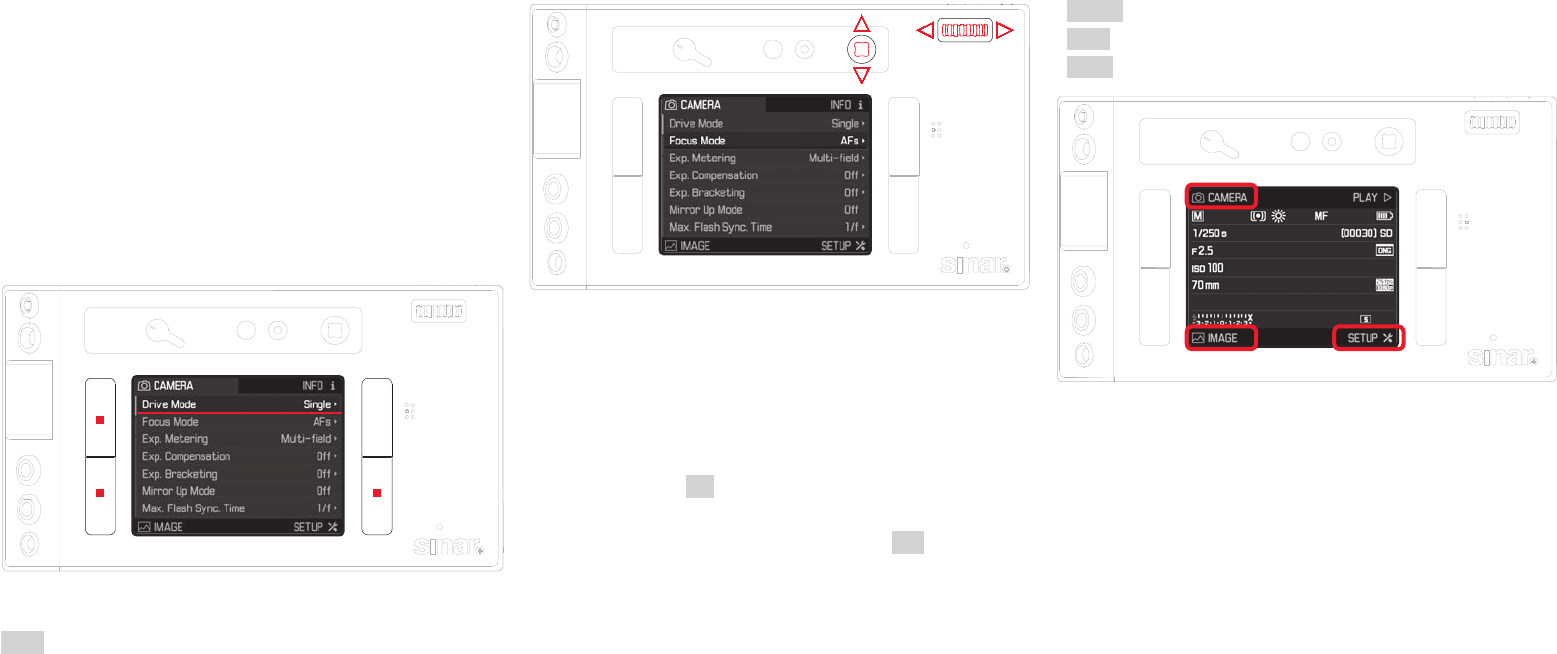
Menu control
Most of the operating modes and settings of the Sinarback S 30|45
are operated by a menu control. Navigation and settings in the whole
menu are very quick and simple as
• the menu items are divided into function groups, and
• also four user-defined menu items can be called up directly by
holding the button depressed (quick access).
Controls / calling up menu control
Three of the four buttons to the left and right of the monitor are used
for calling up menu control and for direct access to the function
groups, namely the two buttons on the left and the lower right button.
All settings of the menu items can also be made with the rear thumb-
wheel or the Joystick.
Menu function groups
The menu of the Sinarback S 30|45 is divided into 3 function groups
(see Annex “The menu items”):
• Camera
• Image
• Setup
Exiting the menu
You can exit the menu in different ways:
• To switch to recording mode: Press the shutter release or video
record button, or press the Live View button
• To switch to the recorded data display: Press the button top right –
in this case marked Info – briefly
• To switch to review mode: Press the button top right while the re-
corded data are displayed – in this case marked Play – briefly again.
Note:
All four of these buttons are “soft keys”. Outside menu control, e.g. in
Live View and video mode and during the review of pictures on the
monitor, they have different functions that are indicated by corre-
sponding displays.
3 — Changing the battery
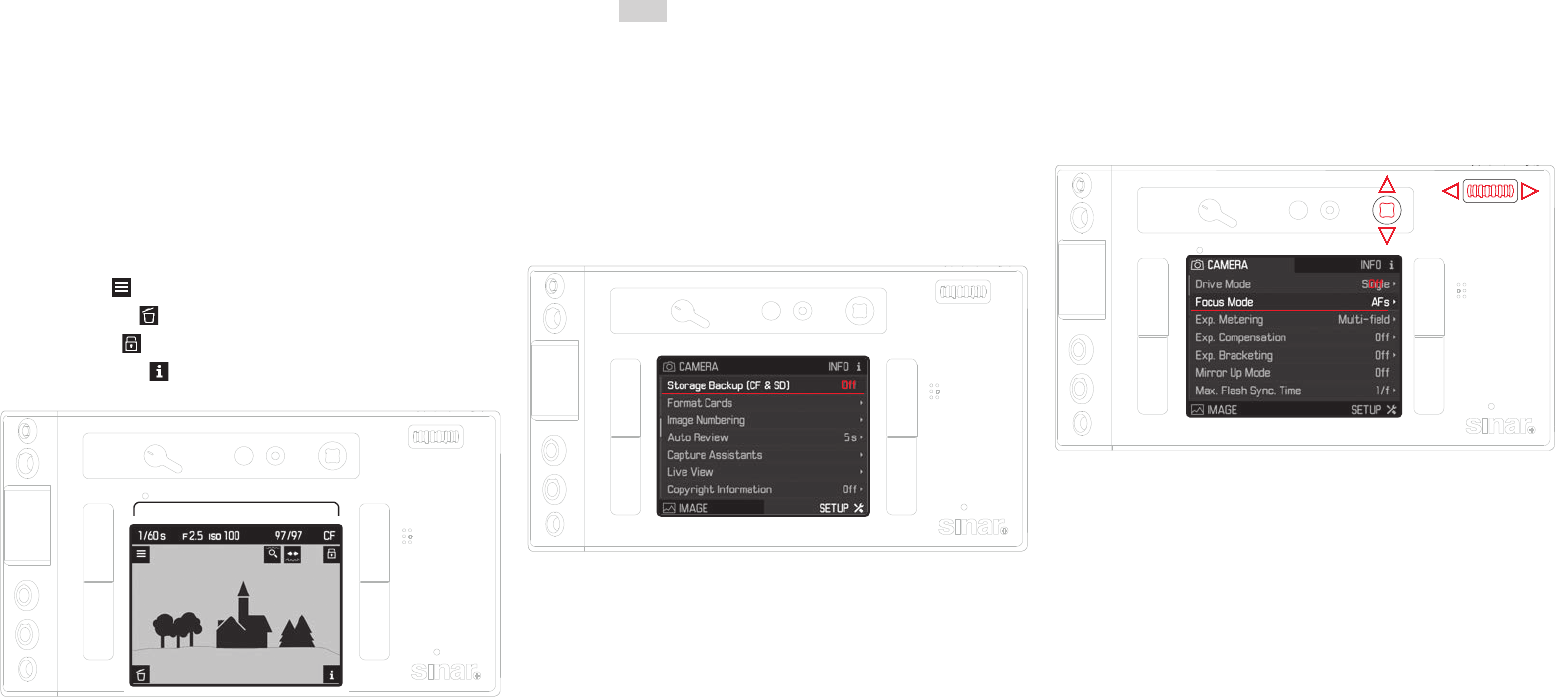
Navigating in the menu / setting the functions
1. Select the respective menu function groups by briefly (≤ 1 s) press-
ing the following buttons twice:
• Top left for the menu items of the Camera function group,
• Bottom left for the menu items of the Image function group, and
• Bottom right for the menu items of the Setup function group.
• If the monitor was previously inactive (dark), the recorded data
display appears when the button is pressed briefly the first
time. The text boxes in the monitor image opposite the three
buttons indicate the corresponding menu function groups.
• If these are displayed from review mode, the button functions
valid in this situation are first displayed in an intermediate step:
– Top left: (Menu)
– Bottom left: (Delete)
– Top right: (Protect)
– Bottom right: (Recorded data display)
• The menu screen shows as a guide to orientation:
• In white type the respective menu function group selected
• In group SETUP with a scrollbar on the left, which page of the list
is currently displayed
• On each page in the individual lines the menu items are dis-
played on the left and to the right the corresponding settings.
• In white type with red underlining the active menu function line
(this applies at all menu levels). The currently set function variant
or the currently set value is always displayed to the right in the
line.
When the menu is called up, the last menu item changed is always
active.
2. Select the individual menu items
• either by turning the rear thumbwheel to the right - scroll down /
to the left - scroll up.
• or by pressing the Joystick in the desired direction
The menu items of all three function groups form a common endless
loop, i.e. they can all be reached in both directions.
3 — Preperation of the charger
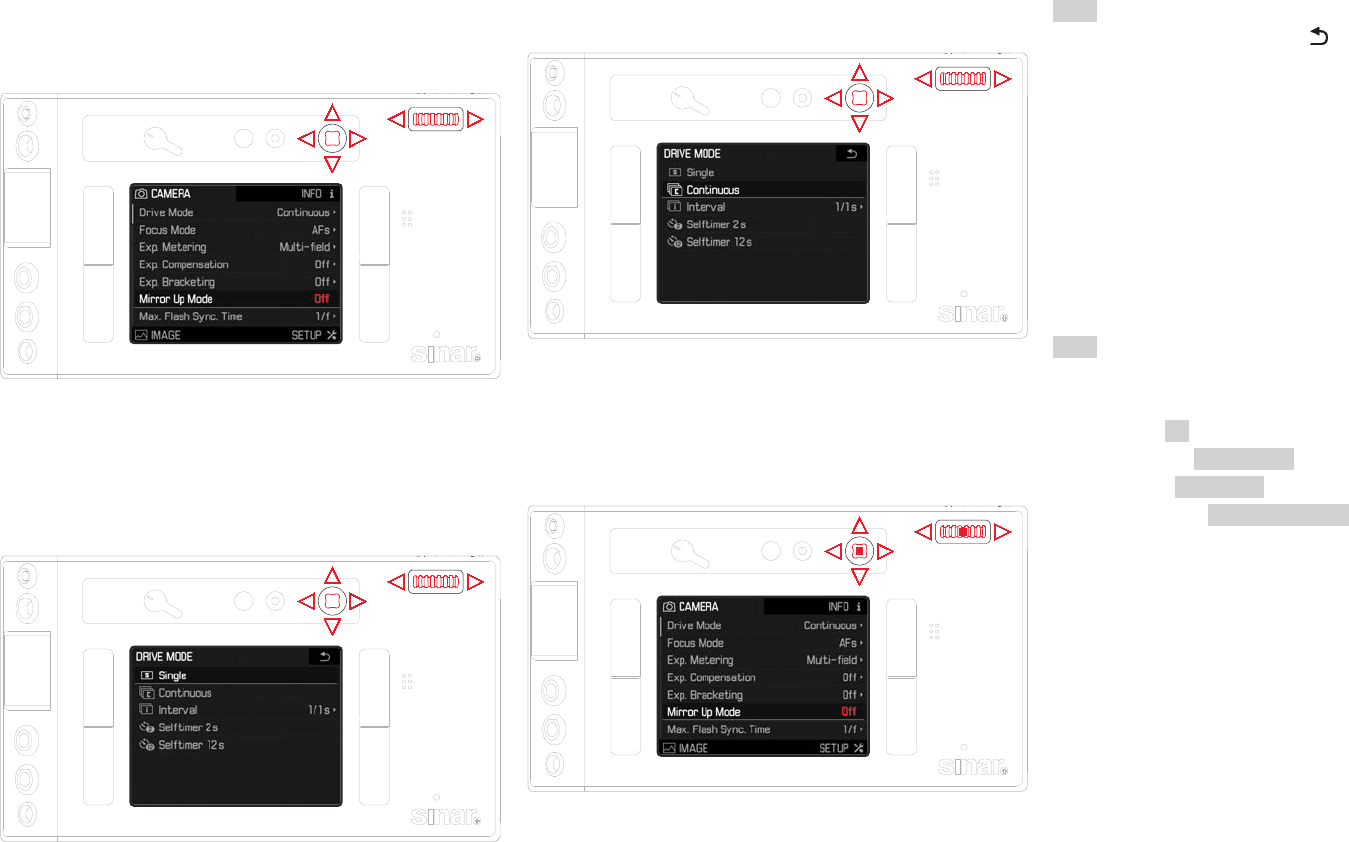
Direct setting of the menu items without sub-menu
(In the 4 menu items without a triangle at the right-hand end of the
line)
1. Press the rear thumbwheel or the Joystick forwards or to the right
• The set function variant changes. The setting is immediately
values that can be set appears.
3. Turn the rear thumbwheel to the right or left or press the Joystick
in the desired direction (this differs, depending on whether a list
• The display returns to the next higher menu level or switches to
the next function variant for functions requiring further settings.
Note:
Briefly pressing the button marked in this case allows you to re-
turn to the menu at any time – without saving the changes made in
the sub- menus up to that point.
Quick access to menu functions
For particularly fast operation you can use all four buttons to directly
call up as many as 4 of the menu functions most important to you or
the most frequently required menu functions.
First define which (menu) function you wish to call up with each of
these buttons.
Note:
The buttons for the quick access are assigned as follows at the fac-
tory:
Button top left: ISO
Button bottom left: Exp.metering
Button top right: Focus Mode
Button bottom right: Exp. compensation
5. Turn the rear thumbwheel to the right or left or press the Joystick
in the desired direction (this differs, depending on whether a list
or a scale is displayed) to select the desired function variant / the
desired value.
or a scale is displayed) to select the desired function variant / the
desired value.
4. Press the rear thumbwheel or the Joystick forwards to confirm the
set function variant / the set value
active, i.e. it does not have to be confirmed.
Further setting of the menu items with sub-menu
2. Press the rear thumbwheel or the Joystick forwards or to the right
to call up the list of the respective function variants
• The sub-menu in which the respective function variant or the
3 — Changing the battery
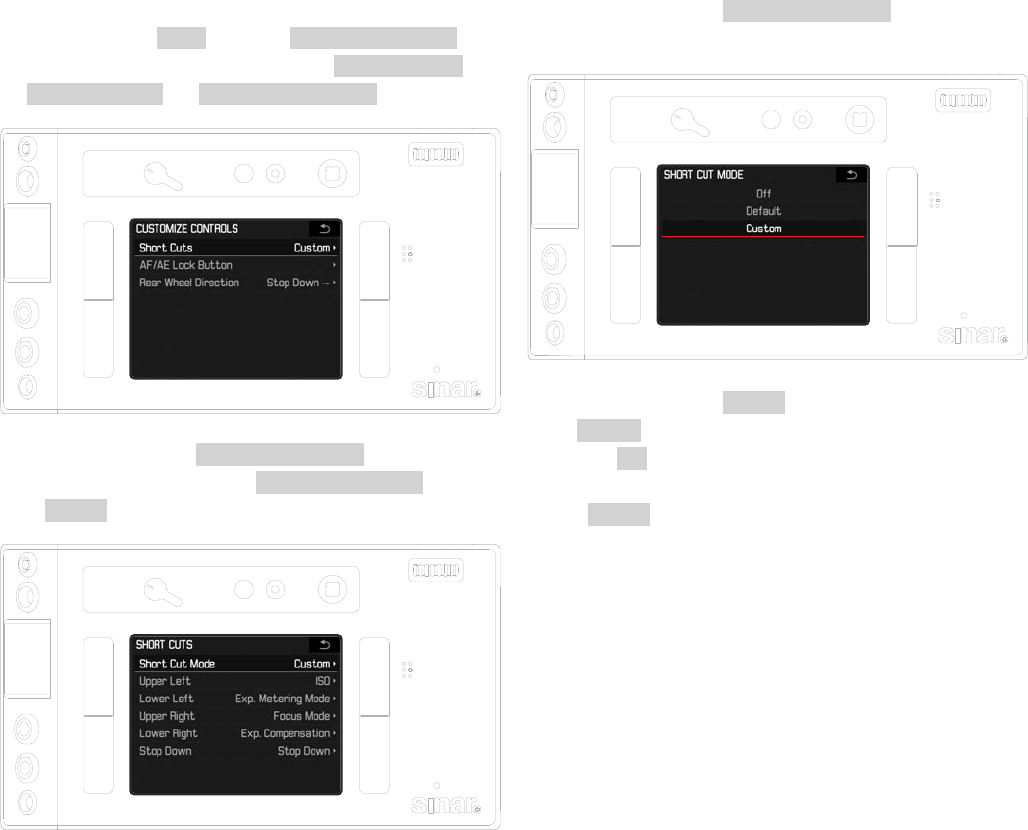
Setting the function / customizing buttons
1. In the menu, under SETUP, select the CUSTOMIZE CONTROLS
• A sub-menu appears with the three items CUSTOMIZE CON-
TROLS, AF/AE LOCK and REAR WHEEL DIRECTION.
3. In this sub-menu, select CUSTOMIZE CONTROLS
• A further sub-menu appears.
4. In this sub-menu, select CUSTOM
• (or DEFAULT if the factory setting of the button functions is to be
used, or OFF if the function is to be deactivated)
• The menu displayed in step 2. Appears again.
5. In the CUSTOM sub-menu, select the desired button
• A list with the available menu functions is displayed.
2. In this sub-menu, select CUSTOMIZE CONTROLS
• A further sub-menu appears. If CUSTOMIZE CONTROLS is not set
to CUSTOM, all the other items are inactive.
3 — The menu control
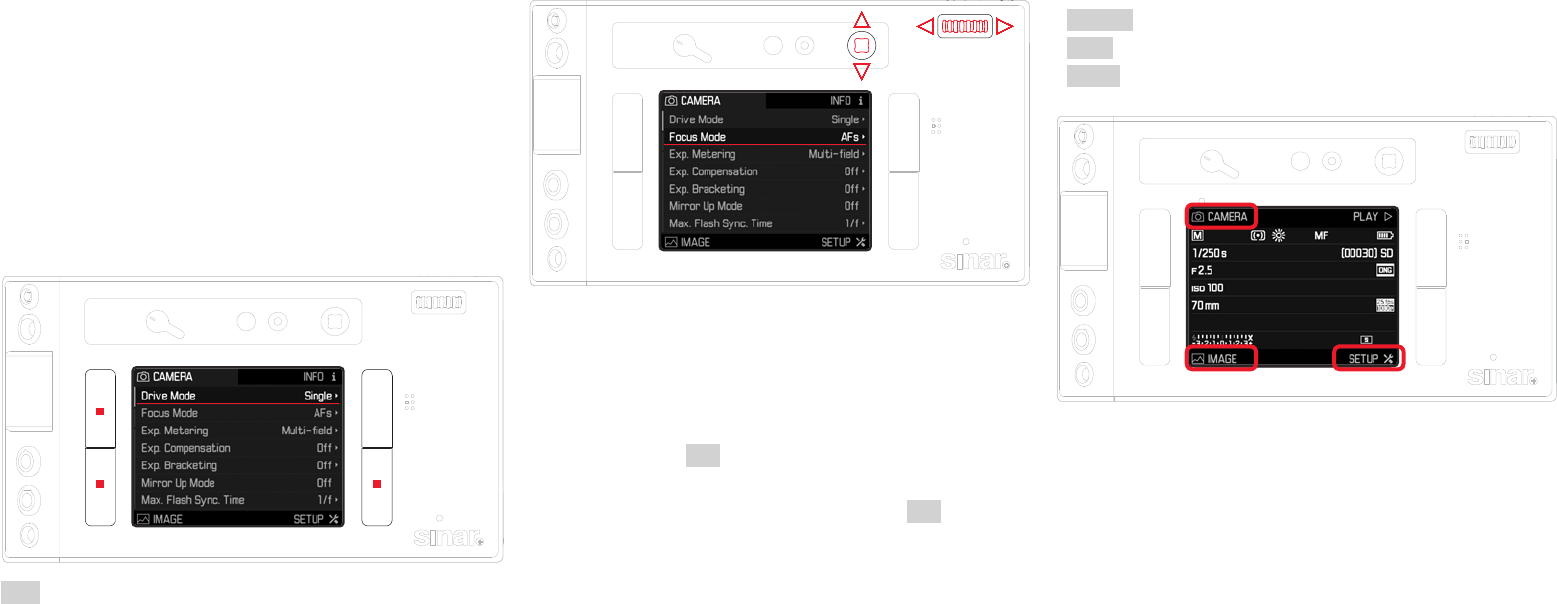
Menu control
Most of the operating modes and settings of the Leica S are operat-
ed by a menu control. Navigation and settings in the whole menu are
very quick and simple as
• the menu items are divided into function groups, and
• also fi ve user-defi ned menu items can be called up directly by
holding the button depressed (quick access).
Controls / calling up menu control
Three of the four buttons to the left and right of the monitor are used
for calling up menu control and for direct access to the function
groups, namely the two buttons on the left and the lower right button.
All settings of the menu items can also be made with the rear thumb-
wheel or the Joystick.
Exiting the menu
You can exit the menu in diff erent ways:
• To switch to recording mode: Press the shutter release or video
record button, or press the Live View button
• To switch to the recorded data display: Press the button top right –
in this case marked INFO - briefly
• To switch to review mode: Press the button top right while the
recorded data are displayed – in this case marked PLAY - briefl y
again
Menu Function Groups
The menu of the Leica S is divided into 3 function groups (see Annex
“The menu items”):
• CAMERA
• IMAGE
• SETUP
Note:
All four of these buttons are “soft keys”. Outside menu control, e.g. in
Live View and video mode and during the review of pictures on the
monitor, they have diff erent functions that are indicated by corre-
sponding displays.
3 — Changing the battery
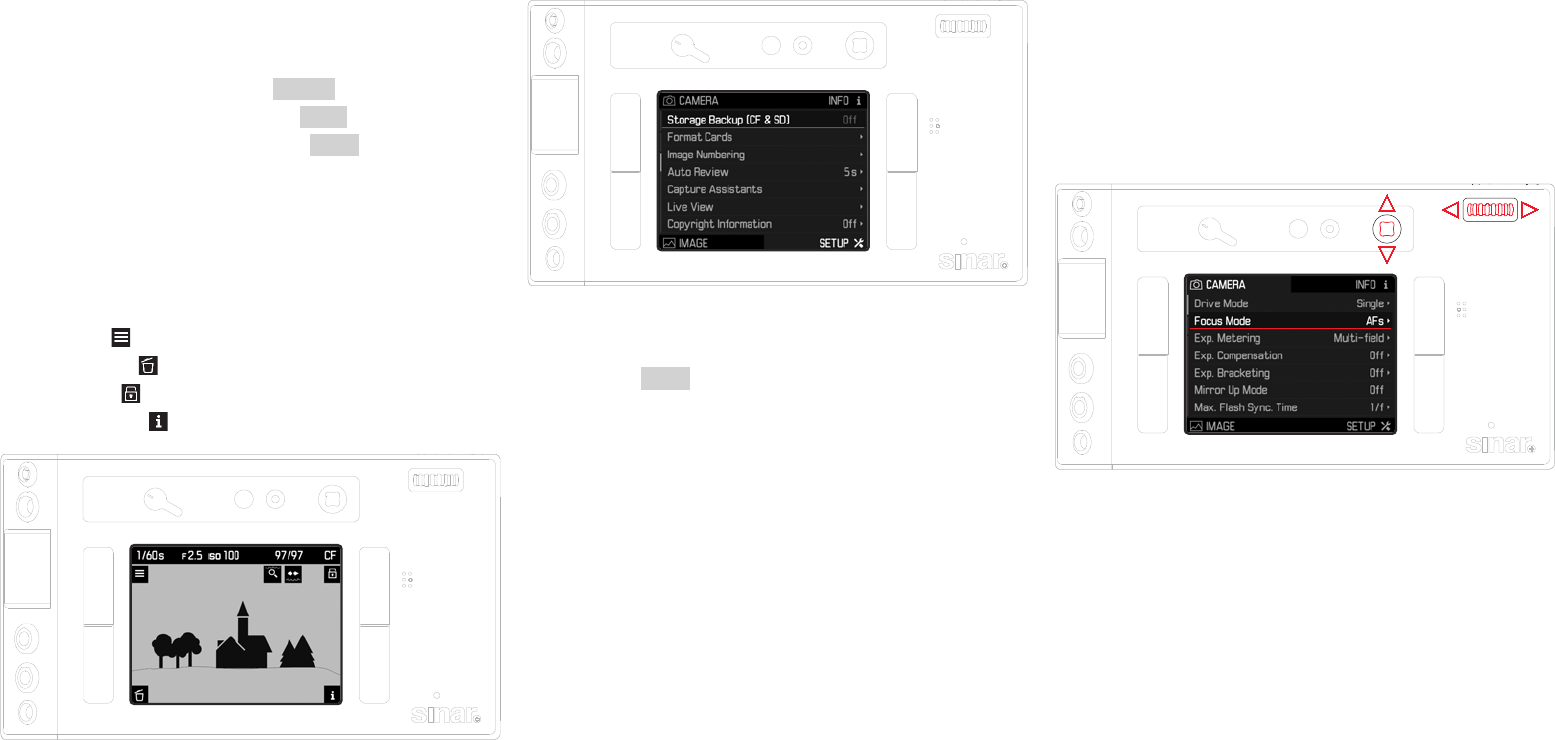
Navigating in the menu / setting the functions
1. Select the respective menu function groups by briefl y (≤ 1 s)
pressing the following buttons twice:
• Top left for the menu items of the CAMERA function group,
• Bottom left for the menu items of the IMAGE function group, and
• Bottom right for the menu items of the SETUP function group.
• If the monitor was previously inactive (dark), the recorded data
display appears when the button is pressed briefl y the fi rst
time. The text boxes in the monitor image opposite the three
buttons indicate the corresponding menu function groups.
• If these are displayed from review mode, the button functions
valid in this situation are fi rst displayed in an intermediate step:
• Top left: (Menu)
• Bottom left: (Delete)
• Top right: (Protect)
• Bottom right: (Recorded data display)
2. Select the individual menu items
• either by turning the rear thumbwheel to the right = scroll down /
to the left = scroll up,
• or by pressing the Joystick in the desired direction.
The menu items of all three function groups form a common end-
less loop, i.e. they can all be reached in both directions.
• The menu screen shows as a guide to orientation:
• In white type the respective menu function group selected
• In group SETUP, with a scrollbar on the left, which page of the
list is currently displayed
• On each page in the individual lines the menu items are dis-
played on the left and to the right the corresponding settings.
• In white type with red underlining the active menu function
line (this applies at all menu levels). The currently set function
variant or the currently set value is always displayed to the
right in the line.
When the menu is called up, the last menu item changed is always
active.
3 — The menu control

Direct setting of the menu items without sub-menu
scale is displayed to select the desired function variant / the desired
value (In the 4 menu items without a triangle at the right-hand end of
the line)
3. Press the rear thumbwheel or the Joystick forwards or to the right
• The set function variant changes. The setting is immediately
active, i.e. it does not have to be confirmed.
4. Turn the rear thumbwheel to the right or left or press the Joystick
in the desired direction (this differs, depending on whether a list
or a
ACHTUNG TEXT NOCH NICHT KOMPLETT? BITTE CHECKEN, IN
LEICA VORLAGE WAR HIER EVENTL. EIN FEHLER IN DER DATEI,
KONNTE ES NICHT NACHVOLLZIEHEN
Further setting of the menu items with sub-menu
3. Press the rear thumbwheel or the Joystick forwards or to the right
to call up the list of the respective function variants
• The sub-menu in which the respective function variant or the
values that can be set appears.
5. Press the rear thumbwheel or the Joystick forwards to confirm the
set function variant / the set value
• The display returns to the next higher menu level or switches to
the next function variant for functions requiring further settings.
Note:
Briefly pressing the button marked in this case allows you to re-
turn to the menu at any time – without saving the changes made in
the sub-menus up to that point.
Quick access to menu functions
For particularly fast operation you can use all four buttons and, in
normal photo recording mode, also the depth of field preview button
to directly call up as many as 5 of the menu functions most important
to you or the most frequently required menu functions. First define
which (menu) function you wish to call up with each of these buttons.
Hinweis:
Ab Werk sind die Tasten für den Schnellzugriff wie folgt belegt:
Taste links oben: ISO
Taste links unten: Belichtungsmessung
Taste rechts oben: Schärfeeinstellung
Taste rechts unten: Belichtungskorrektur
Abblendtaste:
im normalen Foto-Aufnahmebetrieb: Abblenden
im Live View-Betrieb: Abblenden plus Belichtungssimulation
im Videobetrieb: Zugang zur Einstellung des Ton-Aufnahmepegels
und der Kopfhörer-Lautstärke.
Im Live View- und Videobetrieb sind die Funktionen der
Abblendtaste nicht veränderbar.
HIER BRAUCHE ICH NOCH DEN RICHTIGEN TEXT
3 — Changing the battery
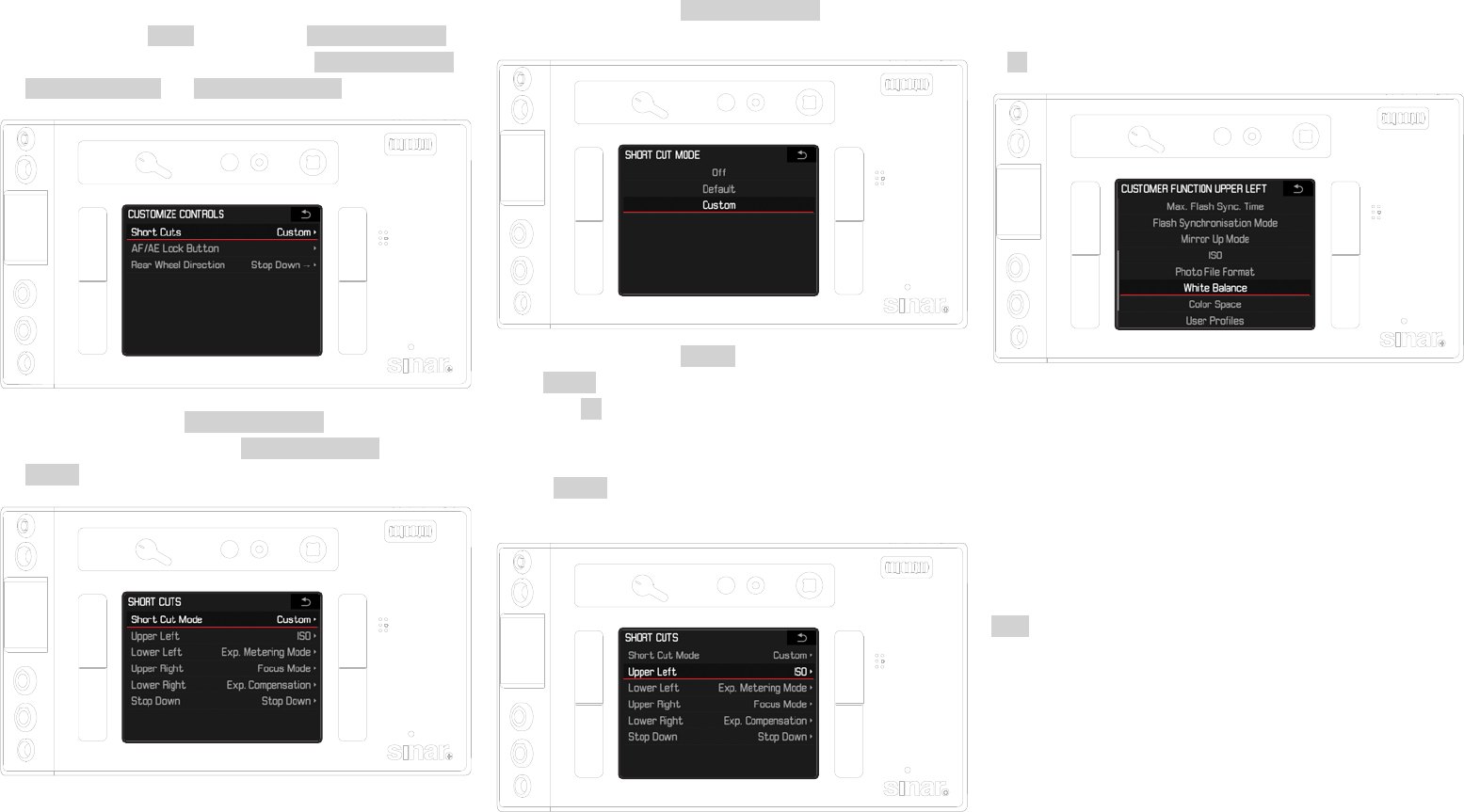
Setting the function / customizing the buttons
1. In the menu, under SETUP, select the item Customize Controls
• A sub-menu appears with the three items Customize Controls,
AF/ AE Lock Button and Rear Wheel Direction.
2. In this sub-menu, select Customize Controls
• A further sub-menu appears. If Customize Controls is not set to
Custom, all the other items are inactive.
3. In this sub-menu, select Customize Controls
• A further sub-menu appears.
4. In this sub-menu, select Custom
• (or Default if the factory setting of the button functions is to be
used, or Off if the function is to be deactivated)
• The menu displayed in step 2. appears again.
5. In the Custom sub-menu, select the desired button
• A list with the available menu functions is displayed.
6. In the respective sub-menu, select the function you wish to call up
or execute directly in future with the button selected in step 5, or
Off if you do not wish to assign a quick access to this button
The other buttons are customized in the same way.
• The menu displayed in step 2. then appears again.
Calling up the selected menu functions
You can then call up or execute the respective set (menu) functions
directly at any time and make further settings there:
Hold the buttons alongside the monitor pressed (≥ 1 s), or in normal
photo recording mode press the depth of field preview button
Note:
In Live View (photo) and video mode the depth of field preview button
is assigned other functions, i.e. the quick access function that may
have been set is not available in these modes. After exiting the re-
spective operating mode, the depth of field preview button has the
previously assigned function again.
3 — The menu control
3 — Changing the battery

Presets
Camera default settings
Menu language
The language used in the default setting of the menu control is En-
glish, German, French, Italian, Spanish, Russian, Japanese, Chinese
Trad, Chinese Simp, Korean and Portuguese can also be selected as
alternative menu languages.
Setting the function
1. In the menu under SETUP, select the item LANGUAGE and
2. Select the desired language in the sub-menu.
• Apart from a few expections (button names, short designations),
all linguistic information changes.
Date and Time
There are 3 options available for the sequence of the date.
Setting the function
1. In the menu, under SETUP select the item DATE&TIME and
2. call up the sub-menu
3. Select DATE SETTING and call up the corresponding sub-menu
4. To change the representation DAY/MONTH/YEAR, MONTH/DAY/YEAR
or YEAR/MONTH/DAY press the Joystick up or down or turn the rear
thumbwheel with the header line active.
5. Pressing the Joystick to the left or right takes you out of the
marked header line to the three setting fields below, or back to the
headerline.
6. In the respective marked setting field, make the settings by press-
ing the Joystick up or down or by turning the rear thumbwheel.
7. Confirm and save the settings by pressing the button marked OK
in this case at the bottom right next to the monitor.
Time
Setting the function
In sub-menu item TIME-SETTING the settings are made for both the
numerical groups and for the representation in essentially the same
way as described in the previous section for the date.
Of the other three items in the DATE&TIME sub-menu, DAYLIGHT SAV-
ING TIME is activated or deactivated by pressing the rear thumbwheel
or the Joystick forward or to the right, while under TIME ZONE the
desired location is selected from the list in the corresponding menu
by turning the rear thumbwheel or pressing the Joystick up or down.
Notes:
• Even if no battery is inserted or the battery is discharged, the date
and time settings are retained for roughly three months by an inte-
grated back-up battery (see also “Charge level displays”). After that
period, however, the date and time must be set again as described
above.
Auto power OFF
This function turns the camera off automatically after a preset time.
This state corresponds to the main switch position OFF.
Setting the function
1. In the menu, under SETUP, select the item AUTO POWER SAVING
and
2. set the desired time
Note:
Even if the camera is in standby mode, i.e. the displays have gone out
or the activated AUTO POWER SAVING function has turned it off, it can
be reactivated at any time by pressing the shutter button.
3 — The menu control
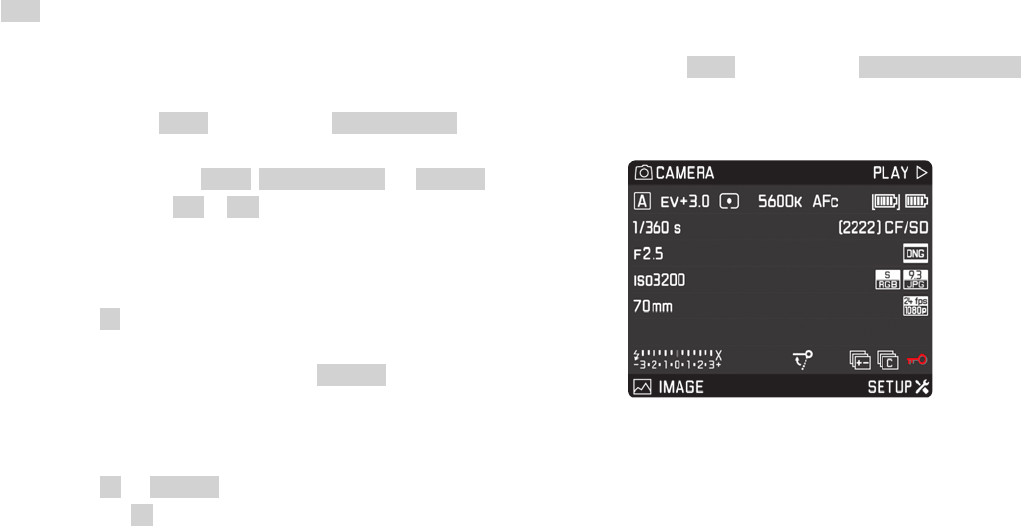
Signal tones
With the Sinarback S 30|45 you can decide whether messages or
autofocus mode should be confirmed by acoustic signals, or wheth-
er the camera operation should be more or less silent. Two volumes
can be selected. The feedback is a beep tone that can be activated
separately for autofocus mode to indicate the completed setting and
as a signal for a message or warning.
Note:
In the factory setting the signal tones are deactivated.
Setting the functions
1. In the menu, under SETUP , select the item Acoustic Signals and
2. call up the sub-menu
It consists of the 3 items Volume, AF Confirmation and Warnings.
3. Under volume select Low or High
4. In the other sub-menus select whether or not you wish to activate
the tones for the respective functions
If you select On
With AF confirmation a signal sounds as soon as the focus – whether
automatic or manual – is set correctly. With Warnings a signal sounds
together with all messages and warnings displayed in the monitor,
and on expiry of the self-timer.
If you select Off for Warnings
Even if you select Off, an acoustic warning signal is nevertheless
given in one situation:
• If the cover over the memory card slots is opened during data
transfer.
Monitor
The monitor shows the complete image field, along with the selected
data and information (see “Displays in the monitor” ). The brightness
of the monitor is controlled automatically, depending on the ambient
brightness. The sensor above the monitor is used for this function.
Further- more, its basic brightness can be adapted to the respective
situation or to your personal wishes.
Setting the functions
1. In the menu, under SETUP , select the item DISPLAY BRIGHTNESS
and
2. select the desired setting in the sub-menu
3 — Changing the battery

PICTURE DEFAULT SETTINGS
Photo file format
Two file formats, DNG and JPEG, are available for recording the
picture data for photos. You can choose whether your picture data
are to be saved
a. in just one of these formats, or
b. simultaneously in both formats (i.e. two les are always created per
picture).
Setting the function
1. In the menu, under IMAGE, select the item Photo File Format and
2. select the desired format(s) or combination in the sub-menu
Notes:
• The standardized DNG (Digital Negative) format is used for storage
of raw picture data.
• The remaining number of pictures shown in the monitor may not
necessarily change after every picture. This depends on the sub-
ject; with JPEG files very fine structures result in higher quantities
of data, homogeneous surfaces in lower quantities. As a result the
remaining memory capacity may be larger than previously calculat-
ed and displayed.
JPEG SETTINGS
Resolution
Whereas the full resolution of 37.5 MP is always used in DNG format,
two lower resolutions can also be used with the JPEG format.
Setting the function
1. In the menu, under IMAGE, select the item JPG Resolution and
2. select 37.5MP , 9.3MP or 2.3MP in the sub-menu
Working color range
The Sinarback S 30|45 allows one of three color ranges to be set, i.e.
sRGB, AdobeRGB or ECI RGB 2.0.
Setting the function
1. In the menu, under IMAGE, select the item JPG Settings
2. then the menu item Color Space, and
3. select the desired color range in the sub-menu
Picture properties / contrast, sharpness, color saturation
All three picture properties can be set – independently - to three
different levels (with color saturation four) using the menu control, so
that you can set the optimum values for any situation, i.e. the prevail-
ing lighting conditions. In the case of Saturation, Monochrome can
also be selected as a fourth variant.
Setting the functions
1. In the menu, under CAMERA , select the item JPG Settings and
2. call up the sub-menu
3. In this sub-menu select Contrast, or Sharpness, or Saturation,
and
4. select the desired level (Low, Medium, High or Monochrome) in the
respective sub-menu
WHITE BALANCE
In digital photography, white balance ensures neutral rendition of col-
or in any light. It is based on the camera being preset to reproduce
a particular light color as white. In the Sinarback S 30|45 you can
select between twelve different settings:
• (Auto) – for automatic control, which delivers neutral results in
most situations,
Eight fixed presets for the most frequent light sources:
• e.g. for outdoor pictures in sunshine,
• e.g. for outdoor pictures with cloudy skies,
• e.g. for outdoor pictures with the main subject in shadow,
• e.g. for indoor pictures with (predominantly) incandescent lamp
light
• e.g. for indoor pictures with (predominantly) light from metal
halide lamps (HMI)
• e.g. for (predominantly) light from fluorescent tubes with warm
light color
• e.g. for (predominantly) light from fluorescent tubes with cooler
light color
• e.g. for pictures with (predominantly) electronic flash lighting,
Two Greycard settings for manual setting by metering (separately
for the Live View and the normal photo mode )
• Color Temperature1 – for direct setting of a color temperature
value.
3 — The menu control
Example, either plus or minus, “X” stands for the respective value
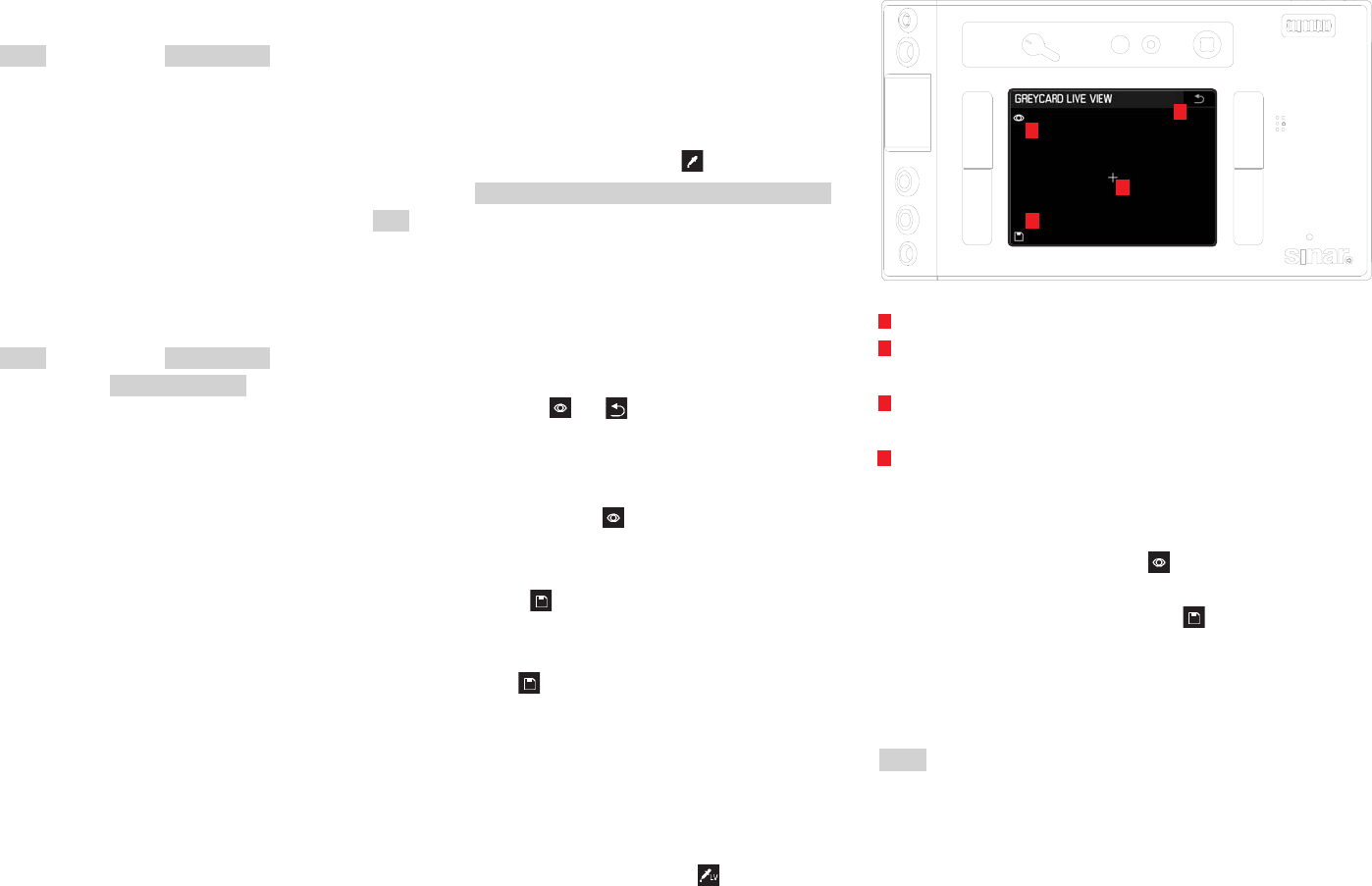
Setting the function
Automatic and fixed settings
1. In the menu, under IMAGE, select the item White Balance and
2. select the desired function in the sub-menu
Direct color temperature setting
You can directly set values between 2000 and 13100 (K1) (from 2000
to 5000K in increments of 100, from 5000 to 8000K in increments
of 200 and from 8000 to 13,100K in increments of 300). This pro-
vides you with a broad scope, covering most of the color tempera-
tures occurring in practice and within which you can adapt the color
reproduction to the prevailing light color and/or your personal pref-
erences.
1. In the menu, under IMAGE, select the item White Balance,
2. in the sub-menu select the variant Color Temperature, and
• A further sub-menu appears with a list in which the value to be
set is indicated by the red border.
3. select the desired value there.
Manual setting by metering
1. In the menu, under IMAGE, select the item WHITE BALANCE and
2. select the desired greycard variant in the sub-menu
The further procedure differs, depending on the greycard variant.
If you have selected the normal photo mode :
• The message Please take a picture for setting the white bal-
ance appears in the monitor.
3. Take the picture, making sure that the image field contains a white
or neutral gray (reference) surface.
• The monitor shows
• the image based on the automatic white balance setting,
• cross hairs in the center of the image.
• the button functions and valid in this situation
4. Press the Joystick in the desired direction to move the cross hairs
to the subject detail you want to use as the basis for the new white
balance setting (e.g. the reference surface mentioned above)
5. Press the button alongside the display, or press the Joystick
forward.
• The color reproduction of the picture is adapted accordingly and
the button function valid in this situation is also displayed.
6. You can now either
• either accept this new white balance setting by pressing the but-
ton alongside the display,
• The message White balance is set appears in the monitor.
• or make any number of further settings, as described under 3. -
6.
• The message described under 3. appears each time in the
monitor.
If you have selected the Live View photo mode :
• The corresponding screen appears in the monitor.
Indication of button function: Perform white balance metering
Indication of button function: Save white balance metering (active
only after metering)
Indication of button function: Back to normal photo mode (without
saving any metered value)
Display of the metering field
3. Move the metering field to a white or neutral gray subject detail by
pressing the Joystick in the desired direction
4. Carry out metering by pressing the button at top left next to the
monitor, or by pressing the Joystick forward
5. Save the metered value by pressing the button at bottom left
next to the monitor
• The camera switches back to the normal photo mode and the
monitor image disappears.
Notes:
• The corresponding picture is always saved parallel to a saved white
balance setting.
• A value set in this way remains saved for and will be used for all
pictures until it is superseded by a new metered value or you use
one of the other white balance settings.
3 — Changing the battery
1
2
3
4
1
2
3
4

ISO sensitivity
The ISO setting on the Sinarback S 30|45 allows a manual adjust-
ment of the shutter speed/aperture values to the needs of the par-
ticular situation. As well as the fixed settings, the Sinarback S 30|45
also features the ISO Auto1 function, if the main-switch is set to ON/
ES. The camera automatically adjusts the sensitivity to the ambient
brightness. When using the function, however, it is also possible to
specify priorities, for example for compositional reasons. You can
both limit the range of sensitivities used and set the shutter speed
below which the sensitivity is automatically increased.
Notes:
A general rule of thumb in digital photography is that higher sensitivi-
ties result in increased noise. This has to be taken into consideration
for the expectations on the picture quality. Note with picture series
that the frame rates decrease with higher sensitivities.
Setting the function
1. In the menu, under IMAGE, select the item ISO and
2. call up the sub-menu
It consists of the available ISO values and the point ISO Auto.
If you wish to set the sensitivity manually
3. select the desired value
If the sensitivity setting is to function automatically and without lim-
itations
4. select ISO Auto.
The automatic setting uses all sensitivities and shutter speeds
between 1⁄2 s and 1⁄500s
To restrict the automatic setting range
1. In the menu, under SETUP, select the item Auto ISO Setup and
2. select Auto ISO Photo in the sub-menu
3. Select Maximum Auto ISO and/or Maximum Exposure Time
• When setting Maximum Auto ISO, a list with the available values
appears, when setting Maximum Exposure Time a further sub-
menu with several alternatives.
4. In the Maximum AUTO ISO menu list, select the highest sensitivity
to be used, and hence the range within which the automatic set-
ting is to operate, or in the Maximum Exposure Time sub-menu
set either one of the three focal length-specific settings - 1/f, 1/
2f, 1/4f or the desired slowest shutter speed. With the 1⁄f settings
the camera switches to the higher sensitivity if the shutter speed
would drop below the selected threshold due to a lack of bright-
ness, e.g. with a 70 mm lens with shutter speeds lower than 1⁄60s
(with 1⁄f (f=focal length)), or 1⁄125s with 1⁄2f, or 1⁄250s with 1⁄4f *.
Note:
The factory setting of 1⁄2f results in the slowest shutter speeds
according to the rule of thumb adapted for this format for blur-
free pictures taken from the hand, e.g. 1⁄125s with the Summarit-S
1:2.5/70mm ASPH lens. The corresponding shutter speeds with 1⁄2f
and 1⁄4f in this example would be 1⁄60s and 1⁄250s.
Storage of picture data / memory card management
If two memory cards are used, you have the possibility with the Sinar-
back S 30|45 to choose
• whether the picture data should first be stored on one of the two
cards until its capacity is reached, and then on the other card, or
whether the data should
• always be stored simultaneously on both cards.
Setting the function
1. In the menu, under SETUP , select the item Storage Backup (CF &
SD) and
2. there select Off or On
Note:
If Off is selected:
• The picture data are first stored on the SD/SDHC/SDXC card and
then once its capacity is reached on the CF card. As soon as the
camera is connected to a computer, it stores the picture data only
in the specified folder on the computer.
If On is selected:
• The picture data are stored simultaneously on both cards.
With both settings:
• If only one card is used (irrespective of which), the picture data are
stored there.
3 — The menu control
Example, either plus or minus, “X” stands for the respective value

RECORDING MODE
For Photos
Sinarback S 3045 is designed for the work with a View Camera.
It supports the following shutter-systems:
1. Sinar eShutter
2. Copal-Shutter
3. Sinar S-CS-Adapter
The configurations are explained in detail on the following pages
General information: Live View mode
Live View mode permits continuous viewing of the subject on the
monitor, i.e. both before and during recording. Live View mode is
switched on and off, and video mode is switched on (without starting
recording) with the LV button. Pressing the button displays the func-
tions in turn (in an endless loop) .
Live View photo / video mode / conventional photography mode
• When switched on, the functions of the adjacent buttons are dis-
played for 3 seconds in the four corners of the monitor picture.
• Video mode is always performed using the monitor picture.
Notes:
• Additional autofocus and exposure metering function variants can
be used according to camera configuration during Live View mode,
see the corresponding sections.
1. Live View mode is based on the image captured by the sensor. To
use it, the shutter must be open.
2. Depending on camera configuration the shutter is opened auto-
matically or has to be opened by hand.
3. Frequent use of the Live View mode results in increased power
consumption.
Exposure simulation
In the factory setting, the Live View monitor picture shows a monitor
picture with constant brightness, irrespective of the exposure set-
tings. The “generally” constant brightness presupposes, however,
that the subject brightness and the set exposure do not result in any
excessively high or low brightness values, and that the internal expo-
sure time is not longer than 1⁄30s.
Displays in Live View mode
With the standard setting, the Live View monitor picture contains
the following displays (see “The displays / In the monitor / Recording
mode Live View photo”):
• In the header some fundamental information
• In the corners of the picture, symbols for the functions of the but-
tons alongside the monitor: = Review, = Change of display, =
Magnify and = Menu
• Spot autofocus meteringfield (+ autofocus metering crosshair)
• Autofocus metering crosshair Exposure simulation or = Button
lock
• Exposure simulation
• Or Button lock
Display settings
Repeatedly pressing the button bottom right next to the monitor calls
up various additional displays/information in turn:
• Histogram and clipping indicators
• Marking of clearly focused subjects
• Grid lines and horizon
• Extended picture data
• Back to the normal
Histogram
The histogram depicts the brightness distribution in the picture. The
horizontal axis shows the brightness values from black (left) through
gray to white (right). The vertical axis corresponds to the number of
pixels at each brightness level. This form of representation – togeth-
er with the impression of the picture itself – provides an additional
quick and easy assessment of the exposure setting.
Clipping displays
These displays indicate the picture areas without marking.
Setting the function
1. In the menu, under SETUP , select the item Capture Assistants
and
2. select Exposure Clipping in the sub-menu
3. In the sub-menu select Lower Limit or Upper Limit, and
4. set the desired threshold values on the scale by turning the rear
thumbwheel or by pressing the Joystick to the left or right
• The scale shows the clipping areas relative to the overall expo-
sure range.
The following then appears in the pictures:
• Excessively light areas are indicated in red, excessively dark areas
in blue, flashing in each case. The clipping symbol ([ ]) also appears
in the top right corner.
Notes on the histogram and the clipping indicators:
• Both are available also in Review mode.
• Both always refer to the currently displayed detail (see “Enlarging
the Live View monitor image”).
3 — Changing the battery

Marking of clearly focused subjects (focus peaking)
In Live View mode, the Sinarback S 30|45 can mark subjects imaged
with optimum focus in the monitor picture by highlighting their con-
tours. This simplifies their recognition and hence in particular the
manual setting of the focus. The three available colors permit adap-
tation to any background.
Setting the function
1. In the menu, under SETUP, select the item Capture Assistants
and
2. select Focus Peaking in the sub-menu
3. Call up the sub-menu, and
4. select the desired color there
• All subject details that are in focus at the set range are indicated
by outlines in the selected color.
Further information on setting the focus can be found in the corre-
sponding sections.
Note:
When using high ISO values and/or slow shutter speeds, the function
may not work.
Important:
This function is based on the subject contrast, i.e. light/dark differ-
ences. Therefore, subject details that are not completely in focus but
have a high contrast may also be marked.
Grid
The Sinarback S 30|45 offers you two variants of grid lines as an aid
to picture composition.
Setting the function
1. In the menu, under SETUP, select the item Capture Assistants,
2. select Grids in the sub-menu, and
3. select 3x3 or 6x4 in the sub-menu
• If the view with horizon and grid is selected, the selected grid is
displayed in the monitor.
Masking
In addition to the standard aspect ratio (2:3) for photos, three further
ratios are available when using the DNG format: 1:1, 16:9, 2:1. They
open up further composition possibilities while taking the picture.
Setting the function
1. In the menu, under SETUP, select the item Capture Assistants,
2. select Photo Masks in the sub-menu, and
3. select the desired format there
• The monitor picture is masked accordingly, with 1:1 left and right,
with 16:9 and 2:1 top and bottom. While taking the photograph
the mask is transparent, during review of corresponding photos
in the camera it is not.
Note:
Irrespective of the aspect ratio selected, the whole 2:3 image field is
always recorded, i.e. the masking of the monitor picture a ects only
the display in the camera. Although the photo is initially displayed
with the selected aspect ratio in image processing programs, it is
possible to delete the masking there so that the whole 2:3 image
field is available again.
Enlarging the Live View monitor image
Select differently enlarged details:
Press the button bottom left next to the monitor repeatedly
• This gives in turn
• Double the size
• Four times the size
• Back to normal size
• The buttons are not displayed with the enlarged view; a frame ap-
pears in the bottom left-hand corner that indicates the position of
the detail in the picture.
Shift the detail:
Press the Joystick left, right, up or down
Notes:
• The grid line display is not available with the enlarged view.
• After switching Live View mode o and on again, the last displays
selected are active again, but not the enlarged detail.
• Switching the camera off and on again displays the last detail se-
lected.
3 — The menu control
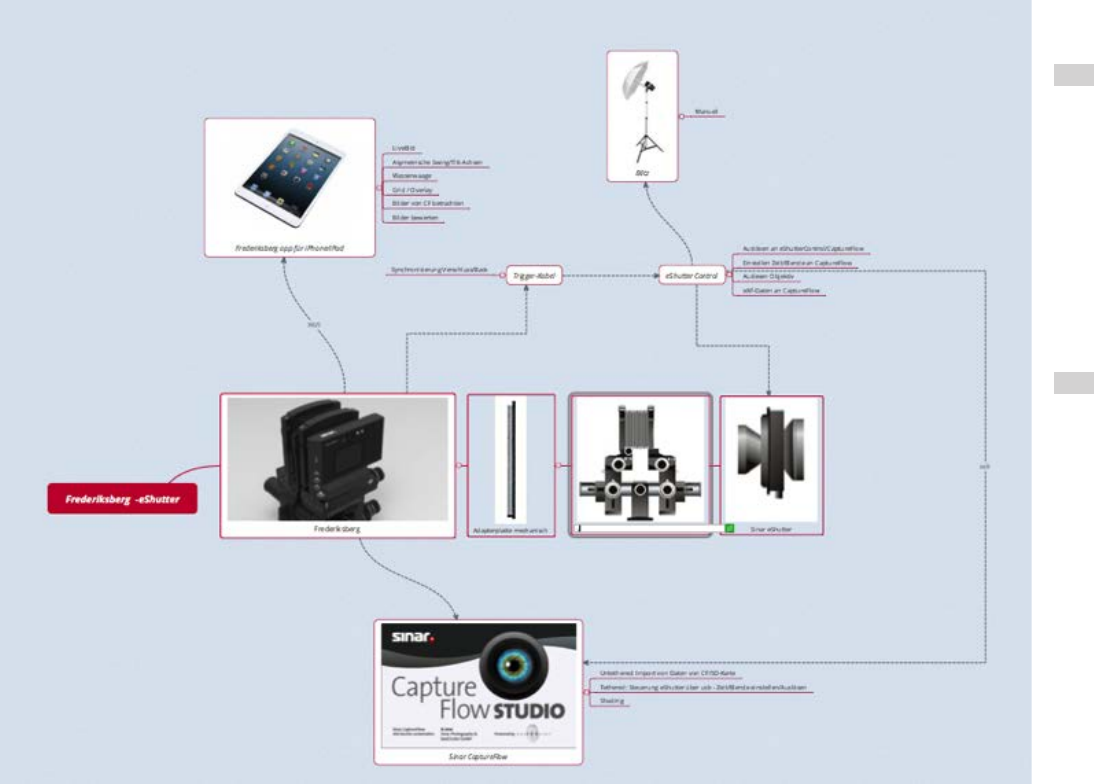
3 — Changing the battery
SINARBACK S AND SINAR ESHUTTER
Setting up hardware
1. Set Main switch to position: CPL
2. Connect Sinar eShutter/S30|45 Triggercable 50 (S07013) to Sinar
eShutter Control (S04620) and connect it to the Trigger In socket
of your Sinarback S 30|45.
3. Connect eShutter Control and
4. Sinarback S 30|45 to the same computer via usb.
Note:
• Flash-Units have to be connected to eShutterControl (S04620)
Please refer to manual of eShutter.
Recording Photos
As Sinar eShutter requires to be connected to a computer via usb,
tethered mode is supported, only.
Sinar eShutter and Sinarback S 30|45 are remote-controlled using
the software Sinar Capture Flow.
Note:
• Sinarback S 30|45 is equipped with a shutter button. It has no func-
tionality as a shutter button in this configuration.
Setting and using the functions
1. Activate Live View in Sinar Capture Flow software for setting up
camera and compose your picture.
2. Set exposure time and aperture in Sinar Capture Flow software.
3. Use the controls in the software for taking images. In tethered
mode the images are stored on your computer.
Configuration Chart
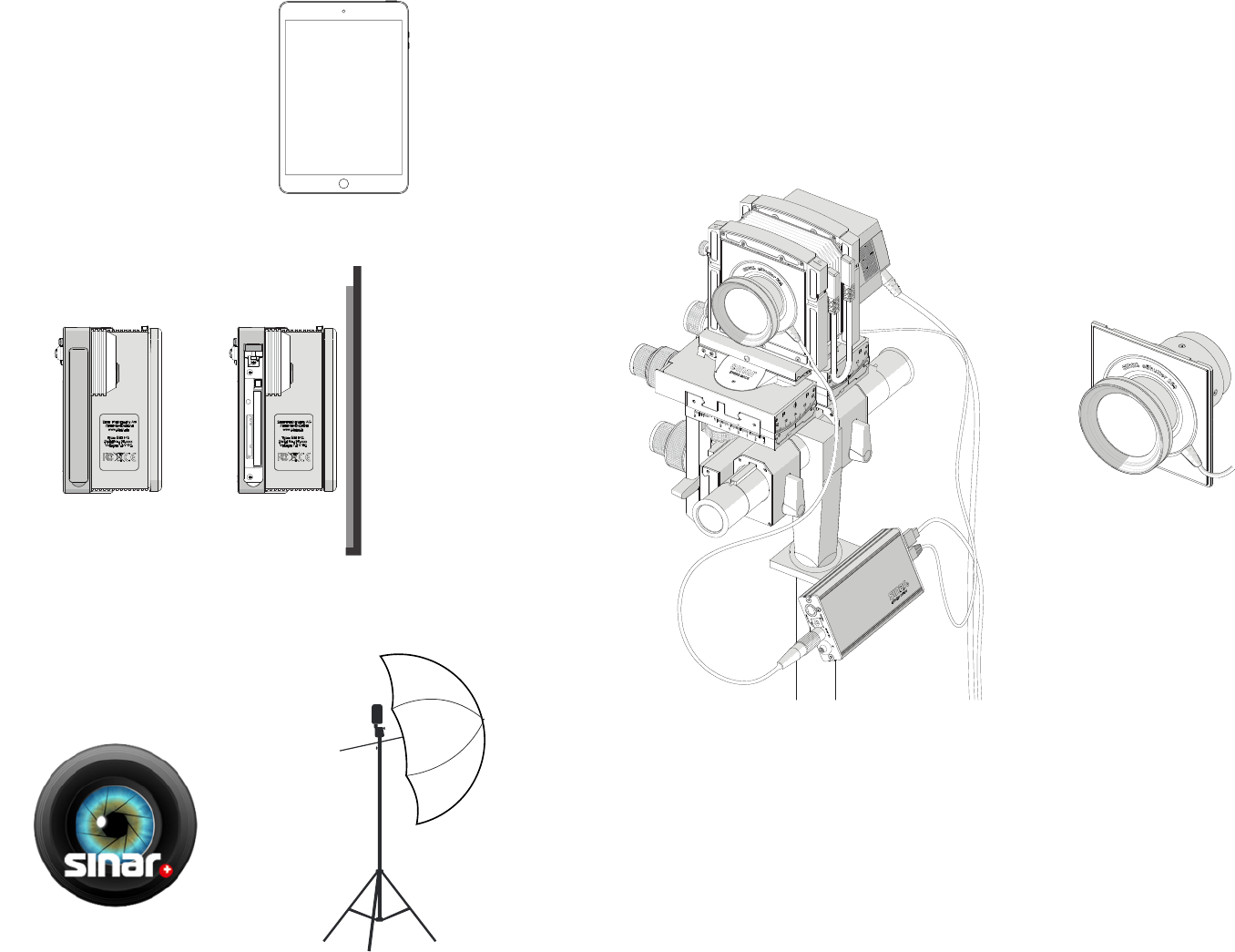
3 — The menu control

3 — Changing the battery
Configuration Chart

3 — Changing the battery
COPAL SHUTTER
Setting up hardware
1. Set Main switch to position: CPL
2. Mount Wake-Up Kabel S 30|45 (S09100) on your Copal-Shutter
and connect it to your Sinarback S 3045 on Trigger In
Recording Photos
Sinarback S 3045 in combination with Copal-shutter can be used in
tethered and untethered operation mode.
Setting and using the functions
1. Tethered operation:
Sinarback S 3045 is connected to a computer via usb and images
are stored on the computer.
2. Untethered operation:
The mechanical Copal-shutter is used for taking the picture and
Sinarback S 3045 images are stored on CF-card.
Setting and using the functions
1. Activate Live View for setting up camera and compose your pic-
ture.
2. Open the Copal-Shutter.
Live View mode is based on the image captured by the sensor. To
use it, the shutter must be open.
3. Close the Copal-Shutter and
4. Deactivate Live View when you are satisfied with your image com-
position.
5. Set exposure time and aperture on Copal-shutter.
6. Take images by using Wake-Up Cable S 30|45 (S09100)
Note:
• Sinarback S 30|45 is equipped with a shutter button. It has no func-
tionality as a shutter button in this configuration.
Wake Up
Sinarback S 3045 requires a Wake-Up-Signal before Copal-Shutter
is released and pictures can be taken.
Note:
• Press Wake-Up Cable S 30|45 (S09100)Pre Release Triggerkabel
sin-440.013-260 steadily. If Wake-Up Cable S 30|45 (S09100) is
pressed too steadily Sinarback S 3045 might not indicate a Wake-
Up-Signal and synchronization with the shutter will not work cor-
rectly. The error-message “Image could be corrupted” indicates
that Sinarback S 30|45 has not received clear signals In this case
please wait 10 seconds and try again with pressing Wake-Up Cable
S 30|45 (S09100) more briefly.
Configuration Chart

3 — Changing the battery
SINAR INDUSTRIAL BOX
Setting up hardware
1. Set main switch to position: ON/ES
2. Mount Sinarback S 30|45 to Industrial Box
Sinar Industrial Box is an adapter that allows to use the well designed
Leica S-Lenses CS in combination with Sinarback S 3045.
Most of the functionality of the Leica S system is given.
Configuration Chart

Shutter Button
1. Pressing briefly activates the range and exposure metering sys-
tems. When the shutter button is released, the metering systems
remain active for approx. 12 s.
Note:
• If Review mode was previously active, the camera switches back
to Recording mode when the shutter button is pressed; if it if was
previously in Stand-by mode, it is activated again by pressing the
shutter button, i.e. the metering systems and displays are activated.
• The shutter button remains blocked
• if the internal buffer memory is temporarily full, e.g. after a series
of pictures, or
• if the inserted memory card(s) is/are full.
2. Pressing the shutter button to the pressure point and holding in
this position when using Autofocus AFs mode (focus priority), the
focus is saved at the same time. New measurements can be per-
formed once the shutter button is released.
Note:
• The metered exposure value during spot and center weighted me-
tering in A, T and P modes is saved, if required, by (simultaneously)
pressing the Joystick forwards. Automatic focusing can also be
allocated to the Joy- stick via the menu control.
3. If the button is pressed further, the photo is taken or a preselected
self-timer delay time starts.
Picture Series
With all S lenses, the Sinarback S 30|45 offers you the choice be-
tween manual or automatic distance setting. The autofocus system
determines the distance to the subject details in the middle of the
image field; this area is marked with a crosshair, in Live View mode,
and in the monitor.
With the Sinarback S 30|45, the picture series can be taken with a
frame rate of approx. 3.5 fps.
Setting and using the function
4. In the menu, under CAMERA , select the item Drive Mode and
5. select Continuous in the sub-menu
6. The further function is then determined by the different actuation
of the shutter button:
• Picture series are taken as long as you hold the shutter button
fully depressed (and the capacity of the buffer memory and/or
memory card(s) is sufficient).
• If you only fully depress the shutter button briefly, the camera
continues to take single pictures.
Interval Shooting
For picture series of sequences extending over a prolonged period
of time, the Sinarback S 30|45 offers interval shooting. Intervals
consist of a defined total number of pictures and a defined period of
time between the pictures.
Setting and using the function
1. In the menu, under CAMERA , select the item Drive Mode and
2. select Interval in the sub-menu
3. Call up the sub-menu belonging to the interval and
4. there select Frames or Interval Time
• In both cases a further sub-menu appears with a numerical key-
pad. The activates field is highlighted in each case.
5. Select the (first) desired digit by turning the rear thumbwheel or
by pressing the Joystick up, down, to the left or to the right; in the
Frames sub-menu for the total number of pictures, in the Interval
Time sub-menu for the desired time interval between the individual
pictures – in hours/minutes/seconds.
• To save a digit – to the line above the numerical keypad - press
the rear thumbwheel or the Joystick forwards. Up to 4-digit num-
bers can be used; repeat steps 5. and 6. for the second, third and
fourth digits. Further functions of this sub-menu:
• (top right) = Back to the previous menu level without saving
the inputs
• OK (bottom right) = Con rm inputs and return to the previous
menu level
6. Confirm your settings by pressing the button marked SET in this
case at the bottom right next to the monitor
Note:
• If step 7. is performed without entering a digit in the line, the camera
automatically sets the numbers of the factory setting.
7. Interval shooting is started by pressing the shutter button.
Note:
• The function remains active until it is deactivated again in the
menu.
Notes that apply equally for photo series and interval shooting:
• The camera’s buffer memory allows only a limited number of pic-
tures in series. At the pressure point of the shutter button or during
a series of pictures, the number of pictures possible or still possi-
ble in the series is displayed in the view nder. Und auf dem Monitor?
• Regardless of how many pictures have been taken in a series, both
review modes initially show the last picture in the series or the last
picture in the series saved on the currently active card, if not all of
the pictures in the series have been transferred from the internal bu
er memory to the respective card yet.
•
Details of how to select the other pictures in the series and further
options in review mode are described in the respective sections.
3 — The menu control
Industrial
Box

Live View mode with Industrial Box
Live View mode permits continuous viewing of the subject on the
monitor, i.e. both before and during recording. Live View mode is
switched on and off, and video mode is switched on (without starting
recording) with the LV button. Pressing the button displays the func-
tions in turn (in an endless loop)
Live View photo / video mode / conventional photography mode
• When switched on, the functions of the adjacent buttons are dis-
played for 3 seconds in the four corners of the monitor picture.
• Video mode is always performed using the monitor picture.
Notes:
• Additional autofocus and exposure metering function variants can
be used during Live View mode, see the corresponding sections.
• Live View mode is based on the image captured by the sensor. To
use it, the shutter must be open and it is closed and re-cocked
when the function is canceled. Of course, this is audible and may
result in a delay in the shutter release.
• Frequent use of the Live View mode results in increased power
consumption.
Exposure simulation
In the factory setting, the Live View monitor picture shows the sub-
ject in the brightness resulting from the respective exposure setting.
This expo- sure simulation allows the effect on the picture to be as-
sessed before the photograph is taken, e.g. during exposure correc-
tions or during manual setting of the exposure. With automatic expo-
sure control (P, A, T), on the other hand, the monitor picture generally
remains equally bright, i.e. within the respective setting ranges. The
exposure simulation can be deactivated by pressing the depth of
field preview button so that you generally get a monitor picture with
constant brightness, irrespective of the exposure settings. The “gen-
erally” constant brightness presupposes, however, that the subject
brightness and the set exposure do not result in any excessively high
or low brightness values, and that the internal exposure time is not
longer than 1⁄30s.
Displays in Live View mode
With the standard setting, the Live View monitor picture contains
the following displays (see “The displays / In the monitor / Recording
mode Live View photo”, p. ???):
• In the corners of the picture, symbols for the functions of the but-
tons alongside the monitor: = Review, = Change of display,
= Magnify and = Menu
• Spot autofocus metering eld (+ autofocus metering crosshair)
• Autofocus metering crosshair Exposure simulation or = Button
lock
• Exposure simulation
• or = Button lock
Display settings
Repeatedly pressing the button bottom right next to the monitor calls
up various additional displays/information in turn:
• Histogram and clipping indicators
• Marking of clearly focused subjects
• Grid lines and horizon
• Extended picture data
• Back to the normal
Histogram
The histogram depicts the brightness distribution in the picture. The
horizontal axis shows the brightness values from black (left) through
gray to white (right). The vertical axis corresponds to the number of
pixels at each brightness level. This form of representation – togeth-
er with the impression of the picture itself – provides an additional
quick and easy assessment of the exposure setting.
Clipping displays
These displays indicate the picture areas without marking.
Setting the function
1. In the menu, under SETUP, select the item Capture Assistants
and
2. select Exposure Clipping in the sub-menu
3. In the sub-menu select Lower Limit or Upper Limit, and
4. set the desired threshold values on the scale by turning the rear
thumbwheel or by pressing the Joystick to the left or right
• The scale shows the clipping areas relative to the overall expo-
sure
The following then appears in the pictures:
• Excessively light areas are indicated in red, excessively dark areas
in blue, flashing in each case. The clipping symbol ([ ]) also appears
in the top right corner.
Notes on the histogram and the clipping indicators:
• Both are available also in Review mode.
• Both always refer to the currently displayed detail (see “Enlarging
the Live View monitor image”).
3 — Changing the battery
Industrial
Box

Industrial
Box
Marking of clearly focused subjects (focus peaking)
In Live View mode, the Sinarback S 30|45 can mark subjects imaged
with optimum focus in the monitor picture by highlighting their con-
tours. This simplifies their recognition and hence in particular the
manual setting of the focus. The three available colors permit adap-
tation to any background.
Setting the function
1. In the menu, under SETUP, select the item Capture Assistants
and
2. select Focus Peaking in the sub-menu
3. Call up the sub-menu, and
4. select the desired color there
• All subject details that are in focus at the set range are indicated
by outlines in the selected color.
Further information on setting the focus can be found in the corre-
sponding sections.
Note:
When using high ISO values and/or slow shutter speeds, the function
may not work.
Important:
This function is based on the subject contrast, i.e. light/dark differ-
ences. Therefore, subject details that are not completely in focus but
have a high contrast may also be marked.
Grid
The Sinarback S 30|45 offers you two variants of grid lines as an aid
to picture composition.
Setting the function
1. In the menu, under SETUP, select the item Capture Assistants,
2. select Grids in the sub-menu, and
3. select 3x3 or 6x4 in the sub-menu
• If the view with horizon and grid is selected, the selected grid is
displayed in the monitor.
Masking
In addition to the standard aspect ratio (2:3) for photos, three further
ratios are available when using the DNG format: 1:1, 16:9, 2:1. They
open up further composition possibilities while taking the picture.
Setting the function
1. In the menu, under SETUP, select the item Capture Assistants,
2. select Photo Masks in the sub-menu, and
3. select the desired format there
• The monitor picture is masked accordingly, with 1:1 left and right,
with 16:9 and 2:1 top and bottom. While taking the photograph
the mask is transparent, during review of corresponding photos
in the camera it is not.
Note:
Irrespective of the aspect ratio selected, the whole 2:3 image field is
always recorded, i.e. the masking of the monitor picture a ects only
the display in the camera. Although the photo is initially displayed
with the selected aspect ratio in image processing programs, it is
possible to delete the masking there so that the whole 2:3 image
field is available again.
Enlarging the Live View monitor image
Select differently enlarged details:
Press the button bottom left next to the monitor repeatedly
• This gives in turn
• Double the size
• Four times the size
• Back to normal size
• The buttons are not displayed with the enlarged view; a frame ap-
pears in the bottom left-hand corner that indicates the position of
the detail in the picture.
Shift the detail:
Press the Joystick left, right, up or down
Notes:
• The grid line display is not available with the enlarged view.
• After switching Live View mode o and on again, the last displays
selected are active again, but not the enlarged detail.
• Switching the camera off and on again displays the last detail se-
lected.
3 — The menu control

Distance setting
With all S lenses, the Sinarback S 30|45 offers you the choice be-
tween manual or automatic distance setting. The autofocus system
determines the distance to the subject details in the middle of the
image field; this area is marked with a crosshair, in Live View mode,
and in the monitor.
Note:
The metering system operates passively on the basis of contrasts,
i.e. differences in light/dark in the part of the subject being photo-
graphed. It is therefore dependent on a certain minimum brightness
and contrast in the subject.
Setting the operating mode
1. In the menu, under CAMERA, select the item Focus Mode and
2. select the desired option in the sub-menu
Manual setting - MF
Turn the distance setting ring on the lens so that your subject or the
most important part of the subject is fully in focus, in Live View mode,
and on the monitor.
In Live View mode you can call up an enlarged detail as a setting aid.
1. In the menu, under SETUP, select the item Capture Assistants,
2. select Manual Focus Assist in the sub-menu, and
3. select On or Off there
• If the function is activated, a central detail magnified 4x is dis-
played briefly each time the setting ring on the lens is turned. The
detail can be moved using the Joystick.
Notes:
• Autofocus mode can be activated at any time also with manual
setting of the focus using the Joystick (see next section and the
section on the function of the Joystick on page xy).
AFs (single) = focus priority
The part of the subject you are aiming at will come into focus.
• After that, the process ends and the setting is saved even if you
continue to hold the shutter release button at the first pressure
point.
• It is not possible to take a picture before it comes into focus, even if
the shutter button is pressed all the way down.
Note:
An AF setting can be stored not only with the shutter button, but also
with the Joystick.
AFc (continuous) = shutter release priority
The parts of the subject being photographed are fully focused.
• The process continues as long as the shutter release button is held
at the first pressure point. While the button is being held down the
camera’s settings are corrected, so other objects at other distanc-
es may be recognized by the metering system, or if the distance to
the camera of the part of the subject being photographed changes.
• A setting can only be saved by pressing the Joystick forwards.
• Even if no part of the subject is in focus, a picture can be taken at
any time.
Note:
You can intervene manually at any time even during autofocus mode
by turning the setting ring on the lens.
• In Live View mode the color of the metering crosshair in the mon-
itor changes from red to green when the focus has been correctly
set.
Moving the autofocus metering field in Live View mode
In Live View mode, the metering field can be moved to any point of
the image field with the Joystick. In the two enlarged details, the
detail is first moved together with the metering field that remains in
the middle. Only when the detail reaches the edge of the image field
can the metering field by moved to the edge of the detail by pushing
further.
Note:
If Spot is used as exposure metering method in Live View mode, its
metering field is coupled to that of the autofocus, i.e. both metering
fields are then moved.
3 — The menu control
Industrial
Box

Exposure metering
Exposure metering methods
The Sinarback S 30|45 offers three different exposure metering
methods.
Setting the function
1. In the menu under CAMERA, select the item Exp. Metering, and
2. select the desired option in the sub-menu
Spot metering
Only the middle of the image field is scanned and evaluated for spot
metering. This area is indicated by the circle1 in the center of the
matt screen. In Live View mode, spot metering is linked to the aut-
ofocus metering, i.e. moving the AF metering point also affects the
spot metering field.
Center weighted metering
This metering method takes account of the entire image field, al-
though the parts of the subject in the center have more influence on
the exposure than the areas at the margins.
Multi-field metering
This metering method is based on detection of five metered values.
One is metered in a field in the middle of the image, the other four
in the surrounding fields. The five metered values are used in an
algorithm to calculate an exposure value appropriate to the situation,
resulting in correct reproduction of the assumed main subject.
Exposure Control
The four exposure modes automatic program (P), aperture priority
(A), shutter speed priority (T) and manual exposure control (M) are
selected on the Sinarback S 30|45 with the rear thumbwheel:
Setting the operating mode
1. Hold the thumbwheel depressed (≥ 1 s)
• In the monitor, the large letter indicating the set operating mode
replaces the normal display. Triangles to the left and right indi-
cate the further settings.
2. Turn the thumbwheel (all four operating modes can be reached in
both directions)
• The settings of shutter speed and aperture are made by turning
the rear thumbwheel and/or the shutter speed setting dial. In
both cases half-steps are available.
Settings for aperture and exposure time are made with the rear dial
switch. Half-steps are available. In order to change between aperture
and exposure time press the rear dial switch.
In the factory setting, turning the rear thumbwheel to the right de-
creases the aperture settings, turning to the left increases the set-
tings. This can be reversed, if desired.
Setting the function
1. In the menu, under SETUP, select the item Customize Controls
and
2. select Rear Wheel Direction in the sub-menu
• A further sub-menu appears.
3. In this sub-menu, select the desired direction of rotation
The function of both thumbwheels can be deactivated for complete
protection against inadvertent changing of operating mode, shutter
speed, aperture, etc., i.e. turning and pressing do not then change
the settings in recording mode.
Setting the function
1. In the menu, under SETUP, select the item Keylock and
2. select Off or On in the sub-menu
• If On is selected, the corresponding symbol appears in the top
panel display, and in Live View mode also in the monitor
Automatic Program Mode -P
Exposure time and lens aperture are automatically set according to
the prevailing light and steplessly between 125 s, 1⁄1000 s.
Displays on monitor
• P for the selected exposure operating mode, and
• the automatically controlled shutter speed and aperture values.
Notes:
• If the automatic sensitivity setting (AUTO ISO) is activated at the
same time, the control range of automatic program mode is ex-
tended. Even with fully open aperture, however, the shutter speed is
only extended beyond the value dictated by the 1/f1 setting select-
ed in the menu when the highest set sensitivity is reached.
• With very little light or extreme brightness it is possible that the
avail- able shutter speed range is no longer sufficient for the pre-
selected aperture value. In such extremely rare cases a warning
symbol for underexposure appears in the viewfinder (possibly also
as a warning of values below the metering range, see also “Values
below the metering range”), or a warning symbol for overexposure.
Correct exposure metering is then no longer possible.
3 — Changing the battery
Industrial
Box

Metering memory lock
The shutter button and/or the Joystick can be used to save the expo-
sure setting (for P, A and T) and the automatic focus (AF), depending
on the various menu settings.
General notes on the storage function
• With the shutter button:
• The storage function of the shutter button always applies to only
one picture.
• With the Joystick:
• The exposure and AF settings can be stored. Various function
combinations are available which you define via the menu con-
trol.
• The storage function of the Joystick is retained as long as it is
held pressed forward, i.e. over any number of pictures, and ir-
respective of whether the shutter button is also pressed at the
same time.
Saving with the shutter button
1. Focus on the part of the subject to be metered with the crosshair1
in the viewfinder
2. Press the shutter button to the first pressure point. The value
stored is retained as long as this pressure point is held.
3. While holding the pressure point, determine the final picture detail
and take the
4. picture.
Metering memory lock is canceled when you remove your finger from
theshutter button pressure point.
Saving with the Joystick
Setting the function combinations
1. In the menu, under SETUP, select the item Customize Controls
and
2. select AF/AE Lock Button in the sub-menu
• A further sub-menu appears.
In this sub-menu select whether you wish to set the function for In AF
Mode or In MF Mode set via the menu
In AF mode
3. In the AF-Mode sub-menu, select one of the three variants
Effect of the three function variants:
• AF/AE lock (factory setting)
• Shutter release button: AFs setting
• Joystick: Exposure setting, AFs/AFc setting
• AE-L
• Shutter release button: AFs setting
• Joystick: Exposure setting
• AF-L
• Shutter release button: AFs setting
• Joystick: AFs/AFc setting
In MF mode
In manual focus mode you can nevertheless activate AF mode tem-
porarily, i.e. for the particular picture, and/or – depending on the set-
ting - to save the exposure setting by pressing the Joystick forwards.
3. In the MF-Mode sub-menu, select one of the five variants
Effect of the five function variants
• AFs On / AE Lock (factory setting)
AFs mode activated for one picture, saving of the exposure setting
The resulting AF setting remains stored until it is changed by manu-
al adjustment or by pressing the button again.
• AFs on
• As for AFs On / AE Lock, but without saving of the exposure setting
• AFc On / AE Lock
As for AFs On / AE Lock, but with AFc mode
• AFc on
As for AFs On / AE Lock, but without saving of the exposure setting
• AE-L
Saving of the exposure setting
Displays in the viewfinder during saving of the exposure setting
• A light balance appears showing the deviation from the stored
metered value.
• If aperture and/or exposure time are changed during this time, the
respective other value is adapted accordingly and displayed.
Exposure compensation
Exposure compensations are possible in automatic program, shutter
speed priority and aperture priority modes.
Entering and canceling an exposure compensation in the menu
1. In the menu under CAMERA, select the item Exp. Compensation.
• The sub-menu shows a scale with a setting mark highlighted in
red. If it is at a value of O, this means that the function is deacti-
vated.
2. Set the desired value by turning the rear thumbwheel or by press-
ing the Joystick to the left or right.
• In the initial menu list, a set compensation is indicated by EV+X1
Note:
In the factory setting, this function can be called up directly by hold-
ing the button bottom right next to the monitor depressed.
Displays in viewfinder and top panel display, and in Live View
mode also in the monitor (in the picture data display)
• The compensation value on the light balance (viewfinder and mon-
itor)
• A corresponding warning symbol (viewfinder)
• + or - (top panel display)
3 — The menu control
Example, either plus or minus, “X” stands for the respective value
Industrial
Box

Notes:
• Once set, a compensation value is retained even when the camera
is switched off.
• An exposure compensation set on the camera only influences me-
tering of the available light, i.e. not flash light (for more information
about flash photography, refer to the respective sections).
Manual setting of aperture and exposure time - M
Setting the operating mode
1. Select M with the rear thumbwheel (see also p. 30, “Exposure
control”)
2. Set the desired aperture by turning the rear thumbwheel and the
desired exposure time with the shutter speed setting dial
Displays in Live View mode and in monitor
• M for the selected exposure operating mode,
• The manually set aperture and shutter speed values, and
• A light balance with which the exposure compensation is per-
formed. The light balance shows the deviation of the shutter speed/
aperture combination just set from the metered exposure value.
In the range of ±3 EV, the deviation is shown clearly in 1⁄2EV steps.
Larger deviations are indicated by flashing of the outer mark of the
light balance.
For correct exposure according to the exposure meter, vary the
aperture
and/or speed until only the zero mark of the light balance lights up.
Note:
If the automatic sensitivity setting (ISO Auto) is activated at the same
time, the last manually set sensitivity is used. A minimum shutter
speed
that may have been set, however, is not active.
Bracketing
Bracketing can be employed with all four exposure operating modes.
The following are available:
• 2 numbers of pictures: 3 or 5
• Graduations: 0.5EV, 1EV, 2EV and 3EV
Setting the function
1. In the menu under CAMERA, select the item Exp. Bracketing
• The sub-menu appears on the monitor with the four items Exp.
Bracketing, Frames, F-Stops and Automatic, and below this a
scale. If an exposure compensation is set at the same time, this
is indicated by a corresponding value below the scale.
2. For Exp. Bracketing, turn the rear thumbwheel or press the Joy-
stick to left or right to select whether you wish to carry out bracket-
ing (On) or not (Off)
• If On is selected, the other three sub-menu items are activated
(= white).
3. Press the rear thumbwheel or the Joystick forward to call up the
next sub-menu item (the same applies to all sub-menu items)
4. In Frames, set the number of frames, and in F-Stops the desired
exposure graduations between the pictures of the series
• The selected exposures are displayed in red on the scale. An
exposure compensation that may be set is recognizable from
the fact that the whole series around the compensation value is
“offset” from the middle of the scale.
5. In Automatic, select whether you wish to trigger the pictures indi-
vidually yourself (Off), or whether the pictures should all be taken in
series when the shutter button is pressed once (On)
• A set exposure series is indicated in the initial menu list by X / Y
EV1.
6. All pictures are produced by pressing the shutter release button
once or several times.
Note:
The function Exp. Bracketing is not available if an interval shooting
series
has previously been set.
Displays in the viewfinder
• A warning symbol
• The changing displays for shutter speed and aperture correspond-
ing to the graduations
Displays in the monitor (in the picture data display)
• A symbol indicating an exposure series
3 — Changing the battery
Industrial
Box

Notes:
• Depending on the exposure mode, the exposure graduations are
created by changing the shutter speeds and/or apertures.
• The sequence of the exposures is: Overexposure(s), correct expo-
sure, underexposure(s).
• When using automatic bracketing, all ISO Auto settings are fixed:
• The sensitivity automatically determined by the camera for the
uncorrected picture is also used for all other pictures in a series,
i.e. this ISO value is not changed during a series.
• The settings in the AUTO ISO sub-menus have no influence, i.e.
the full shutter speed range of the camera is available.
• Depending on the initial exposure setting, the working range for
automatic bracketing may be limited.
• Regardless of this, the specified numbers of pictures are always
taken, which may mean that at the end of the working range, sever-
al pictures in a series have the same exposure.
• The function remains active until it is deactivated again in the menu
or the camera is switched off.
Values above and below the metering range
If the values are below the metering range of the camera, exact ex-
posure metering is not possible. The metered values that may then
be displayed in the viewfinder can result in incorrect exposure re-
sults. For this reason the display LO always appears in the viewfinder
if the values are below the metering range.
Note:
If the values are above and below the metering range, the time or
aperture
value in the top panel display flashes.
Notes:
• The longest possible exposure time depends on the set sensitivity.
• Long exposure times can be associated with picture noise. To
reduce this annoying phenomenon, the Sinarback S 30|45 au-
tomatically takes a second “black picture” (taken with the shutter
closed) after pictures with slow shutter speeds. The noise present
in this parallel picture is then digitally “subtracted” from the data for
the real picture.
• This doubling of the “exposure” time can be significant at longer
exposure times, and must be allowed for. During this time the cam-
era should not be turned off.
• When taking pictures with long exposures we recommend that the
eyepiece cover supplied is fitted. This prevents any undesirable
additional exposure.
• With shutter speeds slower than 1⁄2s, the message Noise Reduc-
tion appears in the monitor.
• Pictures taken with long exposures with the B setting are taken
only with the camera’s internal focal plane shutter even if the main
switch is set to CS.
Taking photographs with the self-timer
You can use the self-timer of the Sinarback S 30|45 to take a picture
with a delay of either 2 or 12 s.
Setting / performing the function
1. In the menu, under CAMERA, select the item Drive Mode and
2. select the required delay time in the sub-menu
3. To start the process, press the shutter button (see also “Shutter
button”)
Note:
During the delay time, the delay time can be restarted, i.e. prolonged,
by pressing the shutter button again.
Procedure
With 2 s delay time:
Exposure metering is performed first, in autofocus mode the focus is
adjusted and the mirror is folded up. Only then does the delay time
start.
With 12 s delay time:
The delay time starts immediately after the shutter button is pressed,
the mirror is folded up 2 s before the picture is taken.
Displays
The running delay time is displayed:
• In the monitor by the display Capture in 12s and the countdown of
the remaining time until the picture is taken.
3 — The menu control
Industrial
Box

Aborting the function
A running self-timer delay time can be aborted by turning off the
camera at the main switch.
A running 12 s self-timer delay time can also be aborted during the
first 10 s by pressing any of the four buttons next to the monitor.
If the self-timer is no longer to be used, it must be switched off in the
menu, as even switching off the camera does not cancel the setting
of this function.
Note:
If the self-timer function is set and the mirror lock-up activated (see
next section) at the same time, the shutter is always actuated after
the selected delay time, i.e. without the shutter button having to be
pressed again.
Depth of field preview button
With the Sinarback S 30|45 you can close the lens aperture to the
set or automatically controlled aperture value in any exposure mode.
In the factory setting, this is done with the depth of field preview but-
ton. The correct values continue to be displayed in the monitor and
top panel display, and in Live View mode also in the monitor.
However, exposure metering is deactivated.
Preconditions for closure of the lens aperture are
• Exposure metering has been activated with the shutter button, and
• The shutter button has not been pressed (again).
The shutter is blocked as long as the button is held depressed.
Note:
The function of the depth of field preview button differs, depending
on the operating mode:
3 — Changing the battery
Industrial
Box
Operating mode Function
Photo mode Normal, i.e. use
of
the viewfinder
image
Close the aperture by holding the
button
depressed or quick access to the set
menu
function by pressing
Live View, i.e. use
of the viewfinder
image
Activating/deactivating exposure
simulation by (multiple) pressing
Video preview and recording mode Access to setting the audio recording
level
and the headphone volume by holding
depressed, function independent of
the
setting for normal photography mode
and
cannot be changed

Additional functions
User / application-specific profiles
On the Sinarback S 30|45, any combination of menu settings can be
permanently stored, e.g. so that they can be retrieved quickly and
easily at any time for recurring situations / subjects. A total of four
memory slots are available for these combinations, as well as a fac-
tory default setting that can be retrieved at any time and cannot be
changed. You can change the names of the saved profiles. Profiles
set on the camera can be transferred to one of the memory cards, for
example for use in other camera units, while profiles stored on a card
can be transferred onto the camera.
Saving settings / Creating a profile
1. Set the desired functions in the menu
2. In the menu, under SETUP, select the item User Profiles and
3. select Save as User Profile in the sub-menu
• A further sub-menu appears with four lines for the available pro-
file slots.
4. In this sub-menu, select the desired memory slot
• A corresponding confirmation prompt appears
5. Confirm Ye s or cancel No your selection there
• The sub-menu from step 4. appears again, and the selected
memory slot is marked as occupied.
Selecting a profile
1. In the menu, under SETUP, select the item User Profiles and
2. select Load Profile in the sub-menu
• A further sub-menu appears with five lines, the first for the facto-
ry settings, the others for the four profile slots.
Only the lines with occupied profiles can be called up.
3. In this sub-menu, select the desired profile
• The selected profile is marked as active.
Note:
If you change one of the settings for the profile currently in use ---
appears instead of the name of the profile you were previously using
inthe initial menu list.
Renaming profiles
1. In the menu, under SETUP, select the item User Profiles, and
2. select Rename User Profile in the sub-menu
• A further sub-menu appears with four lines for the profile slots.
Only the lines with occupied profiles can be called up.
3. Select the desired profile
• A keyboard sub-menu is displayed.
4. First delete the existing designation in the title line there, then
select the desired characters
• Turning the rear thumbwheel or pressing the Joystick to left or
right allows each character to be selected in an endless loop.
• Pressing the Joystick up or down allows you to move between
lines.
• Pressing the rear thumbwheel or the Joystick forward copies the
selected character to the title line.
• Special “buttons”:
Switch between capital and small letters
Delete characters
Switch between letter and number, or punctuation marks and
special characters
Spacebar
5. Confirm your inputs with the function keys marked O or OK to the
top right or bottom right of the monitor
• The sub-menu from step 2. appears again, the edited profile has
the new designation.
Saving profiles to a card / transferring profiles from a card
1. In the menu, under SETUP, select the item User Profile and
2. select Import from card or Export to Card in the sub-menu.
• A corresponding confirmation prompt appears
3. Confirm there that you really wish to import or export the profile.
Note:
When exporting, all profile slots are transferred to the card, i.e. in-
cluding any empty profiles. As a result, when importing profiles any
existing profiles in the camera will be overwritten, i.e. deleted.
Resetting all custom settings
This function allows you to delete all previous custom settings in the
menu at once, and to reset them to the factory default settings.
Setting the function
1. In the menu, under SETUP, select the item Reset Camera and
2. select No or Ye s in the sub-menu.
Note:
This reset also applies to the profiles that may have been created
and saved with Save as User Profile (see left column).
3 — The menu control
1
1
2
2
3
3
4
4

Folder management
The picture data on the memory cards is stored in folders which are
created automatically. The folder names always consist of eight
characters - three figures and five letters. In the factory default set-
ting, the first folder is named “100SINAR”, the second “101SINAR “,
etc. The next free number is always assigned as the folder number; a
maximum of 999 folders are possible. If the number capacity is ex-
hausted, a corresponding warning message appears in the monitor.
The individual pictures are given continuous numbers up to 9999
unless a the memory card in use already contains a picture with a
higher number than the last number assigned by the camera. In such
cases, the numbering used on this card is continued. If the current
folder contains picture number 9999, a new folder is created auto-
matically and the numbering begins again at 0001. If folder number
999 and picture number 9999 are reached, a corresponding warning
message appears in the monitor and the numbering must be reset
(see below). With the Sinarback S 30|45 you can also create new
folders at any time, give them names of your choice and change the
file names.
Create new folder / Assign names of your choice
1. In the menu, under SETUP, select the item Image Numbering and
2. select New Folder in the sub-menu
• A keyboard sub-menu appears with the folder names in the title
line (initially always “XXX SINAR“).
3. First delete the existing designation in the title line there, then
select the desired characters
• The procedure corresponds exactly to step 4. under ‘Renaming
profiles’ on p. 36.
4. Confirm your inputs with the function keys marked OK to the top
right or bottom right of the monitor
• A corresponding confirmation prompt appears.
5. Confirm Ye s or cancel No your settings there
• The keyboard sub-menu appears again.
Note:
If memory cards are used that were not formatted with this camera
(see next section), the camera automatically creates a new folder.
Resetting picture numbers
The picture numbers can also be reset without having to create a
new folder first.
1. In the menu, under SETUP, select the item Image Numbering and
2. select Reset in the sub-menu
The keyboard sub-menu appears.
3. Make the desired settings there
The procedure corresponds exactly to that described in the previous
section under 3. - 5.
Changing file names
1. In the menu, under SETUP, select the item Image Numbering and
2. select Change Filename in the sub-menu.
• A keyboard sub-menu appears with the file names (initially al-
ways S100 001).
3. Make the desired settings there
The procedure corresponds exactly to that described in step 4.
under ‘Renaming profiles’ on p. 36.
• The sub-menu from step 2. appears again, the edited file name
has the new designation.
Formatting the memory cards
It is not normally necessary to format (initialize) memory cards that
have already been used. If an unformatted card or a card formatted
in a different device (e.g. a computer) is used for the first time, it has
to be formatted.
Important:
Formatting does not necessarily and irrevocably delete all the data
on the card. It may be possible to access some of the data again
using appropriate software. Only the data that is then overwritten by
saving new data is actually permanently deleted.
Notes:
• Do not turn the camera off while memory cards are being format-
ted.
• If the memory card has been formatted in another device, such as
a computer, you should reformat it in the Sinarback S 30|45 .
• If a memory card cannot be formatted, you should ask your dealer
or the Leica Product Support department for advice.
• Formatting of memory cards deletes even delete-protected pic-
tures (see p. 50).
Setting the function
1. In the menu, under SETUP, select the item Format Cards and
2. select in the sub-menu which of the two cards you wish to format,
or whether you wish to format both
• A corresponding confirmation prompt appears on the monitor to
prevent inadvertent deletion.
3. Confirm Ye s or cancel No your selection there
3 — Changing the battery

Marking the picture files for copyright protection
The Sinarback S 30|45 enables you to mark your picture files by
entering text or other characters. You can enter up to 17 characters
under 2 headings for each picture.
1. In the menu, under SETUP, select the item Copyright Information
• The sub-menu containing the three options Copyright, Infor-
mation and Artist appears in the monitor. Only the Copyright
Information line is initially activated.
2. Activate the Copyright function.
• The Information and Artist lines are activated.
3. Select Information or Artist, and
• The keyboard sub-menu appears in both cases.
4. Make the desired settings there
The procedure corresponds exactly to that described in section
“Resetting picture numbers” in steps 3./5.
• The sub-menu from step 2. appears again.
3 — The menu control

Flash mode
There are two ways to connect a studio flash system to Sinarback S
30|45
Connection via the lower LEMO® jack
• All flash units and studio flash systems that allow control via corre-
sponding special cables
Connection via the flash connection socket
• Studio flash systems and other flash units with flash cable and
standard
flash plug
Note:
In combination with Sinar eShutter the studio flash system is con-
nected to Sinar eShutter Control. Please refer to the eShutter man-
ual.
3 — Changing the battery
Example, either plus or minus, “X” stands for the respective value

Video recordings
You can also use the Sinarback S 30|45 to make video recordings.
Notes:
• As only part of the sensor surface is used, the effective focal length
is increased in each case, i.e. the details become correspondingly
smaller.
• Uninterrupted video recordings are possible up to a maximum
length of 29 minutes.
The following settings are available for video recordings:
Resolution / image frequency
1. In the menu, under IMAGE, select the item Video Resolution and
2. set the desired resolution in the sub-menu
The two resolutions available have a fixed relationship to different
image frequencies. 1080p, for example, can be combined with three
different image frequencies in order to match the reproduction to the
TV system used: 25 fps for PAL, 24 and 30 fps for NTSC while the 4K
resolution is only possible with 24 fps.
Note:
4k video recordings can only be stored on SD cards (see p. 25).
ISO sensitivity
All variants described on p. 24, but Maximum Auto ISO for video re-
cordings is set separately in the Auto ISO Video sub-menu.
Notes:
• The limitation described below under exposure operating modes
applies.
• Vertical and horizontal lines may become visible all over the image,
especially when shooting dark subjects with high ISO values con-
taining very bright, spot light sources.
Color space
Video recordings are only possible with sRGB (see p. 22).
Note:
This applies irrespective of a possible deviating setting for photos
which remains unchanged.
Constrast, focus, saturation
All variants described on page 22, but they are set separately for
video recordings.
1. In the menu, under IMAGE, select the item Video Settings and
2. select Video Contrast, Video Sharpness or Video Saturation in
the sub-menu, and
3. select the desired level/function in the sub-menu
Time code
The time code is a data set that is generated and recorded parallel to
the image and audio data. It allows the correct time synchronization
of picture and audio signals even after cutting, or after a later sepa-
rate processing.
You can choose between a continuous ‘running’
Timecode – Free Run and a time code for the particular recording –
Rec Run
1. In the menu, under IMAGE, select the item Video Settings and
2. select Timecode in the sub-menu
3. In the Timecode sub-menu select Timecode Mode and
4. select the desired function or deactivate the function in the sub-
menu
While the time code signal at camera time is always generated and
recorded parallel to the video recording, with Free Run and Rec Run
you can define the start yourself, i.e. how large the time offset is to be
between the start of recording and the start of time code signal
generation. In these two cases, the otherwise inactive second line of
the Timecode sub-menu can therefore be selected.
5. In the Timecode Mode sub-menu select Starting Time and
6. set the delay in the sub-menu
• Setting the numerical groups (hh [hours], mm [minutes], ss [sec-
onds] and frame [frame number within the respective second]):
Turn the rear thumbwheel or press the Joystick up or down
• Switching between the numerical groups:
Press the rear thumbwheel or the Joystick forwards, to the left or
to the right
3 — The menu control
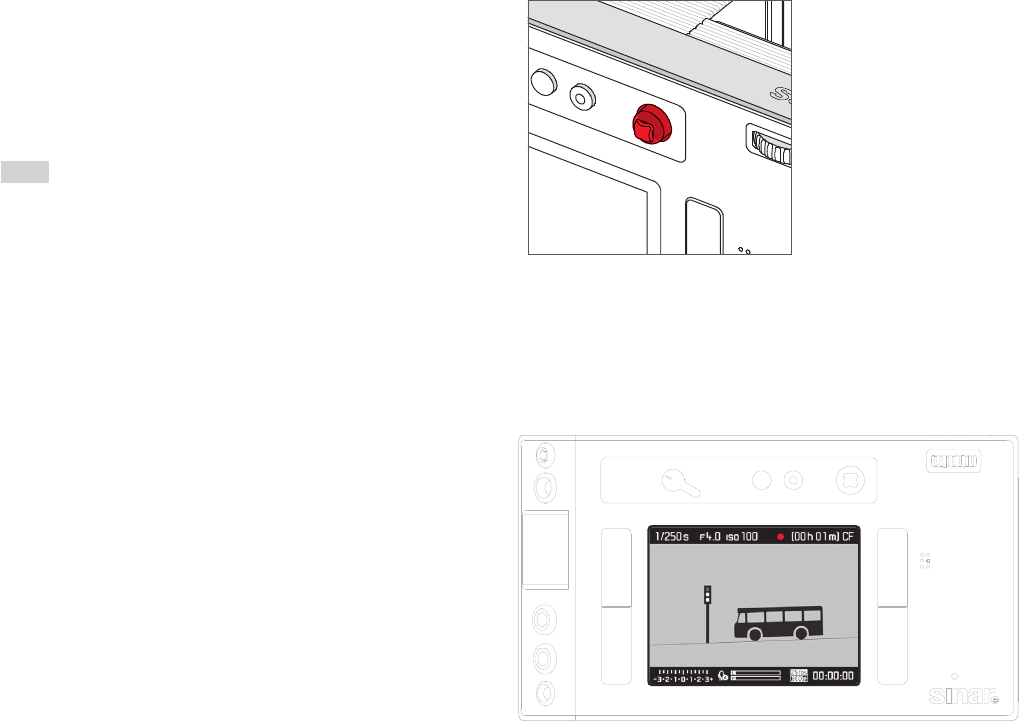
Exposure metering methods
All the variants described on page 30
Exposure modes
• Aperture priority (not available with Sinar eShutter and Copal-shut-
ter see p. 30-31)
• Manual control with shutter speeds of 1⁄30 - 1⁄4000s.
Set slower shutter speeds are dealt with in the same way as 1⁄30s.
Notes:
• If a correct exposure is not possible even with the maximum ap-
erture, the ISO sensitivity is automatically increased, regardless of
any manualsetting.
• The automatic exposure control takes all brightness fluctuations
into consideration. If this is not desired, e.g. for landscape record-
ings and pans, you should set the exposure manually.
Distance setting
All the variants described on page 29
Starting / Ending the recording
Starting:
Press the video record button
• A video recording in progress is indicated in the monitor by a flash-
ing red dot and the elapsed recording time.
• As video recordings with the Sinarback S 30|45 are made with
different aspect ratios, depending on the selected resolution, the
monitor image appears with corresponding masking.
Ending:
Press the video record button again
Single pictures during video recordings
Single pictures can be taken during a running video recording.
Pressing the shutter button interrupts the video recording for the
duration of the single picture. The individual pictures are taken with
the relevant settings on the camera.
3 — Changing the battery

Sound recording
The sound can be recorded using the integral microphones or with
external microphones connected using the LEMO® audio adapter
supplied. The integral microphones record in stereo.
Note:
The automatic distance setting (autofocus) generates noises that are
also recorded.
Setting the audio recording level is possible automatically or manu-
ally before or during the recording.
1. In the menu, under IMAGE, select the item Video Settings,
2. select Audio Level in the sub-menu, and
3. set the desired function there
Manual setting
1. Hold the depth of field preview/function button depressed, and
2. press the Joystick to the left (= decrease level) or right (= increase
level)
The level should be set so that input override is avoided, i.e. such
that the
‘bars’ do not or only seldom change from white to red (at the far right
end of the scale).
Note:
The level is not controlled separately for each channel.
Deactivate sound recording
Move the setting mark completely to the left until the microphone
symbol changes from to
To reduce any noise caused by wind during sound recording, a
damping function is available.
1. In the menu, under IMAGE, select the item Video Settings,
2. select Audio Wind Elimination in the sub-menu, and
3. activate or deactivate the function there
Note:
When no wind noise is to be feared, you should always select Off to
ensure optimum sound.
Microphone ( = Automatic recording level control, = Manual
recording level control, = No sound recording)
Setting mark
Left channel level
Right channel level
Checking the sound recording
You can check your recording level even during the recording using
connected headphones.
1. Connect the headphones to the camera via the LEMO® audio jack
using the audio adapter S (supplied)
• The corresponding display appears in the monitor image
Symbol for connected headphones
Volume bar
Setting headphone volume
2. Hold the depth of fi eld preview/function button depressed, and
3. press the Joystick down (= reduce volume) or up (= increase vol-
ume).
3 — The menu control
1
2
3
4
1
2
1 2
3
4
1
2

Review for unlimited time
Setting the function
Call up Review mode by briefly pressing the button to the top right of
the monitor.
• The last picture taken appears in the monitor along with the corre-
sponding displays. However, if the memory card(s) inserted do(es)
not contain any image files, the following message appears when
you switch to review mode: No media file to display.
Displays in Review mode
For undisturbed viewing of the recordings, only the following are
displayed during review for unlimited time:
• In the header some fundamental information
• The functions of the adjacent buttons for 3 seconds in the four cor-
ners of the monitor picture when switched on: = Protect menu,
= Change of display, = Delete menu and = Menu
• Top right and for the functions of the two thumbwheels
• Bottom right for button lock (if activated)
If the memory card or the selected file cannot be read, a corre-
sponding symbol appears in the right-hand margin of the black
picture.
Notes:
• From Auto Review mode, you can switch back at any time to normal
unlimited PLAY review mode.
• Even pictures that have not yet been transferred from the camera’s
internal buffer memory to a card – the LED at bottom right on the
rear of the camera is still flashing – can be viewed immediately.
• On the other hand, the pictures on the cards are not accessible
while data are being transferred.
• If the masking function was used during recording (see p. 28), the
photo appears with the selected aspect ratio.
• Only picture data recorded with Sinarback S 30|45 cameras can
Review mode
Note:
Two functions are available for the review of your recordings:
• Automatic review after each recording
• Review for unlimited time
Automatic review of last
Picture
In Auto Review mode, each picture is displayed on the monitor im-
mediately after it is taken. You can set the time for which the picture
is to be displayed.
Setting the function
1. In the menu, under SETUP , select the item Auto Review and
2. select the desired function or time in the sub-menu: (Off, 1 s, 3 s, 5
s, Hold)
be reviewed with the Sinarback S 30|45.
• If the picture data are stored in parallel in JPEG and DNG format,
the picture displayed is always based on the DNG file.
• If photographs were taken with the picture series function or auto-
matic bracketing, the last picture in the series is shown first in both
review modes.
• To select other pictures from the series, see p. 48.
Video playback
A video recording can be recognized from the following characteris-
tics:
• Picture format (16:9 with Full HD, approx. 17:9 with 4K)
• Additional video-related information in a footer
• A field with the video and audio control symbols when switching on
and each time the Joystick is pressed to the left:
Louder = Press up
Fast forward = Press right
Play/Pause = Press forward
Quieter = Press down
Fast rewind = Press left
Fast forward and fast rewind start in slow motion and get faster the
longer the button is held down in the appropriate direction.
Turning the rear thumbwheel once to the left or right takes you di-
rectly to the beginning or end of a video.
3 — Changing the battery
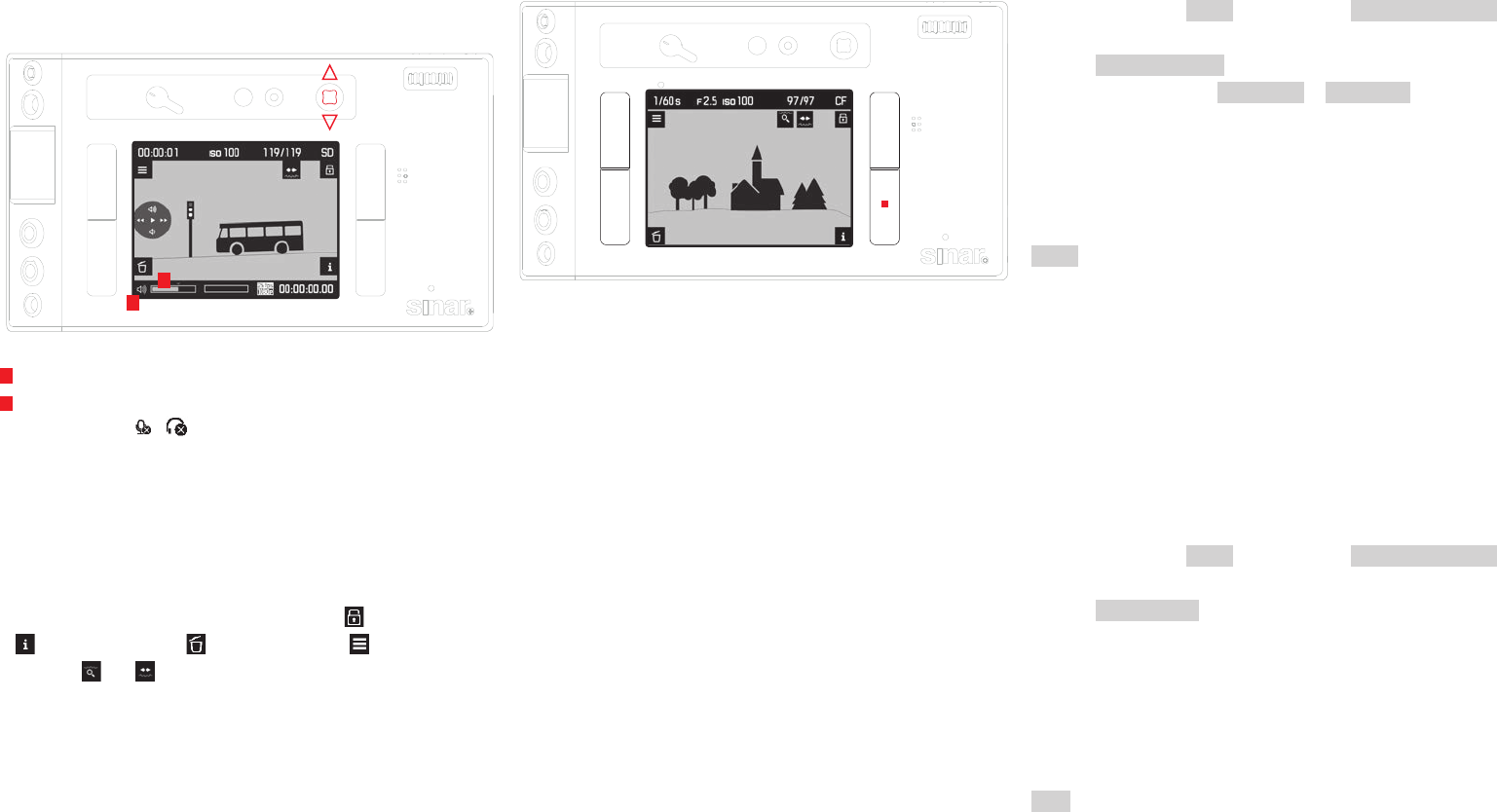
Setting the volume
Press the Joystick down (= reduce volume) or up (= increase volume)
Symbol for camera loudspeaker/connected headphones
Volume bar; at the far left-hand end of the bar the audio playback
is deactivated ( / ).
Displays in Review mode
For undisturbed viewing of the recordings, only the following are
displayed during review for unlimited time:
• In the header some fundamental information
• The functions of the adjacent buttons for 3 seconds in the four cor-
ners of the monitor picture when switched on: = Protect menu,
= Change of display, = Delete menu and = Menu
• Top right and for the functions of the two thumbwheels
If the memory card or the selected fi le cannot be read, a corre-
sponding
symbol appears in the right-hand margin of the black picture.
During both the unlimited review and the video payback, various ad-
ditional displays and information can be called up in turn, in addition
to the displays described above, by repeatedly pressing the button
bottom right next to the monitor as in Live View mode:
• Histogram and clipping indicators
• Grid lines and horizon
• Extended picture data
• Back to the normal view
The settings for grid lines, histogram and marking of clearly focused
subjects are made in exactly the same was as described for Live
View mode on pages 27-28.
Review with histogram and clipping indicators
• Also displayed are:
• The histogram at top left
• Areas that are too bright are marked in red, areas that are too
dark in blue, fl ashing in each case, and at bottom right the clip-
ping symbol ([ ]
The clipping displays
You can use the menu to set the clipping thresholds for displaying
both the light and dark areas.
Setting the function
1. In the menu, under SETUP, select the item Capture Assistants
and
2. select Exposure Clipping in the sub-menu.
3. In the sub-menu select Lower Limit or Upper Limit, and
4. set the desired threshold values on the scale by turning the
thumbwheel or by pressing the Joystick to the left or right.
• The scale shows the clipping areas relative to the overall expo-
sure range.
Notes:
• The histogram and the clipping indicators are available both during
review of the whole picture and during review of a detail, but not
• during the simultaneous review of 4 or 9 reduced pictures.
• The histogram and clipping indicators always relate to the detail of
the part of the picture currently being displayed.
Marking of clearly focused subjects
• All clearly focused subjects are marked by highlighted contours.
The four available colors permit adaptation to any background.
1. In the menu, under SETUP, select the item Capture Assistants
and
2. select Focus Peaking in the sub-menu
3. Call up the sub-menu, and
4. select the desired color there
Extended picture data
• A wide variety of additional picture data is displayed.
Note:
This review option only allows you to view the entire picture, even if
only a section was previously selected.
3 — The menu control
1
2
1
2

Viewing other pictures / scrolling Enlarging the detail
Turning the rear thumbwheel allows you to select other pictures.
Turning to the left takes you to the pictures with lower numbers,
turning to the right to the pictures with higher numbers. After reach-
ing the highest and lowest numbers, the series of the pictures ar-
ranged in an endless loop starts again from the beginning so that
you can reach all the pictures in both directions.
• The picture and fi le numbers in the monitor change accordingly.
Note:
This is possible in all review modes, at all zoom levels, including off
-center details, and during the simultaneous review of several re-
duced pictures.
You can enlarge a detail of the picture
• in steps
or
• call up the highest possible enlargement in one step.
Enlarging in steps
The displayed detail can be enlarged by turning the shutter speed
setting dial to the right. The further you turn, the greater the enlarge-
ment and the smaller the detail. Enlargement is possible in 4 steps
until 1 pixel of the monitor displays 1 pixel of the picture.
• The displays in the header and the symbols for the functions of the
keys and thumbwheels disappear. The rectangle inside the frame
shows the size and position of the detail.
Maximum enlargement in one step
Holding the rear thumbwheel depressed (≥ 1 s) switches between the
review of the whole picture and maximum enlargement.
Note:
The function is available at all zoom levels. If a detail was previously
displayed, pressing the first time displays the whole picture again.
3 — Changing the battery
1
2
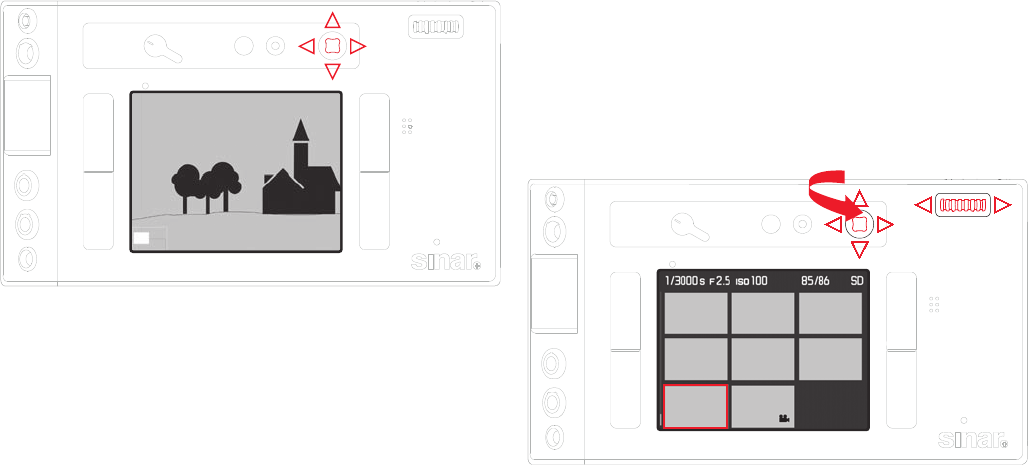
Moving the detail
Press the Joystick in the desired direction - up, down, right or left
• The rectangle inside the frame moves in the direction the Joystick
is pressed.
Selection of one of the reduced pictures
1. Select the desired picture by pressing the Joystick up, down, left
or right
• The frame changes to an endless loop in lines from picture to
picture.
2. The framed picture can be enlarged in steps by turning the shutter
speed setting dial to the right
3 — The menu control

Protecting pictures / clearing delete protection
1. Press any of the button top or bottom left, or top or bottom right of
the monitor
• In the image field the button functions valid in this situation are
displayed - for 4 s – alongside the corresponding buttons (Call
up menu control), (Call up delete menu), (Call up protect
menu) and (Change view, see p. 47)
2. Press the button marked in this case
• The image field displays:
• The button functions valid in this situation ALL, Back, and OK,
and Protect single? in the footer
• Possibly the symbol ( ) for a delete-protected picture.
3. With the button top left of the monitor, select whether you wish to
protect only the displayed picture or all the pictures, or (if one or
more pictures is/are already protected) whether you wish to cancel
the delete protection for the displayed picture or all the pictures
• The corresponding displays change: Alongside the button be-
tween ALL and SINGLE, in the footer according to the situation.
Notes:
• Even when protection or canceling of the delete protection of indi-
vidual pictures is activated, you can enlarge the picture or call up
other pictures.
• Pressing the button marked BACK in this case (see above under 2.)
returns you to the respective normal view.
4. Press the OK button to protect the picture(s) or to cancel the delete
protection.
• The symbol for a delete-protected picture appears or disap-
pears in the monitor.
Deleting pictures
1. Press any of the button top or bottom left, or top or bottom right of
the monitor
• In the image field the button functions valid in this situation are
displayed - for 4 s – alongside the corresponding buttons (Call
up menu control), (Call up delete menu), (Call up protect
menu) and (Change view, see p. 47)
2. Press the button marked in this case
• The image field displays
• the button functions valid in this situation ALL, BACK, and OK,
and Delete single? in the footer.
• Possibly the symbol for a delete-protected picture.
3. With the button top left of the monitor, select whether you wish to
delete only the displayed picture or all the pictures
• The corresponding displays change: Alongside the button be-
tween ALL and SINGLE, in the footer according to the situation.
Notes:
• When deletion is activated, you can enlarge the picture or call up
other pictures.
• Pressing the button marked BACK in this case (see above under 2.)
returns you to the respective normal view.
If only one picture is to be deleted
4. Press the OK button to delete the picture(s).
• The next undeleted picture appears in the monitor. If this was the
only picture a message is displayed: No media file to display
If all pictures are to be deleted
5. Press the button marked OK in this case.
• A safety confirmation prompt appears on the monitor: Delete all?
Notes:
• Pressing the button marked in this case (see above under 2.)
returns you to the respective normal view.
• Protected pictures are not deleted. After deletion, the last (highest
number) of the undeleted pictures appears.
6. Confirm and start the deletion with the OK button.
• A message appears in the monitor: No media file to display.
3 — Changing the battery

Additional functions
Transferring data to a computer
The Sinarback S 30|45 is equipped with a USB 3.0 interface for
transferring data to a computer. This allows fast data transfer to com-
puters with the same kind of interface. The computer used must ei-
ther have a USB port (for direct connection of the Sinarback S 30|45
), or be equipped with a card reader for CF or SD/SDHC/SDXC cards.
Furthermore, an up-to-date USB 3.0 driver must be installed.
If the Sinarback S 30|45 is connected to the computer with the
LEMO® USB 3.0 cable, it is automatically recognized by the oper-
ating system. Use the Windows® Explorer to copy/save the picture
data to your computer.
Note:
Apple® Mac® computers allow the transfer of video files only up to a
maximum file size of 4 GB. If larger video files are copied, an error
message is displayed.
Important:
• Use only the LEMO® USB cable supplied.
• While data is being transferred from the Sinarback S 30|45 to the
computer, the connection may not under any circumstances be
broken by removing the USB cable, as otherwise the computer and/
or the Sinarback S 30|45 may crash, and the memory card may
even be irreparably damaged.
• While data is being transferred from the Sinarback S 30|45 to the
computer, the camera must not be turned off or turn itself off due to
a lack of battery capacity, as otherwise the computer can crash. For
the same reason the battery must never be removed from the cam-
era while the connection is active. If the battery capacity is about to
run out during data
transfer, stop the data transfer, turn off the camera (see p. 15) and
charge the battery (see p. 8).
Connecting and transferring the data using card scanners
The picture data can be transferred to a computer using a commer-
cially
available card scanner for CF or SD/SDHC/SDXC memory cards.
These
devices, as well as further information, can be obtained in a comput-
er
accessories store.
Data structure on the memory card
The 100SINAR, 101SINAR, etc. folders can each hold up to 9999
pictures.
Installing firmware updates
Sinar Photography AG is constantly working on developing and
optimizing its products. As digital camera backs have many func-
tions that are purely controlled electronically, some of these im-
provements and enhancements to the functions can be installed
on the camera at a later date. Leica Sinar Photography AG provides
firmware updates at irregular intervals for this purpose. Information
about any resulting changes or additions to the details in this manual
can be found on www.sinar.ch/download
You can check in the sub-menu of menu item Camera Information
whether your camera and/or the attached lens has the latest firm-
ware
version (see also pp. 16-19 and 66).
You can easily download new firmware yourself from our
website and install it on your camera.
1. Format a memory card in your Sinarback S 30|45
2. Switch off the camera and insert the card into a card reader – ei-
ther integrated or connected to your computer. (A card reader is
required for firmware updates)
3. Download the firmware file under the link:
4. Save the firmware file to the highest level of the card folder struc-
ture.
5. Eject the card properly from your card reader, insert it into the
camera and close the cover.
6. Turn on the camera
7. In the menu, under SETUP, select the item Camera Information
• If the digital camera back detects a newer firmware version than
the one installed, this will be indicated in the respective line by
characters in front of and behind the firmware number.
8. Open the corresponding sub-menu
• Apart from the two version numbers, the sub-menu contains a
confirmation prompt.
9. Start the update with Ye s or reject with No
• A progress screen appears during the process.
• The update process begins. This can take several minutes.
• After a successful update, a corresponding message is dis-
played for confirmation.
Note:
If the battery is not charged sufficiently, a corresponding warning
message is displayed.
3 — The menu control
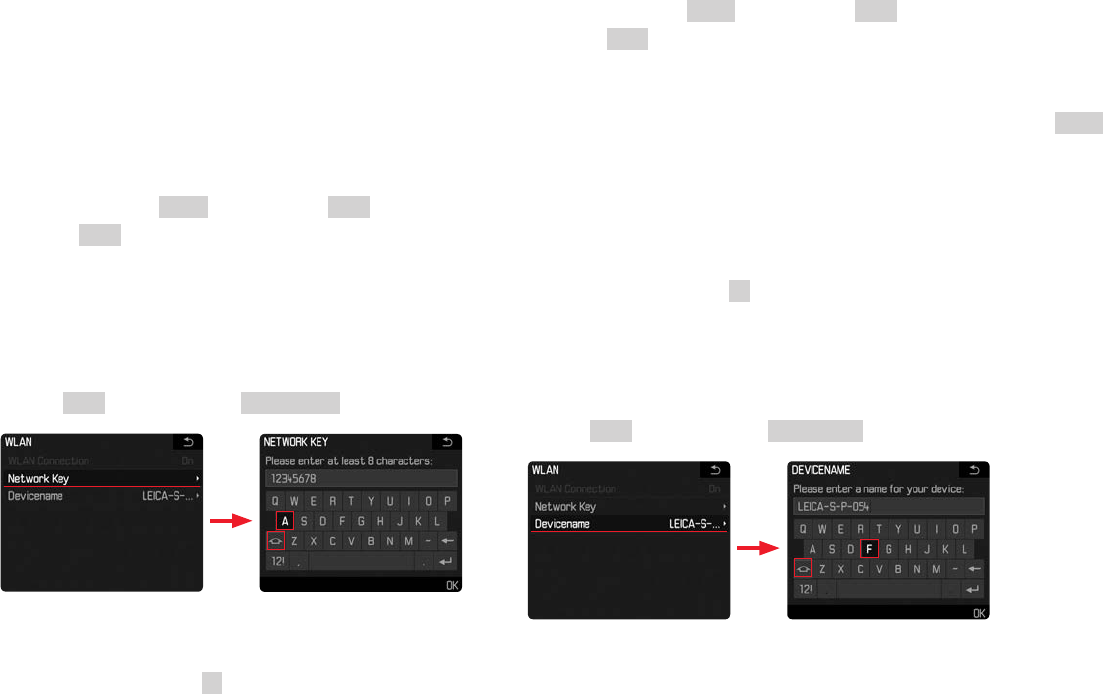
Wireless data transmission and remote control of the camera
You can control the camera remotely using a smartphone/tablet or
use the smartphone/tablet as an external storage medium. In order
to do this, the Sinarback S 30|45 app must first be installed on your
smartphone. This app is available in the Apple App Store™ for iOS™
devices.
WLAN settings
1. In the menu, under SETUP, select the item WLAN and
2. activate WLAN Connection in the sub-menu
Create personal password
For security reasons you should change the default password for the
connection to your Sinarback S 30|45 . The data are encrypted with
the WPA2 standard during the data transfer.
1. In the WLAN sub-menu, select Network Key
2. Enter the characters for your personalized password using the
Joystick or the rear thumbwheel
3. Press the button marked OK
Wireless data transmission and remote control of the digital
camera back
You can control the camera remotely using a smartphone/tablet or
use the smartphone/tablet as an external storage medium. In order
to do this, the Sinarback S 30|45 app must first be installed on your
smartphone. This app is available in the Apple App Store™ for iOS™
devices.
WLAN settings
1. In the menu, under SETUP, select the item WLAN and
2. activate WLAN Connection in the sub-menu
Create personal password
For security reasons you should change the default password for the
connection to your Sinarback S 30|45 . The data are encrypted with
the WPA2 standard during the data transfer.
1. In the WLAN sub-menu, select Network Key
2. Enter the characters for your personalized password using the
Joystick or the rear thumbwheel
3. Press the button marked OK
Change device name (SSID)
You can change the device name (SSID) of the digital camera back. A
name has already been assigned here at the factory (SINAR 30|45).
1. In the WLAN sub-menu, select Device Name
2. Enter the characters for your personalized device name using the
Joystick or the rear thumbwheel
3. Press the button marked OK
Create connection to the camera
(Settings are made at the smartphone/tablet)
1. Select the camera from the list of available WLAN networks
2. Enter the camera password
Data transfer and remote control
1. Start the app on your smartphone/tablet
2. Create connection to the camera
3. Execute the desired function using the app
Notes:
• When using devices or computing systems that require more re-
liable security than WLAN devices, appropriate measures must
be taken to ensure security and protect against disruptions to the
systems used.
• Sinar Photography AG accepts no liability for damage arising from
the use of the camera for purposes other than as a WLAN device.
• It is assumed that the WLAN function will be used in the countries
where this camera is sold. If used in other countries than the one
where the camera is sold, there is the risk that communications
transmission conditions may be violated. Sinar Photography AG
assumes no responsibility for violations of this kind.
• Please also notice that data transmitted and received wirelessly
may be intercepted by third parties. We highly recommend that you
activate encryption in the wireless access point settings in order to
ensure that the information is secure.
• Don’t use the camera in places where there are magnetic fields,
static electricity, or disturbances, such as near microwaves. Other-
wise the wireless transmissions may not reach the camera.
• Using the camera near devices such as microwaves or cordless
telephones that use the 2.4 GHz radio frequency wavelength may
negatively affect the performance of both devices.
• Do not connect to wireless networks you are not authorized to use.
• When the WLAN function is activated, the device will automatically
search for wireless networks. When this happens, networks that
you are not authorized to use (SSID: indicates the name used to
identify a network over a WLAN connection) may be displayed. Do
not attempt to connect to such a network, since this would be seen
as unauthorized access.
3 — Changing the battery

Miscellaneous
Sinar Back S30|45 system accessories
Professional charger S
This charger allows you to significantly boost and safeguard the
availability
of your Sinarback S 30|45 system: It can charge two batteries at the
same time. (Order No. 16 011)
AC adapter S (power pack)
If the Sinarback S 30|45 is used in a fixed position and/or for a very
large number of pictures over a prolonged period, and particularly
when it cannot be monitored, then it is expedient to ensure a contin-
uous power supply by using this power pack. (Order No. 16 041)
Note:
The power pack S (Order No. 16 022) cannot be used with the Sinar-
back S 30|45.
Remote cord S
The electric remote cord S is highly recommended where maximum
jitter-free photography is demanded. (Order No. 16 029)
HDMI cable
The HDMI cable allows exceptionally fast transfer of picture data to
display equipment with corresponding HDMI sockets. Length = 1.5 m
(Order No. 14 491)
Audio adapter S
The audio adapter S that is connected to the camera via LEMO plug
allows the simultaneous connection of headphones and a micro-
phone
(both with 3.5 mm jack). (Order No. 16 042)
Spare parts Order No.
Li-Ion Battery S BP-PRO1 ....................................................................16 039
Quick Charger S (with integrated USA mains plug and
EU, UK and AUS interchangeable mains plugs, car charging cable)
16 009
3 — The menu control
3 — Changing the battery
Precautions and care instructions
General Precautions
Do not use your Sinarback S 30|45 in the immediate vicinity of de-
vices with powerfulmagnetic, electrostatic or electromagnetic fields
(e.g. induction ovens,microwave ovens, television sets or computer
monitors, video gameconsoles, cell phones, radio equipment).
• If you place the Sinarback S 30|45 on or very close to a television
set, its magnetic field could interfere with picture recordings.
• The same applies for use in the vicinity of cell phones.
• Strong magnetic fields, e.g. from speakers or large electric motors,
can damage the stored data or the pictures.
• If the Sinarback S 30|45 malfunctions due to the effects of elec-
troma netic fields then turn the camera off, remove the battery, and
then turn the camera on again after reinserting the battery. Do not
use the Sinarback S 30|45 in the immediate vicinity of radio trans-
mitters or high-voltage power lines.
• Their magnetic fields can also interfere with picture recordings.
Protect the Sinarback S 30|45 from contact with insect sprays and
other aggressive chemicals. Petroleum spirit, thinner and alcohol
may not be used for cleaning.
• Certain chemicals and liquids can damage the housing of the
Sinarback S 30|45 or the surface coating.
• As rubber and plastics sometimes emit aggressive chemicals, they
should not remain in contact with the Sinarback S 30|45 for a long
time. The Sinarback S 30|45 is protected against moisture and
dust to a certain extent by a number of design measures. Ensure
nevertheless that neither water, sand nor dust can get into the
camera, e.g. when it is snowing or raining or on the beach.
• Sand and dust can damage the camera and memory cards. Take
particular care when changing lenses and when inserting and re-
moving the cards. If moisture does get in, it can cause malfunctions
and even permanent damage to the Sinarback S 30|45 and the
memory cards. If salt water spray gets onto the Sinarback S 30|45 ,
wet a soft cloth with tap water, wring it out thoroughly and wipe the
camera with it. Then wipe down thoroughly with a dry cloth.
Monitor
• If the Sinarback S 30|45 is exposed to significant temperature
fluctuations, condensation can form on the displays. Wipe it off
carefully with a soft dry cloth.
• If the Sinarback S 30|45 is very cold when it is turned on, the dis-
plays may at first appear darker than usual. As soon as they warm
up, they will reach their normal level of brightness. The monitor is
manufactured using a high-precision process. This ensures that, of
the total of around 921,600 pixels, more than 99.995% work cor-
rectly and only 0.005% remain dark or are always bright. However,
this is not a malfunction and it does not impair the reproduction of
the picture.
Sensor
Cosmic radiation (e.g. on flights) can cause pixel defects.
Condensation
If condensation has formed on or in the Sinarback S 30|45 , you
should turn it off and leave it to stand at room temperature for around
an hour. Once the camera temperature has adjusted to room tem-
perature, the condensation will disappear by itself.
Care instructions
• As any soiling also represents a growth medium for microorgan-
isms, you should take care to keep the equipment clean.
For the digital camera back
• Clean the Sinarback S 30|45 only with a soft, dry cloth. Stubborn
dirt should first of all be covered with a well-thinned cleaning agent
and then wiped off with a dry cloth.
• To remove stains and fingerprints, the digital camera back should
be wiped with a clean lint-free cloth. Tougher dirt in hard to reach
corners of the camera body can be removed with a small brush.
Take care not to damage the shutter blades and mirror surface, e.g.
with the shaft of the brush.
For the battery
Rechargeable lithium ion batteries generate power through internal
chemical reactions. These reactions are also influenced by the ambi-
ent temperature and humidity. Very high and low temperatures short-
en the operating time and service life of the batteries.
• Always remove the battery if you will not be using the Sinarback S
30|45 for a longer period of time. Otherwise after several weeks
the battery could undergo deep discharge, i.e. the voltage is
sharply reduced, as the Sinarback S 30|45 still consumes a small
amount of current (e.g. for saving date and time) even when it is
turned off.
• Lithium ion batteries should only be stored in a partially charged
condition, i.e. not completely discharged or fully charged (in the
corresponding display in the top panel display). For very long stor-
age periods, you should charge the battery for approx. 15 minutes
roughly twice a year to avoid a deep discharge.
• Always ensure that the battery contacts are clean and freely acces-
sible. Whilst lithium ion batteries are proof against short circuits,
they should still be protected against contact with metal objects
such as paper clips or jewelry. A short-circuited battery can get very
hot and cause severe burns.
• If a battery is dropped, check the casing and the contacts imme-
diately for any damage. Using a damaged battery can damage the
Sinarback S 30|45.
• Batteries have a limited service life.
• Take damaged batteries to a collection point to ensure correct
recycling.
• Never throw batteries into a fire as this can cause them to explode
3 — The menu control

For the charger
• If the charger is used in the vicinity of radio receivers, it can inter-
fere with the reception; make sure there is a distance of at least 1m
between the devices.
• When the charger is in use, it can make a noise (buzzing) – this is
quite normal and is not a malfunction.
• When it is not in use, disconnect the charger from the mains as
otherwise it uses a certain (very small) amount of power even when
no battery is inserted in it.
• Always keep the charger contacts clean, and never short circuit
them.
For memory cards
• Whilst a picture is being stored or the memory card is being read, it
may not be removed, nor may the Sinarback S 30|45 be turned off
or e posed to vibrations.
• For safety, memory cards should only ever be stored in the antistat-
ic cover supplied.
• Do not store memory cards where they will be exposed to high
temper tures, direct sunlight, magnetic fields or static discharge.
• Do not drop or bend memory cards as this can damage them and
result in loss of the stored data.
• Always remove the memory cards if you will not be using the Sinar-
back S 30|45 for a longer period of time.
• Do not touch the connections on the memory card and keep them
free of dirt, dust and moisture.
• It is recommended that the memory cards are reformatted from
time to time, as fragmentation occurs when deleting, which can
block some of the memory capacity.
Cleaning the sensor
If any dust or dirt particles should adhere to the sensor cover glass,
depending on the size of the particles this can be identified by dark
spots or marks on the pictures.
The Sinarback S 30|45 can be returned to Sinar Photography AG
Customer Service (address: see p. xy) for chargeable cleaning of the
sensor; this cleaning is not covered by warranty. You can also carry
out cleaning yourself, using the delivered Sinar Digital Cleaning Kit.
Notes:
• Generally: To protect the Sinarback S 30|45 against ingress of
dust etc. into the interior of the camera, it is important always to
have a cover fitted to the digital back.
• For the same reason, when changing lenses work quickly and in an
environment that is as dust-free as possible.
• As plastic parts can easily pick up a static charge and then attract
more dust, individual lens caps and covers should only be stored
for short periods in pockets in clothing.
Important:
• Sinar Photography AG accepts no liability for damage caused by
the user when cleaning the sensor.
• Do not attempt to blow dust particles off the sensor cover glass
using your mouth; even tiny droplets of saliva can cause marks that
are difficult to remove.
• Compressed air cleaners with high gas pressure may not be used
as they can also cause damage.
• Take care to avoid touching the sensor surface with a hard object
during inspection and cleaning.
Storage
• If you will not be using the Sinarback S 30|45 for a longer period of
time, we recommend that you
a. Switch it off (see p. 15),
b. Remove the memory cards (see p. 12), and
c. Take out the battery (see p. 11), (the entered time and date are lost
after max. 3 months, see p. 20).
• A lens acts like a magnifying glass if bright sunlight shines on the
front of the camera. The camera must therefore never be set aside
in strong sunlight without protection. Using the lens cover and
keeping the camera in the shade (or immediately putting it away in
the case) help to prevent damage to the interior of the camera.
• Store the Sinarback S 30|45 in a dry, adequately ventilated place,
where neither high temperatures nor high humidity will occur. When
used in humid conditions, the Sinarback S 30|45 should be com-
pletely free of all moisture before being stored away.
• Photo cases that became wet during use should be emptied to
prevent damage to your equipment caused by moisture and any
leather-tanning residue released.
• To prevent fungal growth during use in hot, humid tropical climates,
the camera equipment should not be kept in air-tight containers
for longer than absolutely necessary. This is only recommended if a
desiccant such as silica gel is placed in the container
• To prevent the formation of fungus, do not store the Sinarback S
30|45 in a leather case for long periods of time.
• In a dry environment, store the Sinarback S 30|45 preferably in a
closed and padded container so that nothing can rub against it and
it is protected from dust.
• Note the serial numbers of your Sinarback S 30|45 and lenses, as
these are extremely important in case of loss.
3 — Changing the battery
Technical data check – being conform with digital back data
Picture format / aspect ratio 30 x 45mm / 2:3
Image sensor / resolution Leica CMOS sensor with 6 μm pixel size,
with micro lenses, 37.5 MP
Dynamic range 15 aperture stops
Color depth 16 bits per pixel
Deep-pass filter None, maximum transfer of the focus, suppression
of Moiré by external digital image processing on sensor
Data formats Photo: DNG (raw data), DNG + JPEG, JPEG DNG /
JPEG resolution DNG: 37.5 MP, JPEG: 37.5 MP, 9.3 MP, 2.3 MP
File size DNG: approx. 42 Mbyte, JPEG: approx. 1-16 Mbyte (depend-
ing on the resolution used and picture content), Video: Uninterrupted
video recordings are possible up to a maximum length of 29 min-
utes, maximum file size for transfer to MAC computers: 4 GB
Buffer memory 2 GB, maximum number of pictures in series (de-
pending on memory card used): DNG: max. 14, JPEG: unlimited
Color spaces Adobe® RGB, sRGB, ECI RGB 2.0
White balance Automatic, manual by metering, 8 presets, color
temperature input
Storage medium CF cards (max. UDMA7), SD cards up to 2 GB,
SDHC cards up to 32 GB, SDXC cards, memory cards with a capacity
of less than 1 GB cannot be used, 4K video recordings can only be
stored on SD cards
Menu languages English, German, French, Italian, Spanish, Rus-
sian, Japanese, Traditional Chinese, Simplified Chinese, Korean,
Portuguese
Sensitivities ISO100, ISO200, ISO400, ISO800, ISO1600, ISO 3200,
ISO6400, ISO 12500, Automatic
Focusing
Focus detection Using phase detection method, in Live View mode
on the basis of contrast
Monitor 3” color TFT LCD monitor with 16 million colors and 921,600
pixels, approx. 100% image field, max. 170° viewing angle, anti-re-
flex/ anti-soiling protective glass (Corning® Gorilla Glas®), color
space: sRGB
Live View mode Optionally with/without exposure simulation, spot
metering field can be moved in the whole image field, linked to also
freely movable AF metering field, display optionally with histogram
and clipping, marking of clearly focused subjects (focus peaking),
grid lines and horizon indicators, picture information
Video mode
Format, resolution, frame rate, color scanning MOV (Motion
JPEG), optionally Full HD (1080 x 1920) with 24, 25 or 30 fps or 4K
(2160 x 4096) with 24 fps, 4:2:2
Turning the camera on/off With main switch on camera top panel,
optionally auto power off after approx. 2/5/10 minutes
Power supply Rechargeable Li-Ion Battery, rated voltage 7.3 V,
capac- ity 2300 mAh, capacity display in top panel display; charge
current / voltage: DC 1250 mA / 7.4 V. Model number: BP-PRO1;
Manufacturer: PT. VARTA Microbattery Indonesia; Made in Indonesia,
permanent power supply possible using mains power pack (available
as an accessory)
Lithium-Ion Battery Charger Quick Charger S; Inputs: 100-240 V
AC, 50/60Hz, 200 mA, automatic switching, or 12/24 V DC, 1A; Out-
put: Nominal 7.4 V DC, 1250 mA / max. 8.25 V, 1265 mA Model num-
ber: 9C94270; Manufacturer: Ansmann; Made in China
WLAN (802.11n-Standard), Integrated into camera, camera control
and picture monitoring possible with smartphone or tablet app
Operating conditions 0 to +45°C, 15%-80% relative humidity
Interfaces? HDMI socket Type C, LEMO® jack for data output (USB
3.0 standard), 9-pin LEMO® jack for remote control accessory/ re-
mote flash trigger, audio out/in possible with audio adapter (available
as an accessory)
Dimensions (width x depth x height) approx. 160 x 80 x 120 mm
Weight approx. 1260 g (with battery)
3 — The menu control
3 — Changing the battery
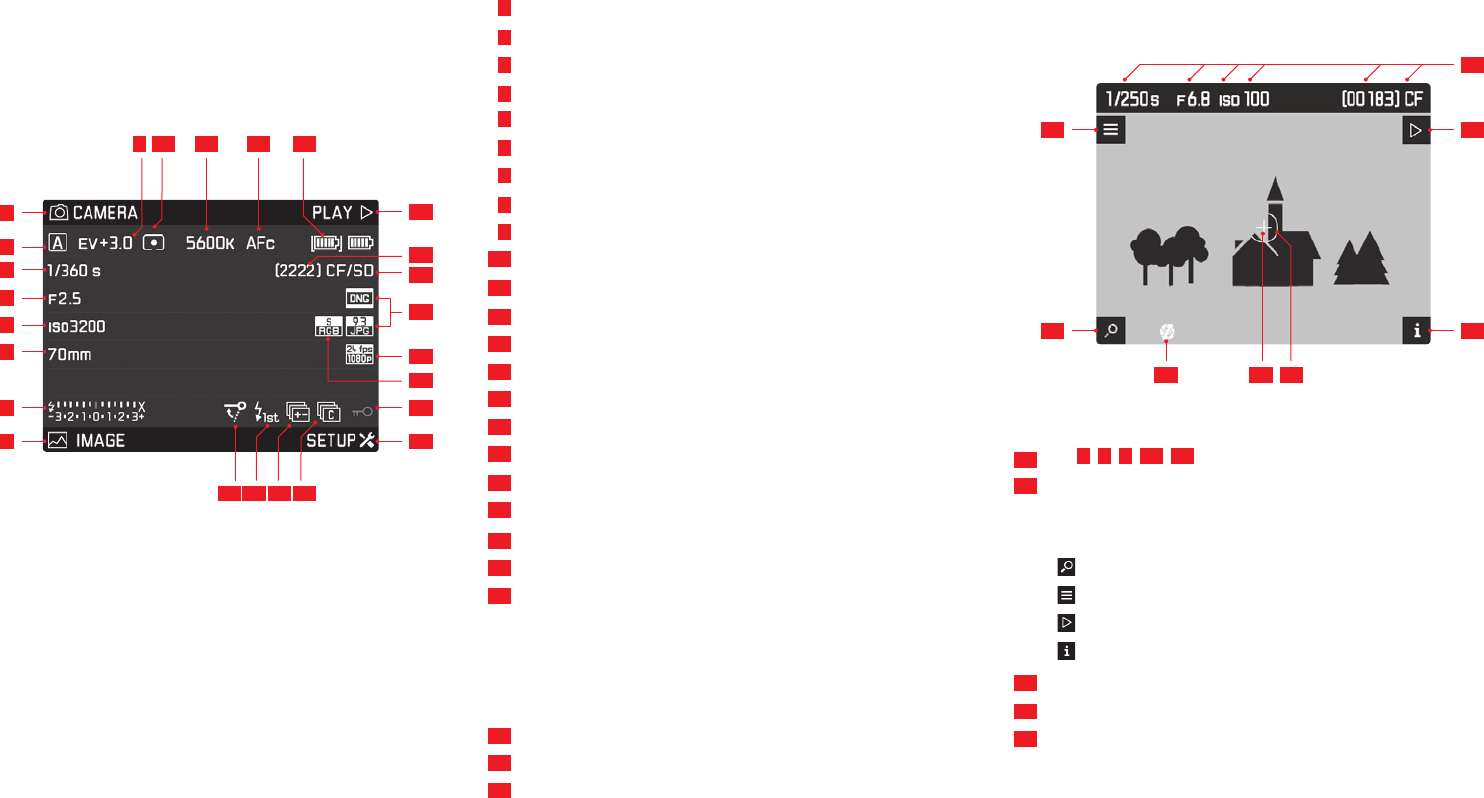
3 — The displays
see 6, 5, 4, 15 , 16
Button functions
(appear – in all Live View screens – for approx. 3 s after pressing
any of the four buttons next to the monitor)
• Magnifi cation function
• Menu control
• Review mode
• Change views
Spot exposure metering field
Autofocus metering field
Exposure simulation deactivated
Function of the button bottom left
Flash ready indicator, light balance, fl ash sync speed indicator
Focal length
ISO sensitivity/setting
Aperture
Shutter speed
Exposure operating mode
Function of the button top left
Exposure compensation
Exposure metering method
White balance setting
Autofocus mode
Battery status / mains mode
Function of the button top right
Picture counter
Memory card(s) used
Photo fi le format / JPEG resolution
Video resolution / frame rate
Color space
Button lock activated
Function of the button bottom right
Symbol for
• Single picture
• Picture series
• Interval shooting
• Self-timer mode
Exposure bracketing activated
Flash trigger point
Mirror lock-up activated
The displays
In the monitor
Photo recording mode
Recording mode Live View photo
Standard view
1
5
3
7
9
2
6
4
8
10
12
14
16
18
20
23
11
13
15
17
19
21
24
22
25
26
26
27
27
2727
27
28
28
29
29
30
30
1
3
7
9
2
4
8
10 12
14
16
18
20
23
11 13
15
17
19
21
24 2225
5
6
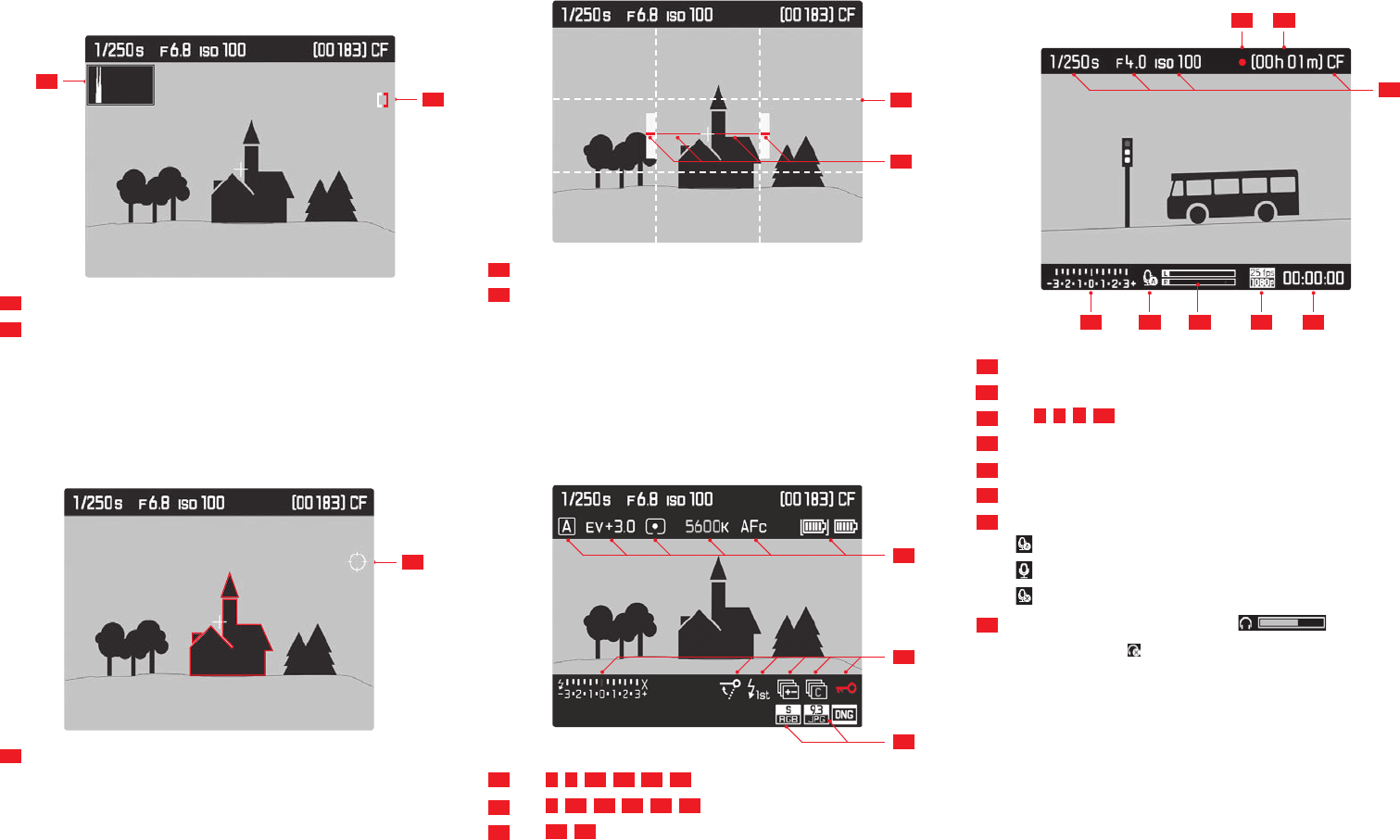
3 — Changing the battery
Standard view plus additional displays
A. Histogram and clipping indicators
C. Grid and horizon Video recording mode
Indication of a recording in progress
Possible recording time
see 6, 5, 4, 16
Current recording time
Video resolution / frame rate
Audio recording level display
Sound recording mode
• Automatic recording level control
• Manual recording level contol
• Sound recording deactivated
Light scale, or headphone volume ,
Volume off (mute)
D. Additional picture data
Histogram
Clipping symbol
B. Focus display (peaking)
Grid lines
Horizon
see 7, 9, 10 , 11 , 12 , 13
see 2, 25 , 24 , 23 , 22 , 20
see 19 , 17
Peaking symbol
31
31
32
32
34
34
35
36
36
37
37
38
40
40
41
41
42
42
43
43
44
44
45
45
46
46
39
39
38
35
33
33
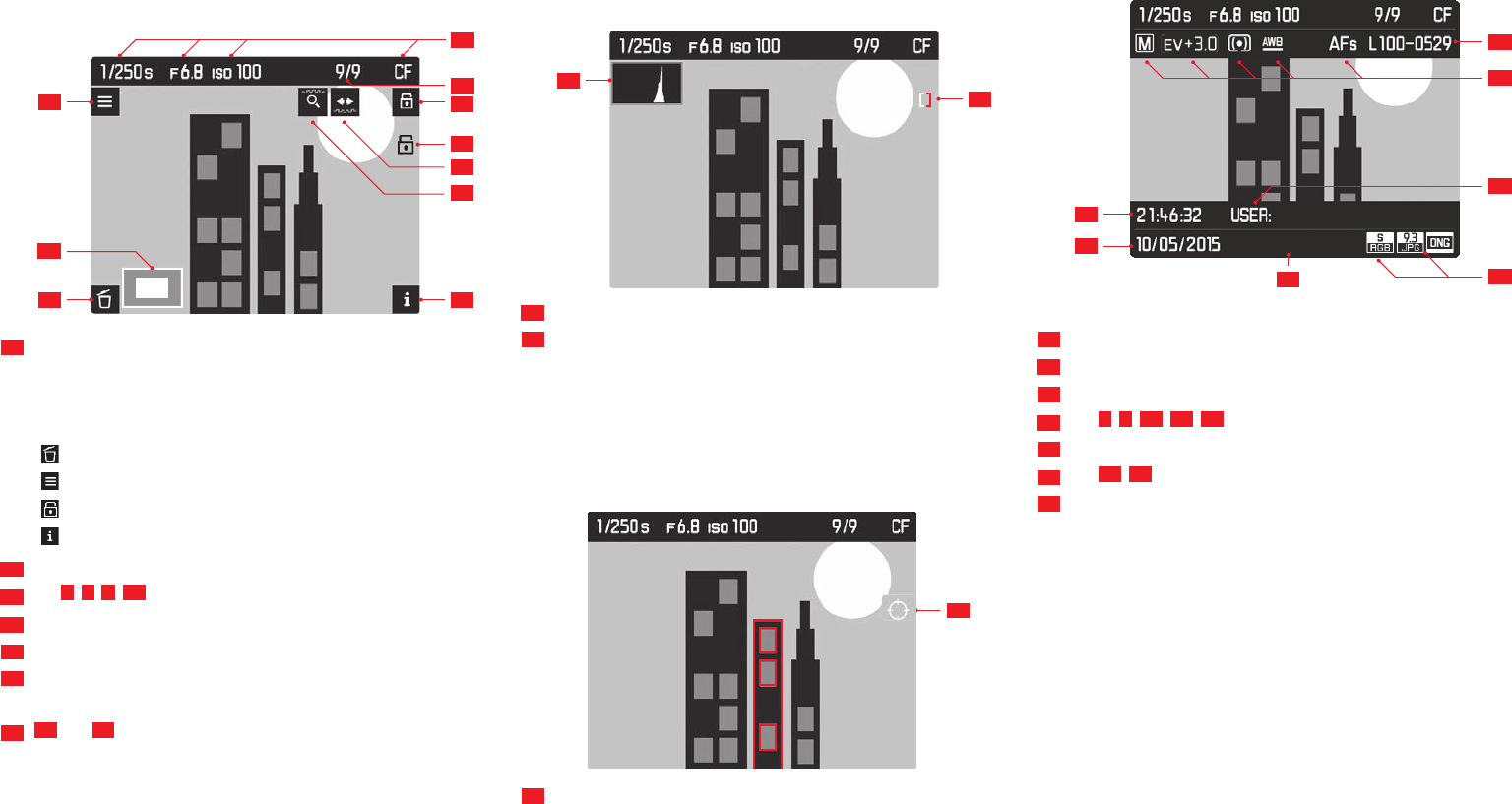
3 — The displays
Photo review mode
Standard view
Standard view plus additional displays
A. Histogram and clipping indicator
2. Histogram
3. Clipping symbol Date of picture
Time of picture
Image fi le number
see 7, 9, 10 , 11 , 12
Profi le memory slot
see 19 , 17
Employed focal length
Peaking symbol
Button functions
(appear when switching on Review mode in all photo and video
views or after pressing any of the four buttons next to the monitor,
disappear after approx. 3 s)
• Delete menu
• Menu control
• Protect menu
• Change views
Detail size and position
see 6, 5, 4, 16
Number of picture displayed / total number of pictures
Symbol for delete-protected pictures
Operating instructions for scroll function (shutter speed setting
dial)
(52 and 53 appear / disappear together with 47)
Operating instructions for enlargement function (rear thumbwheel
48
49
50
51
52
53
55
56
58
58
59
59
60
60
61
61
62
62
63
63
57
57
56
55
54
54
47
48
49
50
51
52
53
47
47 47
47
B. Focus display (peaking)
C. Additional picture data
70mm

3 — Changing the battery
Video review mode
Standard view
Standard view plus additional displays
A. Histogram and clipping indicator
1. Histogram
2. Clipping symbol
see 7, 9, 10 , 11 , 59
see 58 , 61
Peaking symbol
Recording date and volume setting ,
Volume off (mute) , see also 65
Video control symbols (for Joystick)
• Playback (press forward)
• Fast forward (press to right or hold depressed)
• Fast rewind (press to left or hold depressed)
• Volume: louder (press up or hold depressed)
• Volume: quieter (press down or hold depressed)
Total recording time
see 4, 50 , 16
Operating instructions for scroll function (shutter speed setting
dial)
Operating instructions for enlargement function (rear thumbwheel)
Elapsed playback time
Video resolution / frame rate
Elapsed playback time bar
65
66
67
68
70
69
71
72
74
75
75
74
77
77
76
76
73
73
64
B. Focus display (peaking)
C. Additional picture data
65
66
67
68
70
69
71
72
64
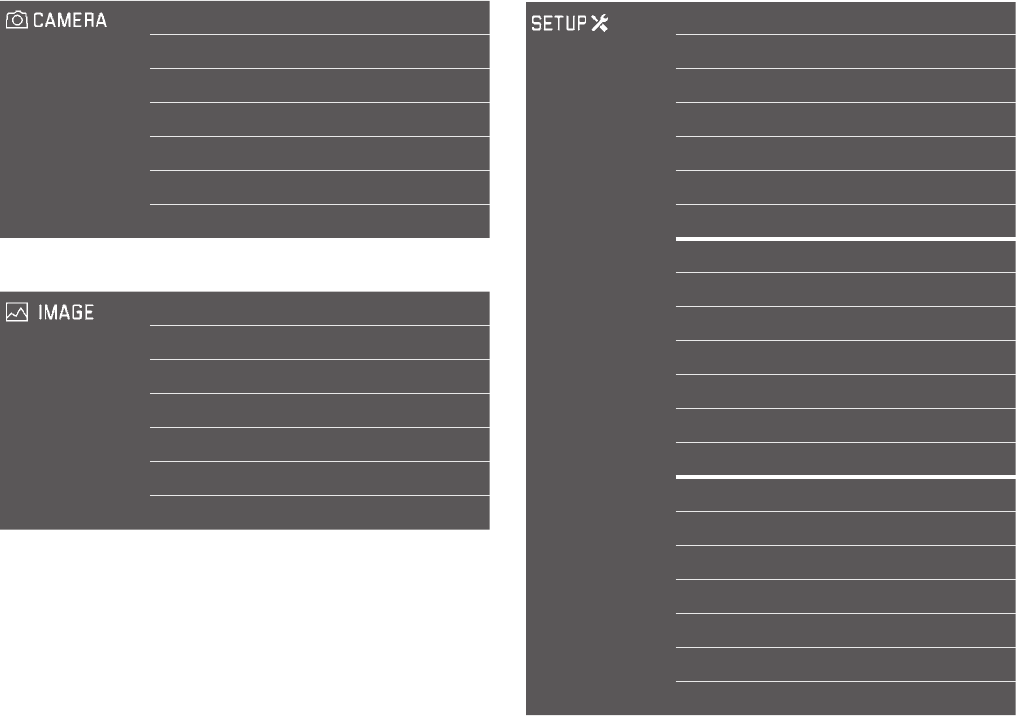
3 — The displays
The menu options Area Menu option Page
Drive mode 26/34
Focus mode 29
Exp. metering 30
Exp. compensation 32
Exp. bracketing 33
Mirror up mode 35
Max. flash sync. time 40
ISO 24
White balance 22
Photo file format 22
JPG resolution 22
JPG settings 22
Video resolution 43
Video setting 43/45
Area Menu option Page
Storage backup (CF & SD) 25
Format cards 37
Image numbering 37
Auto review 46
Capture assistants 27/28/29/47
Copyright information 38
User profiles 36
Auto ISO setup 24
Flash sync. mode 40
Keylock 30
Customize controls 32
Display brightness 21
Acoustic signals 21
Auto power saving 20
WLAN 52
GPS 38
Date & time 20
Language 20
Reset camera 36
Sensor cleaning 55
Camera information 2/51
Sinar product support
The Product Support Department at Sinar Photography AG can
provide you with an answer to any technical questions relating to
Sinar products, including software supplied, either in writing, on
the telephone, or by e-mail. They are also the contact point for
purchasing advice and to order instruction manuals. Alternatively,
you can send us your questions using the contact form on the Sinar
Photography AG homepage.
Sinar Photography AG
Product Support / Software Support
Farbhofstrasse 21
CH-8048 Zürich / Switzerland
Telefon: +41 44 217 80 30
Fax: +41 44 217 80 50
tech@sinar.swiss / contact@sinar.swiss
Sinar customer care
For servicing your Sinar equipment or in the event of damage, the
Sinar Photography AG Customer Care department or the repair
service provided by authorized Sinar agents in your country are
available (visit www.sinar.ch see the warranty card for a list of
addresses).
Sinar Photography AG
Product Support / Software Support
Farbhofstrasse 21
CH-8048 Zürich / Switzerland
Telefon: +41 44 217 80 30
Fax: +41 44 217 80 50
tech@sinar.swiss / contact@sinar.swiss